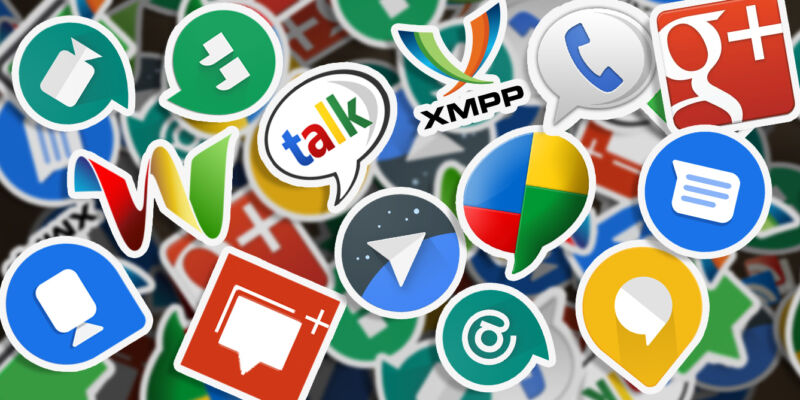
Google Talk, Google's first-ever instant messaging platform, launched on August 24, 2005. This company has been in the messaging business for 16 years, meaning Google has been making messaging clients for longer than some of its rivals have existed. But thanks to a decade and a half of nearly constant strategy changes, competing product launches, and internal sabotage, you can't say Google has a dominant or even stable instant messaging platform today.
Google's 16 years of messenger wheel-spinning has allowed products from more focused companies to pass it by. Embarrassingly, nearly all of these products are much younger than Google's messaging efforts. Consider competitors like WhatsApp (12 years old), Facebook Messenger (nine years old), iMessage (nine years old), and Slack (eight years old)—Google Talk even had video chat four years before Zoom was a thing.
Currently, you would probably rank Google's offerings behind every other big-tech competitor. A lack of any kind of top-down messaging leadership at Google has led to a decade and a half of messaging purgatory, with Google both unable to leave the space altogether and unable to commit to a single product. While companies like Facebook and Salesforce invest tens of billions of dollars into a lone messaging app, Google seems content only to spin up an innumerable number of under-funded, unstable side projects led by job-hopping project managers. There have been periods when Google briefly produced a good messaging solution, but the constant shutdowns, focus-shifting, and sabotage of established products have stopped Google from carrying much of these user bases—or user goodwill—forward into the present day.
Because no single company has ever failed at something this badly, for this long, with this many different products (and because it has barely been a month since the rollout of Google Chat), the time has come to outline the history of Google messaging. Prepare yourselves, dear readers, for a non-stop rollercoaster of new product launches, neglected established products, unexpected shut-downs, and legions of confused, frustrated, and exiled users.
Table of Contents
- Google Talk (2005)—Google's first chat service, built on open protocols
- Google Talk ran Android's entire push notification system
- The slow death of GTalk
- Google Voice (2009)—SMS and Phone calls get a dose of the Internet
- Google Wave (2009)—An email killer from the future
- Nobody knew what Wave was for or how to use it
- Google Buzz (2010)—The non-consensual social network
- Slide’s Disco (2011)—An independent app escapes the Googleplex
- The Google+ Era (2011)—Google's social panic
- Google+ Hangouts video chat—The first Hangouts
- Google+ Huddle/Messenger—I guess we should have some kind of DM function
- A competitor emerges—iMessage has entered the chat
- One more competitor—WhatsApp is now worth $22 billion
- Google Docs Editor Chat (2013)—Just like Gmail chat, but not integrated with anything
- Google Hangouts (2013)—Google's greatest messaging service
- The death of Hangouts, unified Google messaging, and hope
- Google Spaces (2016)—A messaging app for Google I/O 2016 attendees
- Google Allo (2016)—Google's dead-on-arrival WhatsApp clone
- Allo's legacy: The Google Assistant
- Google Duo (2016)—A video companion app for... WhatsApp?
- Google (Hangouts) Meet (2017)—Not Zoom
- YouTube Messages (2017)—Yes, this was really a thing
- Google (Hangouts) Chat (2018)—Part 1: Cloning Slack is actually a good idea
- Google Maps Messages (2018)—Business messaging, now with the instability of Google
- Google & RCS (2019)—So we found this dusty old messaging standard in a closet...
- RCS is bad, and anyone who likes it should feel bad
- Google Photos Messages (2019)—You get a messaging feature! And YOU! And you!
- Google Stadia Messages (2020)—Two great tastes that taste great together
- Google Pay Messages (2021)—We actually learned nothing from Google Allo
- Google Assistant Messages (2021)—Text and voice chat, for families?
- Google Phone Messaging (2021)—Isn't this going a little too far?
- Google Chat, Part 2 (2021)—No wait, this is actually a consumer app now!
- Is anyone in charge at Google?
Google Talk (2005)—Google's first chat service, built on open protocols
Lifetime: August 24, 2005-June 26, 2017 (12 years, until a Hangouts merger in 2013)
Clients: Windows, Android, the web, Gmail, Blackberry, iPhone, iGoogle, Orkut, any XMPP client
 The Windows Google Talk client. Let the wave of nostalgia wash over you.Google
The Windows Google Talk client. Let the wave of nostalgia wash over you.Google Google Talk in Gmail.Google
Google Talk in Gmail.Google By 2008, you could do video chat.https://www.youtube.com/watch?v=JFGJRfoK9xQ
By 2008, you could do video chat.https://www.youtube.com/watch?v=JFGJRfoK9xQ Who could forget the best Google Talk feature, "Show current music track," which would pipe your Winamp or Windows Media Player song titles into the chat status?
Who could forget the best Google Talk feature, "Show current music track," which would pipe your Winamp or Windows Media Player song titles into the chat status?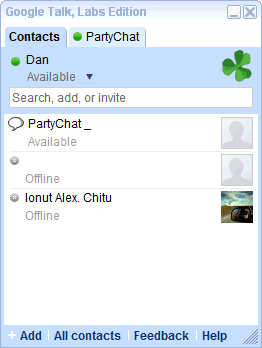 Also in 2008, there was a Google Talk "Labs Edition" for Windows, an alternative client.
Also in 2008, there was a Google Talk "Labs Edition" for Windows, an alternative client. The early Android client.Ron Amadeo
The early Android client.Ron Amadeo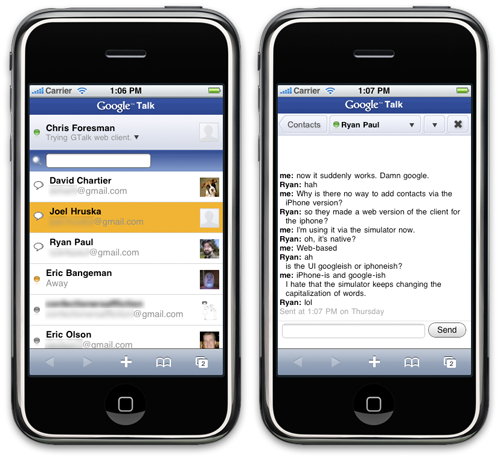 The Google Talk mobile website for iPhones. (The app store had not been invented yet.)Google
The Google Talk mobile website for iPhones. (The app store had not been invented yet.)Google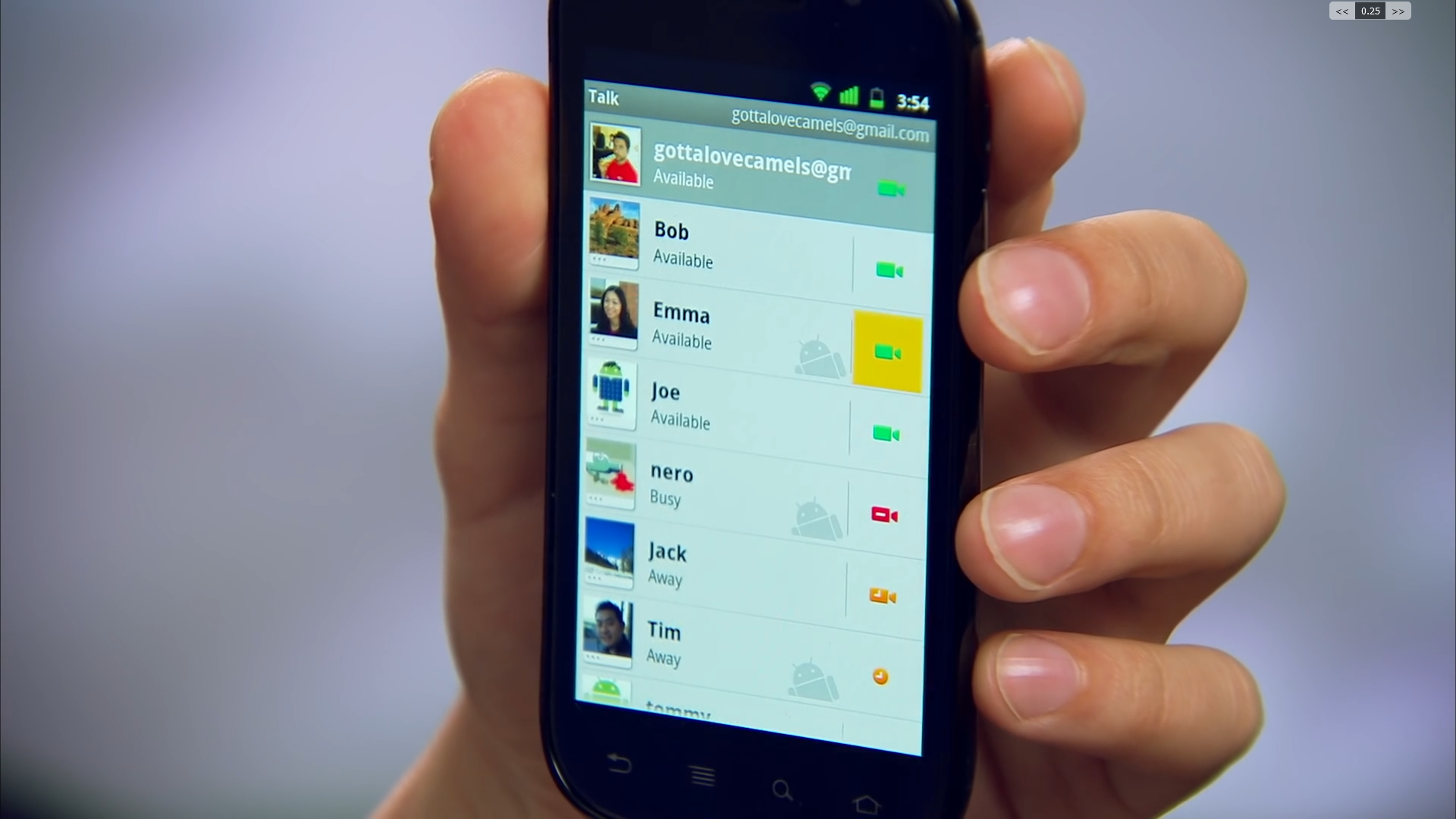 The Android 2.3 Gingerbread version of Google Talk from 2011, now with mobile video chat!
The Android 2.3 Gingerbread version of Google Talk from 2011, now with mobile video chat!
In the beginning, there was Google Talk, and things were good. Google's first messaging service (which often got the unofficial nickname "GChat") was also one of its best. It boasted a wide range of platform support, a long shelf life, and useful integration in a number of other Google products. Google Talk was part of the second big wave of popular instant messaging apps, and it seemed primed to take on the 1990's stalwarts of instant messaging like AOL Instant Messenger (AIM), ICQ, Yahoo Messenger, and Windows Live Messenger.
So much about Google Talk's life and design sounds like it was created by a totally different company from the Google that exists today. The original vision for Google Talk was about openness and "enabling user choice." Google wanted instant messaging to work like email, where different service providers and clients could all talk to each other over a single standard (wouldn't that have been nice?). That standard was XMPP, or the "Extensible Messaging and Presence Protocol," an open source communication protocol used for passing around chat messages, presence information, contacts, and more. Google pledged to federate (or allow cross-communication) with any other chat service supporting the standard. You could also punch the right settings into any XMPP-compatible third-party client and talk to your Google Talk friends.Because Ars Technica is a Very Old Website, you can still read a day-one, 2005 Google Talk review right here from Ars Editor-in-Chief Ken Fisher (can you believe Ken used to write articles?). Back then, Ken called day-one Google Talk "the Stone Age of instant messaging," citing a severe lack of features like file sharing, chat logs, group chat, or emoticons. There was one supported platform at launch: Microsoft Windows. That was mostly fine in 2005 when Windows had something like a 97 percent market share. Even then, XMPP support meant that you could still get online with the other 3 percent of operating systems by using a ton of third-party clients.
There will be a few recurring themes in this exhaustive history, and one of them is Google's penchant for launching things in a "Minimum Viable Product" (MVP) state. MVP is Silicon Valley project manager lingo for launching with the absolute bare minimum of features, getting feedback from the public quickly, and letting that feedback determine the future of the product. The idea is that it's cheaper, easier, and less risky than developing a fully featured product in a bubble, since such a product might miss the mark with the public despite all the work. The downside to an MVP launch is that your product gets the most attention and news coverage when it is brand new, and you're often giving a bad first impression. In a competitive landscape, there's a chance the public will check out your bare-bones creation, declare it to be hopeless, and forget about it.
Google does MVP launches all the time, and with Google Talk, that meant launching with the ability to send messages, do voice chat, and little else. Later we'll cover some of Google's dead-on-arrival MVP launches, but 2005 was a different era. Many people saw Google Talk's bare-bones interface and features as a positive thing. In the era of AOL Instant Messenger, IM clients were noisy, flashy billboards with a million features and dedicated UI space for banner ads. A 2006 post from the Google Operating System blog sums up the differences well with installer file sizes, which is an interesting benchmark metric. Yahoo Messenger was 9.5MB. Windows Live Messenger was 15.3MB. Google Talk was a lean, mean 1.45MB.
While the AOL-style kitchen sink design was horrible, it also solved a key problem that will hang over Google's efforts: "How does a messaging service make money?" Back in the AIM days, that was answered with a literal banner ad in the UI. Every AOL user was generating ad impressions and revenue every time they used the service. Google Talk's removal of the banner ad was a breath of fresh air, but it also meant the product had no plan for making money. The vast majority of Google's messaging apps have nothing to offer when it comes to the monetization question. Maybe that's a big part of why we're here.
While Google Talk launched as a basic product, once it was out the door, a series of rapid-fire updates followed. In December, Google bought a 5 percent stake in AOL for $1 billion and promised a cross-communication between AIM, ICQ, and Google Talk. January 2006 saw the first official mobile client: a Blackberry app (Android did not exist yet) and federation with the public XMPP network. In February, Google Talk became integrated with Gmail on the web and added chat logs. Avatar support came in March, and July brought file transfers, voicemail, and sharing music status. September opened up Google Talk to non "Gmail accounts" (this pre-dates unified Google accounts), and November added integration with Orkut, a social network the company launched two years earlier. By the end of the year, Google announced plans for integration with traditional phone systems, letting you dial a phone number from your computer.
The Gmail integration at around the six-month mark was a big deal for Google Talk. Chat contacts got a spot in the Gmail sidebar, and chat messages would appear as pop-up windows alongside your email. As Google put it in its blog post, "Gmail is now just another XMPP client that connects to the Google Talk network." If Gmail users didn't check out Google Talk when it first launched or gave up on it after trying the bare-bones launch, they would definitely be reminded of it now that it got a headline spot in the Gmail interface.
A lot of Google's future instant messaging decisions seem to be about recapturing the magic of Google Talk, and it seems like one of the lessons learned was "leverage the rest of the Google user base to shove your new product in front of users." Like with MVP launches, this strategy would fail spectacularly in the future, but it worked out for Google Talk. Web-based IM was novel in 2006, and casting a slightly wider net with Gmail from "email" to "communication" made sense. Gmail integration also brought with it chat logging, via a searchable, cloud-stored "chat" label in Gmail. Being able to dig through all your email and chats with a single search was great.
That was basically the first year of Google Talk's existence, and the overwhelming feeling at the time was "optimism." While the original MVP release could have turned off some users, Google quickly addressed complaints with the original release, and Talk felt like a growing instant messaging service with a bright future and lots of resources behind it. Plus, it was from Google. In the 2005-era, Google was a rocketship. This was a company that recently disrupted the web email market with the launch of Gmail and its astounding 1GB of free online storage. Google Maps had just arrived with the revolutionary ability to move the map around without having to reload the entire website. Google had just had an IPO! This was a company that was regularly up-ending existing markets, and now the company was going to be a dominant force in the instant messaging market, right?
Many of Google Talk's clients were for things you've probably forgotten about. A client for the "iGoogle" customizable homepage arrived in 2007, along with a standalone web client at Google.com/talk. Today, Google developing a single native Windows app sounds crazy, but in 2008, a second Windows client called the "Google Talk Labs Edition" just threw the web edition of Google Talk into a Win32 WebKit box, complete with support for notifications. Google really started to neglect the native Windows client once this launched, making the Labs Edition—basically the web edition—the premiere version.
In 2008, Google Talk arrived on the iPhone via—who remembers this?—a mobile web app! While the iPhone launched in 2007, the native iPhone app store did not launch until later in 2008, and developers were limited to web apps made for Safari.
2008 also would mark Google's first foray into video chat, first with Google Talk in Gmail and later in the main client. A side project from all this messaging research will be "Google is also terrible at video chat." While this video iteration wasn't yet the group video chat solution that Google is still scrambling to get together in the coronavirus age, Google's video chat ambitions actually started 12 years ago.
Google Talk's voice and video chat required a browser plugin. It ran on technology from a company called "Global IP Solution (GIPS)," which sold VoIP engines to companies like Google, AOL, Yahoo, Oracle, and WebEx. In 2010, Google decided it relied enough on the company and bought GIPS for $68 million. A year later, Google open-sourced GIPS's technology and IP, giving birth to the WebRTC project. Today, WebRTC is the dominant VoIP technology and a W3C standard, allowing most web browsers to make a voice or video call with zero plugins.
Google Talk ran Android's entire push notification system
By 2008, a little operating system called "Android" came out of the Googleplex. BBM—Blackberry Messenger—had launched a few years earlier and was a valued feature of Blackberry phones, and so the Android Team became big fans of Google Talk, which it could use as a BBM fighter. The team shipped an original client along with Android 1.0 and added video chat support in 2011. Android didn't just support Google Talk, though; it was actually a core feature of the operating system. Android's entire cloud messaging system runs on XMPP, and, in the beginning at least, it was the same always-on Google connection as your Google Talk account. In fact, for a long time, Android's background process for all push notifications and syncing was called "GTalkService."
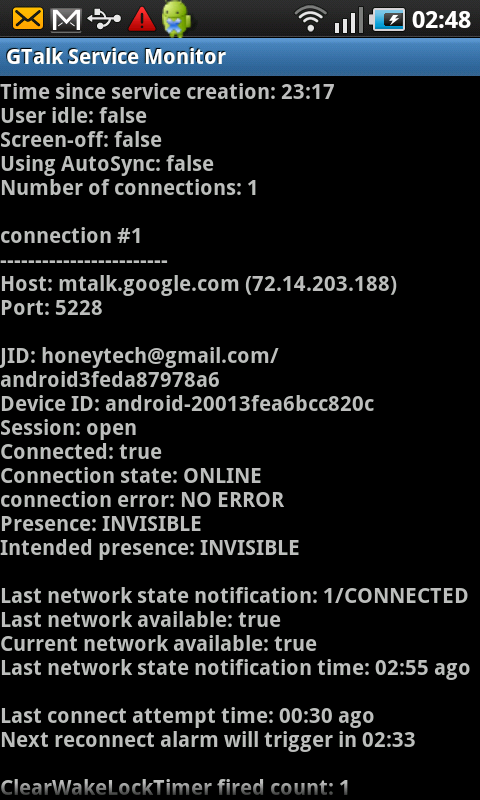
GTalkService ran communication for Android's entire push notification system, meaning that even things like a new Gmail notification came blasting down an always-on chat session between you and Google. XMPP was a real-time, authenticated way to quickly pass messages back and forth, so Google built an OS-wide notification system around it. The early days of Android development were done at a break-neck pace to try to catch up to the iPhone, and messy decisions like merging push notifications with your in-house messaging service helped get there faster.
Google eventually opened up the push system to third parties, first with Android "Cloud to Device Messaging," then "Google Cloud Messaging," and then "Firebase Cloud Messaging." (If you haven't noticed, Google likes to reboot and rename products.) The modern Firebase Cloud Messaging is actually still XMPP-based to this day, though. Of course, it has been separated from Google Talk now.
I am just going to go ahead and call GTalkService the early ancestor of Google Play Services. GTalkService wasn't only used for notifications on Android—the cloud synchronization of Google account data also ran through the GTalkService, keeping things like your contacts and calendar events up to date. GTalkService was even used to install apps on Android. The co-founder of Duo Security, Jon Oberheide, has two fantastic writeups on GTalkService from 2010. As he explains, "When you click to install an app through the Android Market, Google pushes down an INSTALL_ASSET to your phone [over GtalkService] which causes it to fetch and install that application." You didn't actually request the app package from the Android app store, they were pushed to your phone via Google Talk. (Did I mention early Android development was quick and dirty?)
The benefit of doing app install calls over push notifications is that you don't actually have to be in front of your phone to install an app. Google surfaced this feature with the Android Market (now Play Store) website, where you could remotely install a phone app from your desktop web browser—it's all the same push request. GTalkService even gives Google a nuclear option for malware. The company could even remotely uninstall malicious apps from your phone, without your permission! Oberheide holds the distinction of being the first person to trigger a remote, mass uninstall after uploading a (harmless) malware proof-of-concept app to the Android Market in 2010. After unveiling its malware nuke to the world, Google warned: "While we hope to not have to use it, we know that we have the capability to take swift action on behalf of users’ safety when needed."
The slow death of GTalk
After maybe 2009, not much happened with Google Talk. The Android team kept building mobile clients up until 2011, but it seemed like the original team lost interest in the service. This is how it always works with Google chat services. The ones that don't get shut down eventually are abandoned and left to rot. Users get frustrated with the lack of continual development and old clients and slowly migrate to other services. Eventually, a new Google team comes along with plans to reboot everything.
The shutdown of Google Talk was a very slow transition, and with the plethora of clients, the merger with Google Hangouts, and third-party XMPP support, it's hard to pick an exact time of death. But the beginning of the end for Google Talk was in 2013 with the release of the Hangouts chat service we know today. Hangouts wasn't just another messaging app, it was a replacement for Google Talk, allowing you to carry your contacts and messages to the new service. Some clients, like the Android Google Talk app, got an in-place automatic upgrade to Google Hangouts, along with optional transitions and replacements for most clients. The first major client shutdown came two years later when the Google Talk Windows client officially stopped accepting logins on February 23, 2015.
If you really wanted to go down with the ship, the last gasp for Google Talk was surprisingly late: June 26, 2017. At that point, third-party XMPP connections to the Google Talk service stopped working, the Gmail web integration was forcefully transitioned to Hangouts, and (if you had somehow dodged Android app updates for four continuous years) the legacy Google Talk app also stopped working. Google Talk had long become irrelevant with the rise of Hangouts in 2013, but if you wanted to pick a final death date, June 2017 is it. RIP Google Talk.
Part of the reason for the lengthy shutdown is that it wasn't just "Google Talk: the consumer chat service" that Google was turning off. It was also "Google Talk: The back end XMPP Google service" that Google needed to make sure kept running, which by now had wound its tendrils into several services. Google Talk needed to be killed without interrupting service for Firebase Cloud Messaging, which grew out of the XMPP project. Google Docs actually had a bit of a service interruption when Google Talk finally shut down in 2017, too. While it was never cross-compatible with Google Talk, it turns out those pop-up chat boxes were actually based on Google Talk originally. A GSuite blog post in 2017 mentioned that, because "Docs Editors chat functionality is built on Google Talk," work needed to be done to "decouple the feature from Talk" when it shut down. G Suite organizations that didn't get their transitional Google Talk and Google Hangouts settings correct would briefly lose chat functionality.
Google really doesn't do product shutdowns like this anymore: shutdowns where you had a lengthy four-year shutdown period and not just a relatively smooth transition to a new service but a fully optional transition that lasted several years. Today, the company is simply a lot more ruthless about kicking users off a service and abandoning them.
Google Talk got a really long section in this history, but it deserves it. As Google's first and one of its most successful instant messaging services, it set the blueprint for everything that followed. If you pay attention, you'll see future Google messaging services poorly try to copy Google Talk's homework, often with disastrous results. When you're the OG Google chat service, you're adding new features that didn't exist before for Google users. When you're everything that comes after Google Talk, people are just asking, "How is this better than Google Talk?"
Google Voice (2009)—SMS and Phone calls get a dose of the Internet
Lifetime: March 11, 2009—Present
Clients: web, Android, iPhone, Web OS, Blackberry
 The original Google Voice inbox. You'll see a mix of text messages and transcribed voicemails.
The original Google Voice inbox. You'll see a mix of text messages and transcribed voicemails. The GrandCentral voicemail inbox, before it became Google Voice. It was for voicemail only.
The GrandCentral voicemail inbox, before it became Google Voice. It was for voicemail only. The original Android app on Android 2.1.
The original Android app on Android 2.1. Apple blocked the iOS app for a while, so here's the iOS Mobile web app from January 2010. This was also designed for Palm's WebOS.
Apple blocked the iOS app for a while, so here's the iOS Mobile web app from January 2010. This was also designed for Palm's WebOS. By the end of 2010, the iOS app had finally arrived. Who else just got PTSD from that iPhone notification pop-up?
By the end of 2010, the iOS app had finally arrived. Who else just got PTSD from that iPhone notification pop-up? The Blackberry app.
The Blackberry app. Google Voice's visual voicemail was built into the Android 4.0 Ice Cream Sandwich phone app.
Google Voice's visual voicemail was built into the Android 4.0 Ice Cream Sandwich phone app.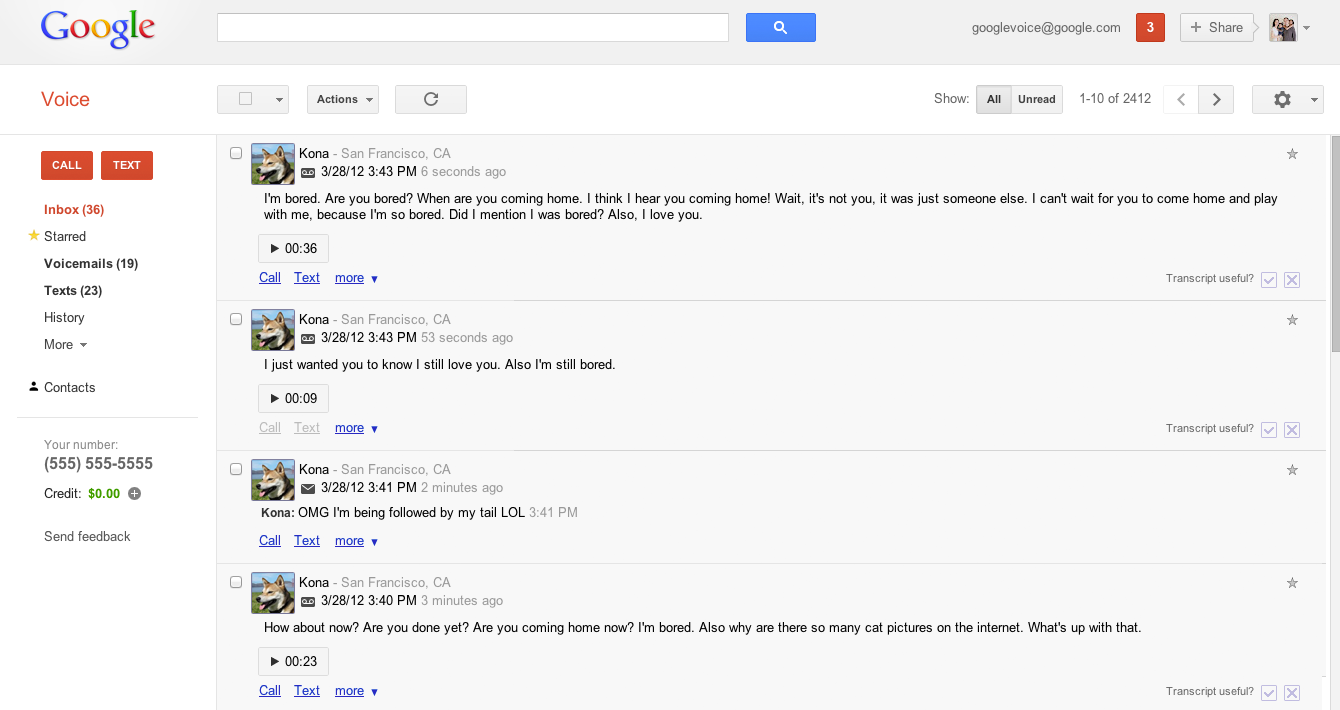 The 2012-era "red and gray" version of Google Voice on the web.
The 2012-era "red and gray" version of Google Voice on the web.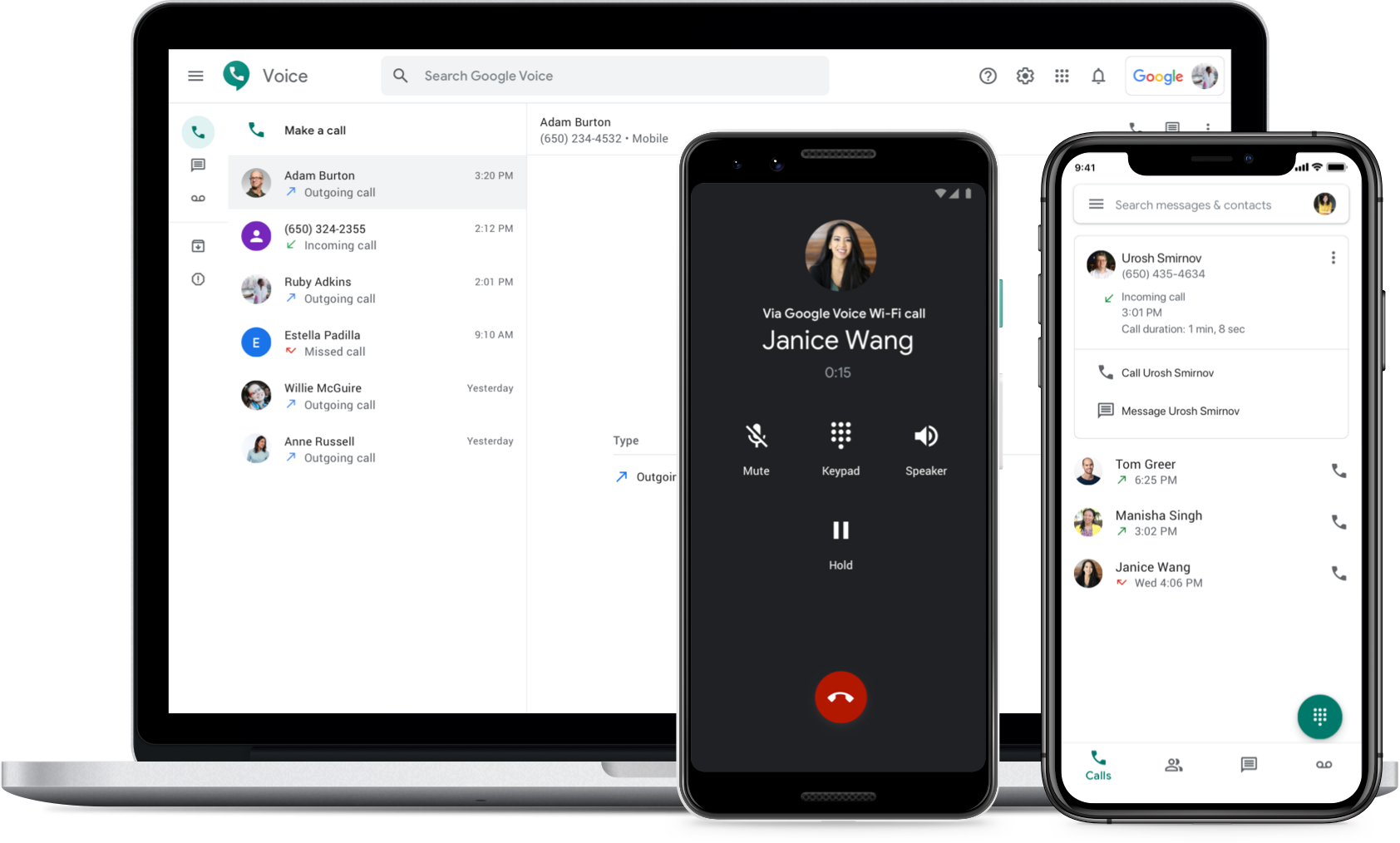 The current version of Google Voice.Google
The current version of Google Voice.Google
It only took 3.5 years after the launch of Google Talk for a second Google messaging service to appear, though it actually had a good argument for why it should exist alongside Google Talk. In March 2009, Google asked the question: "What if we rigged up the phone system to the Internet?" and Google Voice was born. Instead of a landline phone number or a cell phone number, Google Voice gave users a Google phone number—with an area code and everything—that was device agnostic. Your phone calls could be forwarded to other phone numbers based on the time or contact, and your text messages were accessible via the web and various apps.
The best part of Google Voice is having a number that really feels like you own it. In the early days of Google Voice, carriers made number porting as annoying as possible, and switching cell providers could mean losing your carrier-owned phone number. With Google Voice, it didn't matter. You could give everyone your Google Voice number, and switching services just meant adding a new forwarding number that you never told anyone about.
The origins of Google Voice actually started back in 2007 when Google acquired GrandCentral Communications. GrandCentral was where all of Google Voice's phone call (as opposed to messaging) functionality came from. It offered a new phone number with forwarding to other lines and an audio-only voicemail box that was accessible over the Internet. There wasn't any texting functionality, though.
With the launch of Google Voice, Google added a ton of features to GrandCentral, like SMS support, conference calling, and low-cost international calling. The Googliest feature was voicemail transcription, where Google's voice recognition AI would (attempt to) transcribe your voicemail into easily scannable text. In the early days, it wasn't super accurate, but Voicemail transcription was still better than the black box of a play button. There was usually enough wonky text information to figure out if the voicemail was important or not. Voicemail transcription was one of Google's first voice recognition products, and in the early days, Google Voice's "creative" interpretations of voicemail audio gave rise to the meme of sharing failed and funny Google Voice transcript errors. Take a look; Google's speech-to-text technology has come a long way.
We're here for the texting part of Google Voice, though, and SMSes to your Google Voice number worked just like a texting app. These showed up anywhere you had the app installed or on the web instead of being siloed on your phone. Since Google Voice was SMS, there were basically no features. Even getting MMS support was a long-running battle: it first showed up for Sprint users (via email) in 2011, but proper MMS support on all carriers didn't arrive until 2017. Voice was never a flashy service, but since Google Voice was SMS, it let you talk with anyone, and it let you pull your dumb cell phone number into the cloud where it could work on multiple devices.
Voice was seen as a threat to carriers at the time, so the service ruffled a few feathers when it came out. When Google submitted an official Google Voice app to Apple's app store, Apple rejected Google's app and removed a few third-party Google Voice apps it had previously approved. This move drew the ire of the FCC, and it questioned Google's and Apple's exclusive carrier partner at the time (in the US): AT&T. With free VoIP calls, SMS, and voicemails, Google Voice was an obvious threat to AT&T, which previously had been against VoIP apps on the iPhone. AT&T told the FCC it was not involved, however. Google said Apple VP Phil Schiller personally blocked the app, saying Apple didn't want apps that "duplicated the core dialer functionality of the iPhone." Apple said it had not, in fact, rejected the Google Voice app, and it was still "studying" the app. The Google Voice iPhone app was initially submitted in June 2009, and by the time of the FCC inquiry, the Google Voice app had been delayed for two months. Apple must have been doing a marathon study session!
Apple's "studying" continued for the entirety of 2009, and by January 2010 Google had launched a Google Voice mobile web app for iPhone and Palm's WebOS (may it rest in peace). Apple ruled over the App Store with an iron fist, but it couldn't stop the Internet, and Apple users could point their browser at the Google Voice mobile site and make calls, view voicemail, or send SMS all through a web page. The downside was that the web couldn't do notifications at the time, so Google Voice didn't really work well for receiving SMSes or voicemails. It wasn't until November 2010 that Apple finally finished its meticulous study session and let Google Voice into the app store.
Google Voice is the first item on our list that is actually still around; every day that Google Voice continues to exist feels like a surprise. The service has been hanging around for 11 years now and has spent most of its life in the "neglect" stage of a Google messaging service. It often feels like Google Voice exists in a dusty closet at Google HQ somewhere, and the company forgets about it for years at a time.
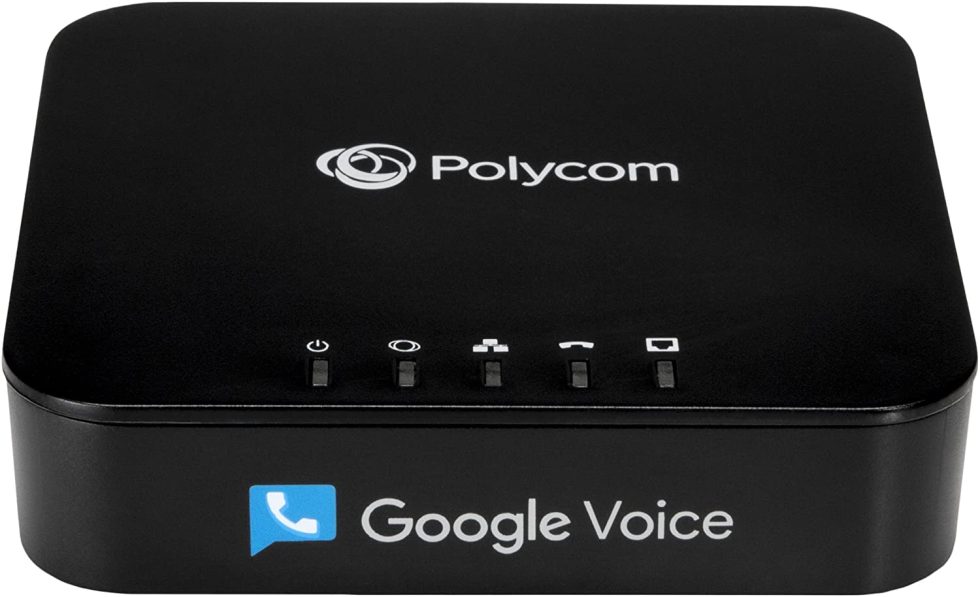
Besides seeing its share of neglect, Google Voice has also seen its share of shutdowns. Google Voice used to have a range of third-party apps, but Google killed them all in a single swing one day in 2014. The company declared that any third-party apps that worked with Google Voice phone calls or SMS—which, by the way, had been operating for years—were "unauthorized," "a threat to your security," and "violating the terms of service." Google didn't want to allow third-party Voice apps but also didn't want to develop the first-party app itself, so it left users stuck with the crappy, neglected app.
We've already talked about how Google Talk and the Android push notifications were built around XMPP, but would you believe Google Voice at one point also used XMPP? XMPP was used to connect calls, and with this open standard, users could rig up landline phones to work directly over the Google Voice system, making it a VoIP provider. You'd also get free voice calls. XMPP support was shut down in 2018, but it sounds like it was replaced with some kind of closed-off solution that can be licensed by some companies. Polycom, for instance, still makes Google Voice FXO VoIP Gateways.
Google Voice has seen a resurgence starting around the launch of Google Fi in 2015, which merged the Google Voice feature set with an MVNO service. The two services were so similar at launch that you couldn't even have both a Google Fi number and a Google Voice number—you had to port your Voice number to Google Fi. Since then we've seen a renewed commitment to Google Voice from Google, with revamped apps launching in 2017. Google Voice became a part of GSuite in 2018 and got mobile VoIP calls in 2019.
Google Wave (2009)—An email killer from the future
Lifetime: May 28, 2009—January 31, 2012 (2 years, 8 months but declared dead August 4, 2010)
Platforms: The web
 This was what Google Wave looked like, if you've forgotten.
This was what Google Wave looked like, if you've forgotten. The columns could be minimized. Here the navigation and contacts panel is minimized.
The columns could be minimized. Here the navigation and contacts panel is minimized.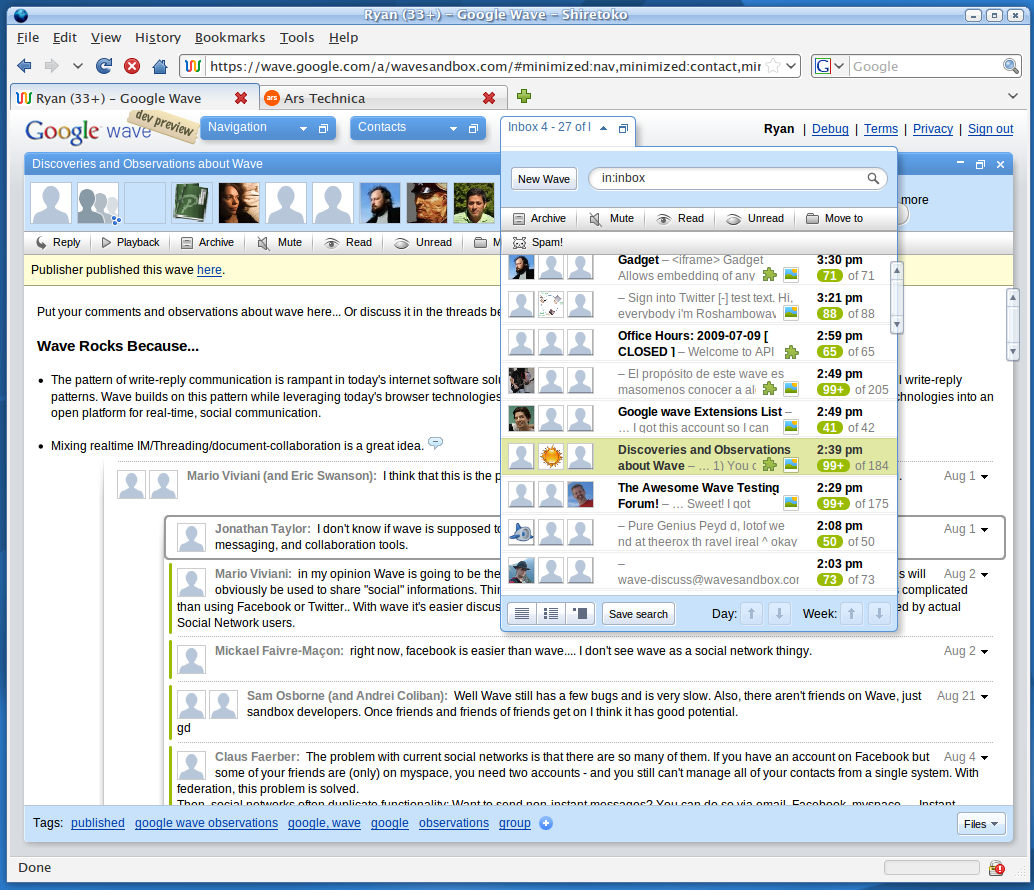 Here the Inbox is minimized, too, for a full-screen waving experience. The minimized columns got these pop-up UIs.Ryan Paul
Here the Inbox is minimized, too, for a full-screen waving experience. The minimized columns got these pop-up UIs.Ryan Paul User addresses looked just like email.
User addresses looked just like email. Drag and drop users to the top thumbnail bar to add permissions. This mouseover menu gives you more options.
Drag and drop users to the top thumbnail bar to add permissions. This mouseover menu gives you more options. No Wave is open here.
No Wave is open here. Lots of things were embeddable in Waves. YouTube videos, Maps, images, polls, and more. Here's a chess game.Ryan Paul
Lots of things were embeddable in Waves. YouTube videos, Maps, images, polls, and more. Here's a chess game.Ryan Paul
I personally believe that Google Wave does not belong on a list of messaging apps, but every time I leave it out of a messaging app discussion I inevitably get comments saying, "I can't believe you forgot Google Wave!" To stop those, it's this exercise's policy to cast a wide net and cover borderline products, at the very least so we can formally define them as "not a messaging app." Thus, Wave makes the cut.
For the record: Google Wave was email, not a messaging app. It wasn't really used for one-to-one communication, and at no point was it possible to deliver notifications to a phone. At Google I/O 2009, Google introduced Wave to the world specifically as an email alternative, with co-creator Lars Rasmussen saying "Email was invented over 40 years ago...what might email look like if it was invented today?" At no point was Wave out to replace Google Talk.
On the desktop, Wave had three main columns: a navigation and contact column on the right, an inbox in the middle, and a message view on the right. Like email, Wave would let you create message threads, and users could reply to either an entire group or a single person. Because Wave was hosted content and not email text that was copied to local computers, contact selection worked more like a modern permission system or chat room. You could grant or remove access to Wave threads by adding or removing people.
Wave was the first Google product to do real-time, letter-by-letter communication. The service would instantly send each keystroke across the Internet, and it would show up on another person's screen, all through the magic of HTML5. Active Wave threads looked alive, with replies popping up, and images being uploaded in real time, letter by letter, without refreshing the page. Wave even had a feature called "Playback" where the entire Wave creation process could be played back (in chunks) from scratch.The live typing, letter-by-letter technology was eventually brought to Google Docs, which is where most people encounter this sensation today. The Wave team actually demoed collaborative document creation in a Wave, complete with in-line comments. Wave's input system was really the basis for the modern version of Google Docs, and the entire document system was deemed good enough to be ported over.
Wave was created by Lars and Jens Rasmussen, the same pair of brothers who brought the world Google Maps. In the same way that Google Maps' live, scrollable map was a revolution for browsers at the time, Wave's live typing and other app-like features were cutting-edge stuff at the time (though an app called EtherPad, which Google later acquired, cracked live typing first). The I/O 2009 intro to Wave felt like it was from another era. "[Wave] is an unbelievable, powerful demonstration of what is possible in the browser," Engineering VP Vic Gundotra told the crowd. "Over the next hour and a half, as you see this product, you. will. forget. that you are looking at the browser. I want you to repeat after me: I am looking at an HTML5 app. I am looking at what's possible in the browser." Hearing this again is wild. Remember when browser apps sucked?
Another "you can do that in a browser?!" feature of Wave was the ability to upload photos with drag-and-drop, just like in a native app. This was the one ability of Wave that wasn't purely HTML5 wizardry. It required the installation of Google Gears, Google's browser API shim, at launch. Google said it was working to make drag and drop from the desktop part of the browser standard, and the feature eventually made it into Chrome in 2010.
While Google Wave was the first implementation of Wave, Google did not try to make itself the center of Wave or to build a walled garden. Wave was open source, and like Google Talk, Google imagined Wave as a federated platform where users on different clients and service providers could still talk to each other. The Wave Federation Protocol happened over—wait for it—XMPP, with the extra Wave bits implemented as an open extension to the XMPP core.
Wave had a heavy branch of features dedicated to APIs and bots. Waves could be embedded in blogger webpages, allowing for live edits and additions to show up on a normal web page. Wave communicated this by adding a "Blogger" bot to a Wave, letting everyone know the information was public and keeping the embedded Wave in sync (letter by letter, in real time) with the main Wave. Some bots could do things like import tweets into a Wave or play games or do real-time translation.
I can see the confusion people have in calling Wave a messaging app. Email and messaging are both just text, so a real-time email app is just as "instant" as an instant messaging app. The difference is in the interface, though. Wave was always a big, heavy, inbox-driven app that you were supposed to live in, making it very email-like. Wave never got any mobile apps and only supported a single platform: the browser. That meant there was a mobile version of the site, but especially in 2009, this was an awful experience. Even if you wanted to use Wave as a messaging service, without an app, you wouldn't be able to make your phone beep about an incoming message. Therefore, it has to be disqualified from being deemed "messaging."
Nobody knew what Wave was for or how to use it
Google announced the death of Wave on August 4, 2010, just 15 months after the service was announced. Google said flatly, "Wave has not seen the user adoption we would have liked." Wave became read-only on January 31, 2012, and all Wave content was deleted in April 2012. As an open source project, Wave was supposed to live on at the Apache Software Foundation, but the project never produced an official release, and it was retired in 2018.
A big contributor to Wave's death was the lack of a network effect. Wave could only be used to communicate with other users on Wave, so you get the catch-22 of people only wanting to use Wave if people already used Wave. Exacerbating this problem was the fact that Google hamstrung the initial Wave userbase with an invite system, so even interested users couldn't try out the service immediately. (Admittedly, a load of users firing up the all-live, all-the-time app was probably a scary proposition for Google's network engineers.) Wave went a whole year before removing the invite system, which, for a collaborative communication app, seriously limited its viability. On May 26, 2010 (Google I/O 2010), Wave's invite system was dropped, and it was open to the public. But by then, the hype was gone and no one cared. Wave lasted an incredible 70 days as a public service before Google announced it was dead.
Shortly after Wave's death, a group of Ars staffers got together and rounded up a litany of complaints covering why they didn't use the service. This was before the browser javascript benchmark wars, and browsers weren't great at handling the javascript-heavy Wave site, which was described as "slow and wonky." The triple-plane layout could get cramped on a 4:3 desktop monitor (though columns were minimizable), and the site was called "ugly" and "confusing." Spotting the newest messages, which could be anywhere in a long Wave, was difficult. Like a wiki, ownership of an individual message on Wave was not really a thing. Anyone could edit, or delete, anyone else's content in the Wave.Live, letter-by-letter typing is an interesting communication method, and if you've never tried, fire up Google Docs with a friend and give the document text a shot as a communication platform. For good typists, it's a faster, more fluid form of communication that's kind of fun. For less confident typers, live typing turns keyboard input into a high-pressure performative act with a live audience, and you can see how it would turn off some people. The lack of any kind of draft mode meant you didn't have a free second to compose your thoughts into text or think about what you wanted to type—every letter was immediately broadcast onto the Internet, showing the world your typing speed and error rate. Google is a place full of tech-savvy computer nerds, and sometimes a group like that, building a product in a bubble, completely whiffs on the emotional human element of a messaging app or social network. This was one of those times.
Wave policy of "always live update everything, all the time" can lead to a Wave inbox being pretty overwhelming when it is active and popular. Martin Seibert made the above video for a Techcrunch article showing just how bad it can get. Being live means the inbox just constantly jumps around as new messages load in, making it difficult to even read a thread subject before it disappears. When popular, Wave was a completely unmanageable mess where you'd never hit Inbox zero.
When Wave was still active, there was a ton of talk about federation, bots, and APIs. Users constantly hoped that someone, Google or a third party, would make Wave interoperable with any other service, like Google Talk or email. That approach would solve the problem of Wave only being useful when talking to Wave users. If Wave hooked up to another service, Wave could be useful for the individual user no matter what, and Wave features could be added any time two Wave users were communicating with each other. Google Voice did a great job of this with the phone system by adding extra features to SMS, Voicemails, and phone calls. A solid connection to an established communication network never materialized, though, so Wave never had a solid userbase.
In the peak social media days, everyone was on Facebook because everyone was on Facebook. In this case, nobody used Wave because nobody used Wave. From here on out, the network effect would forever be a huge problem for Google messaging services. Some future projects took note of this and tried to juice the initial network—in some successful and, uh, extremely unsuccessful ways. Speaking of which...
Google Buzz (2010)—The non-consensual social network
Lifetime: February 9, 2010—December 15, 2011 (1 year, 10 months)
Platforms: Desktop Gmail, mobile web apps for Android and iOS.
 The Google Buzz sales pitch.Google
The Google Buzz sales pitch.Google Google Buzz automatically made a social network out of your Gmail and Google Talk contacts without asking. This screen is crazy: "Here's what we did! Press the "Ok" button!"Google
Google Buzz automatically made a social network out of your Gmail and Google Talk contacts without asking. This screen is crazy: "Here's what we did! Press the "Ok" button!"Google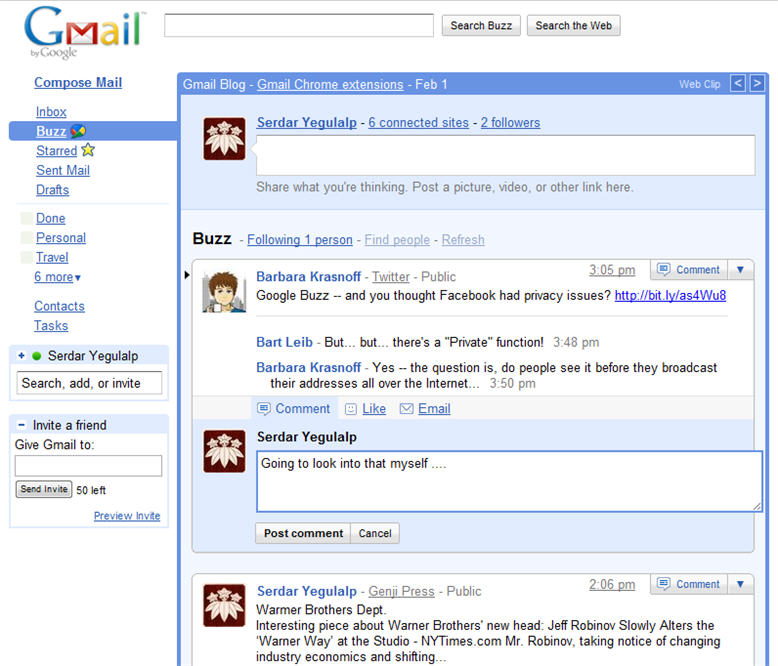 The main Buzz interface.
The main Buzz interface.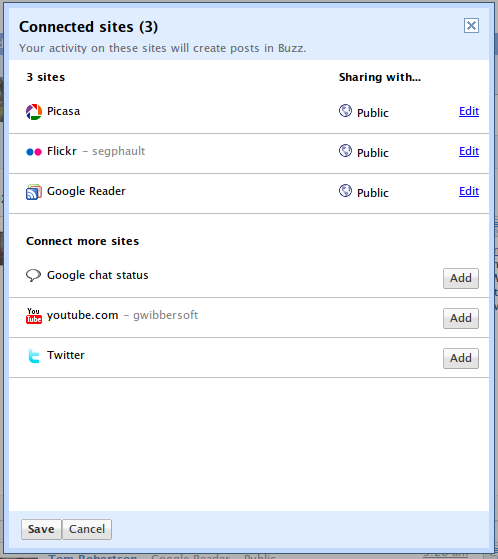 Buzz's connection settings with other services. These were also set up automatically for the Google services.
Buzz's connection settings with other services. These were also set up automatically for the Google services.
Where do you even start with Google Buzz, one of Google's most notorious products? Remember that in 2005, Google Talk found a major shortcut to a big user base when it was integrated into Gmail. So, surely, the same strategy would work for Google's social network aspirations, right? In early 2010, the Google Buzz social network launched, not as a standalone service but as a Gmail sidebar component just like Google Talk. Oh yeah, it also started automatically following and sharing stuff with your frequent email contacts without really asking users if that was OK. What followed was a whirlwind of controversy, complaints, and lawsuits, and it's kind of astounding how most of the Google Buzz saga took place over just four days.
Google built a basic social networking app with a scrolling list of posts and replies—it was basically identical to Facebook or Twitter, but in Gmail. Follow a person. Post some text. Add a picture. Press the "like" button. The basics were wholly unoriginal other than the fact that it was invading your email inbox.
Every single design decision made for Google Buzz can be framed as "fixing the network effect." Remember how Wave died because nobody used Wave? That was not going to happen with Google Buzz. Shoving the product into Gmail would quickly get it a big user base of its own. Buzz was also pitched as a "social aggregator" and could pull in posts from other services, so even if none of your friends were on Buzz, you could still use Buzz and see their content. Buzz would pull in posts from Twitter, photos from Picasa and Flickr, or (brace yourself for sadness) articles you liked on Google Reader.
Buzz's critical mistake was how the initial setup worked. It was totally automatic—Buzz built your social graph for you by automatically adding frequent contacts from Google Talk and Gmail. You would automatically follow them and they would automatically follow you, all without the input of a human on either end. It also automatically connected Google Reader and Google Picasa data and instantly associated any public content with your Buzz profile. From there, the service shoved all that in front of any "friends" it detected.Google's day-one blog post for Google Buzz is worth a read just to get an idea of what an astoundingly out-of-touch, non-consensual nightmare the Google Buzz rollout was. "Buzz is built right into Gmail, so there's nothing to set up," the blog post reads. "You're automatically following the people you email and chat with the most." Buzz was also going to spam the hell out of your inbox unless you found a way to stop it: "To make sure you don't miss out on the best part of sharing, Buzz sends responses to your posts straight to your inbox. Unlike static email messages, Buzz messages in your inbox are live conversations where comments appear in real-time." Google just decided to turn your email client into a social media network, and it hoped you were OK with that. Nobody was.
 Google Buzz for mobile! I love the table at the bottom. Notice that Android fragmentation had already become a thing, with some features only available for Android 2.0.
Google Buzz for mobile! I love the table at the bottom. Notice that Android fragmentation had already become a thing, with some features only available for Android 2.0. Google Buzz was only a mobile website. There were no apps.
Google Buzz was only a mobile website. There were no apps. Mobile Google.com got a Buzz button, and Android got a Buzz widget.
Mobile Google.com got a Buzz button, and Android got a Buzz widget. Google Maps on Android also got some Buzz functionality.
Google Maps on Android also got some Buzz functionality.
Buzz never got a standalone website, and it never got any mobile apps. It did get a mobile website for Android and iOS, via a coveted link on the mobile Google.com search page. Android 2.0 also integrated a Google Buzz home screen widget and Google Maps added a "buzz about this place" button in location listings. Besides the expected mobile browsing of, uh, buzzes, mobile Buzz was also a Foursquare and Dodgeball clone, letting you tag posts with a location.
Google Buzz's automatic setup exposed a ton of data about people without really properly informing them or getting their consent. Like most social networks, who your friends are following was public information on Buzz, but since this was created automatically from contacts, Buzz exposed everyone's frequent email contacts to the world. Your Buzz username was also your email address, so that was automatically exposed to the world, too. If you used the Foursquare-like location sharing, then your location would be broadcasted to any "nearby" Buzz users—not just your friends.
Buzz used a lot of the same predatory privacy tactics as Facebook, where, sure, there were technically controls for all this stuff somewhere, but they were purposefully deemphasized to trick users into making everything public. Buzz made users opt-out of exposing sensitive information, instead of having them opt-in to sharing. Users who didn't carefully comb every square inch of the screen for the low-contrast fine print didn't understand what they were exposing, and they felt betrayed after realizing what was shared with their contacts.
By day two, Google still wasn't in touch with the reality of what it had done. A new blog post touted how proud Google was of all the (forced) usage Google Buzz was getting. "It's been just two days since we first launched Google Buzz. Since then, tens of millions of people have checked Buzz out, creating over 9 million posts and comments," the post stated. "Plus, we're seeing over 200 posts per minute from mobile phones around the world." If you're a bean-counting, spreadsheet-obsessed, emotionless robot, this probably sounds like a success. The problem was, no normal human liked this, and most of these posts were complaints. Google's day-two blog post gave a minor nod to some privacy concerns people had raised, but the damage was already done.
The rest of the world had turned against Buzz by day two, and the consumer revolt was incredible. Buzz was called a "privacy nightmare" in the press. In one viral post, a woman recounted how Google Buzz's algorithms decided it was a good idea to automatically reconnect her with her abusive ex-husband and threatened her safety.
By day four, Google finally gave up and posted an apology on its official blog. "We quickly realized that we didn't get everything quite right," the company said. "We're very sorry for the concern we've caused and have been working hard ever since to improve things based on your feedback." These "improvements" involved stripping back Buzz's automatic setup process and turning "automatic following" into a "suggested contacts" list. The company added better blocking controls for unwanted followers and stopped auto-connecting Picasa photos and Reader articles. It also added the option to turn off Google Buzz in the Gmail settings, finally providing an opt-out for Buzz entirely.
As far as much of the public was concerned, the entire life and death of Google Buzz occurred these first four days. Buzz launched, it messed up everyone's Gmail for a few days, and everyone scrambled to turn it off and clean up the mess Google had made. Buzz was never anything special in terms of the actual product, and the stigma of the initial launch and the out-of-place Gmail integration made most people ignore it or turn it off.
Beyond week one, Buzz's lasting legacy centers on lawsuits and legal action. The Electronic Privacy Information Center (EPIC), a privacy watchdog and public interest research group, filed an FTC complaint over Buzz's privacy violations. After an investigation, Google settled with the FTC, committing to maintaining a "comprehensive privacy program" for 20 years. A class-action lawsuit was filed that eventually saw Google settle for $8.5 million. Google Buzz even earned international condemnation, with government officials from 10 countries sending Google an open letter telling it to drop its "launch now, fix later" policy.
Buzz feels like something that was generated entirely by an algorithm. Any normally functioning human would understand that there is a difference between email and social media and what those two things are used for. Email is often an obligatory, formal, and official form of communication with people and companies; social media is for fun (theoretically). There are tons of accounts you would communicate with over email that you would never want to see on social media, and vice versa, yet no one at Google realized this during the making of Google Buzz.
Buzz's death was announced unceremoniously as the second bullet point in one of Google's infamous "spring cleaning" posts on October 14, 2011. At this point, absolutely nobody cared, since all of Google's social attention had been on its new baby, Google+ (that had launched four months earlier). Google announced Buzz would be shut down in "a few weeks" and that it "learned a lot from products like Buzz, and are putting that learning to work every day in our vision for products like Google+." I can't find any reports of the actual Google Buzz shutdown date, but the Wikipedia entry has a completely unsourced date of December 15. If accurate, that would mean the product lasted one year and one month. Really, though, Google Buzz was four days of terror and then it died.
Slide’s Disco (2011)—An independent app escapes the Googleplex
Lifetime: March 24, 2011 to October 11, 2012 (1 year, 6 months)
Platforms: iOS, Android, the web
 The Disco app icon and start-up screen from iOS's maximally skeuomorphic design era. Everything looks like a delicious piece of candy.
The Disco app icon and start-up screen from iOS's maximally skeuomorphic design era. Everything looks like a delicious piece of candy. This SMS group chat thing was a real hack. You can see here you're actually messaging "Disco.com," and messages from your friends aren't directly from your friends. They are all from Disco.com, just with their context names prepended to each message.
This SMS group chat thing was a real hack. You can see here you're actually messaging "Disco.com," and messages from your friends aren't directly from your friends. They are all from Disco.com, just with their context names prepended to each message. The Android app. This looks like a lot more of an actual service instead of an SMS hack.
The Android app. This looks like a lot more of an actual service instead of an SMS hack.
Is this one new for you? This one is new for me. Once upon a time, there was a company called "Slide, Inc." It was founded in 2004 by PayPal co-founder Max Levchin, and this company was the maintainer of the super-popular Facebook games Superpoke and Superpoke Pets. One day, Google—probably as part of its panic over the rise of Facebook—bought Slide. Slide had an incredible run at Google. Google announced it purchased the company on August 6, 2010, for $182 million, and then Google announced it was killing the company August 26, 2011. During those 387 days of operating under Google, Slide did the obvious thing and made a messaging app.
It was called "Disco."
To start, it was only for iOS and only worked in the US. I feel like this app is mostly lost to time, due to only being alive for a year and mostly having a low profile during that time. The best report I can find is from Business Insider, which, in a wonderful time capsule, describes the app as "another one of those group texting apps everyone keeps talking about." Group messaging was apparently novel enough at the time for this kind of commentary. BI continued: "Disco is late to the game and already a bit behind in the features other group messaging apps have" and compared it unfavorably to GroupMe, which launched a year earlier.
Group chat is not actually supported by SMS (that's MMS, and it was not well supported at the time), but Disco did its best to turn single-target SMS into a group chat anyway. You could create a new group with the Disco app, which would generate a new phone number for the group. You and your group chat cohorts would all send their messages to this one Disco number, and Disco forward the messages to everyone else, prepended with their contact name. The Disco app didn't actually do much. It was used for managing groups, and users could add a group number to your contacts. After that, all the actual texting happened in the iPhone SMS app. I'm going to guess this wasn't an over-the-top messaging service for political reasons. Like we covered with Google Voice, AT&T and Apple would not have liked any service that "duplicated functionality." Disco still counted against your carrier's SMS billing, though, so everyone was happy.
There wasn't much more to Disco than this. That Business Insider report actually criticized Disco for a lack of features like "location sharing or group calling." Digging through the site's Archive.org history reveals that eventually there was an Android app, and at one point you could even send messages to Disco from the web at disco.com.
Slide and Disco are both things you can add to Google+'s considerable body count. The initial blog post title, "Google and Slide: building a more social web," should tell you all you need to know about what happened to Slide at Google. Google+ was launching in about a year, and like all competing Google projects, Slide needed to be ground up and fed to the new social beast.
The Google+ Era (2011)—Google's social panic
 The Google+ feed.
The Google+ feed. The "Circles" UI, which let you share posts with certain contact groups.Google
The "Circles" UI, which let you share posts with certain contact groups.Google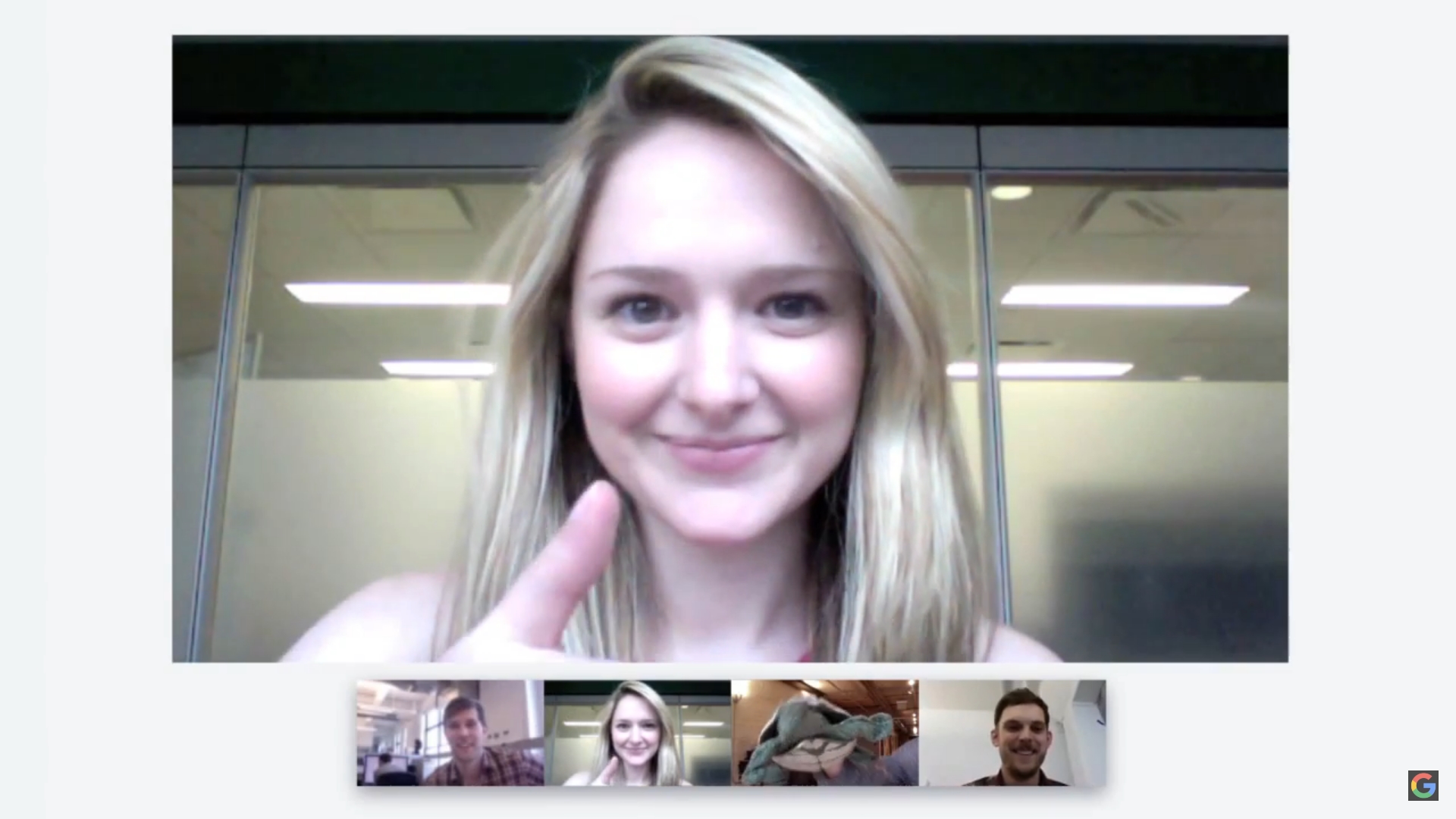 Google+ Hangouts video chat.
Google+ Hangouts video chat.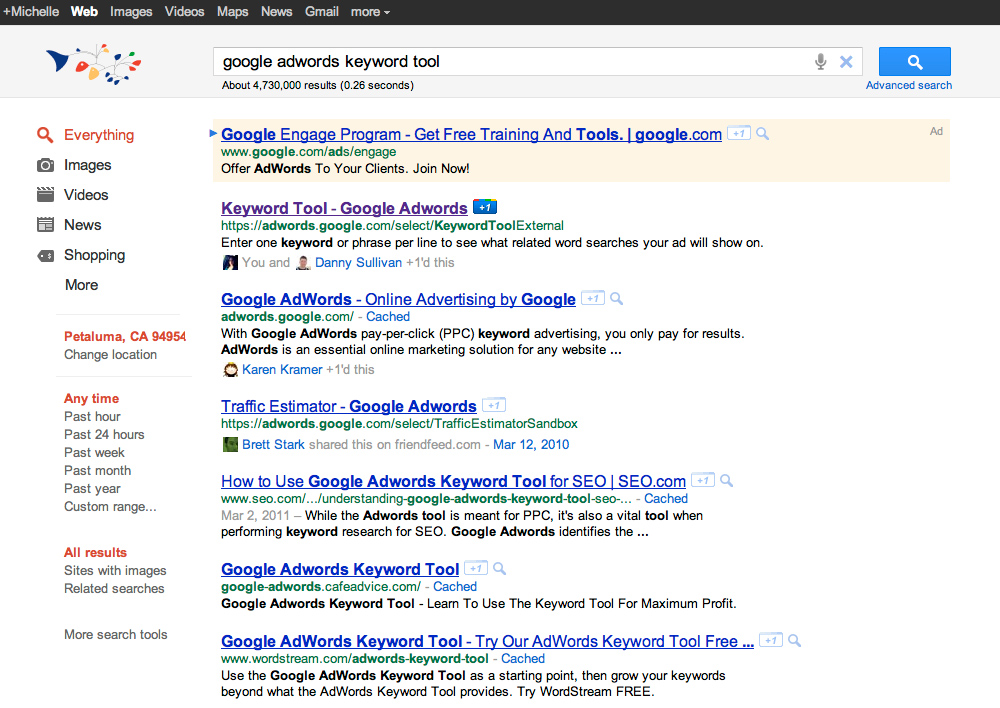 The very first wave of Google+, before the Google+ site even existed: Google added "+1" buttons to search results.
The very first wave of Google+, before the Google+ site even existed: Google added "+1" buttons to search results. When Google+ launched, it got a huge ad on the Google homepage. Yes, that obnoxious blue arrow was real.
When Google+ launched, it got a huge ad on the Google homepage. Yes, that obnoxious blue arrow was real.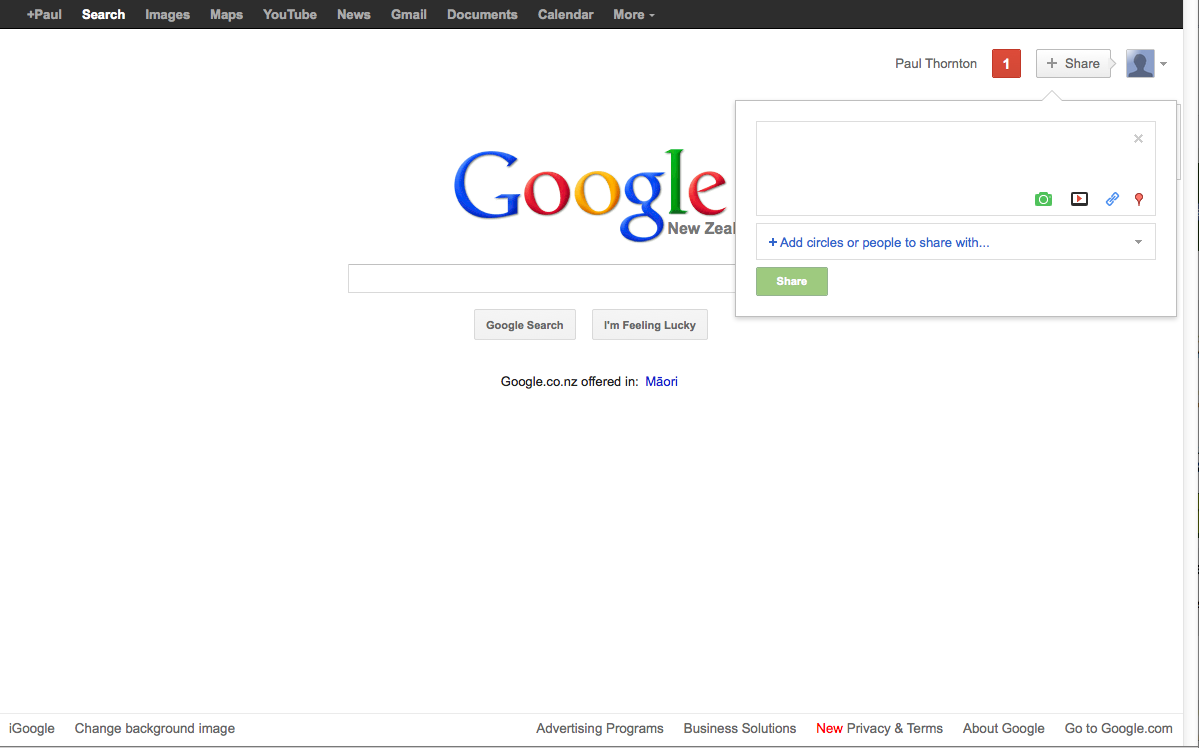 You could share things directly from Google.com.
You could share things directly from Google.com. YouTube's comments were merged with Google+.
YouTube's comments were merged with Google+. If you didn't convert your YouTube account to a Google+ account, you weren't allowed to comment.
If you didn't convert your YouTube account to a Google+ account, you weren't allowed to comment. A Google+ promotion in Android 4.0's setup flow. Android used Google+ for photo backup and the user's profile picture.
A Google+ promotion in Android 4.0's setup flow. Android used Google+ for photo backup and the user's profile picture.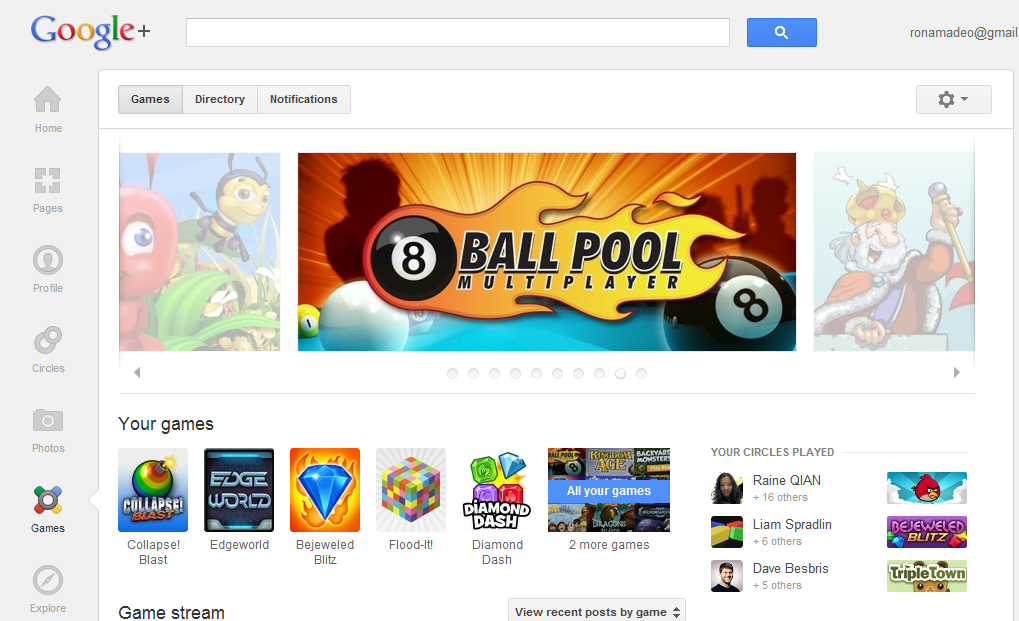 Another canceled feature: Google+ Games.
Another canceled feature: Google+ Games. Google Maps used Google+ Local for businesses and points of interest on the map. If you wanted to leave a review, you needed a Google+ account.
Google Maps used Google+ Local for businesses and points of interest on the map. If you wanted to leave a review, you needed a Google+ account. Google+ accounts are still needed to leave a review on Google Play.
Google+ accounts are still needed to leave a review on Google Play.
Looking back, it's almost hard to recall the deranged fever dream that was the Google+ era. Social media was a serious fad in 2011, and after the failure of Orkut, Jaiku, and Google Buzz, Google didn't have a social horse to bet on. Facebook had a stated goal of signing up every single human on the planet, and while it seems ridiculous today, Google saw Facebook as an existential threat. The thought was something along the lines of, "What if people ask their social graph instead of doing a Google search?" as if asking a gaggle of people from high school was somehow equivalent to doing actual research. (Don't do this. That's how you get anti-vaxxers.)
Google went into a complete panic over its lack of social platform, and on June 28, 2011, Google+ was born. In addition to a regular Facebook-style social networking site, Google+ was a hyper-aggressive, all-consuming social backbone that would run through most major Google services. If users wouldn't voluntarily use a Google social service, Google would make all of its services into a social service. The best quote showing how intense this was going to get came from Google executive Steve Grove, who dropped this doozy of a line: "Google+ is kind of like the next version of Google."
The motivation for Google+ came directly from the top. Earlier in 2011, then-CEO Larry Page tied all employee bonuses to the success of Google+. Very little at Google is done via a top-down directive like this, making Google+ one of Google's only products that seemed like a unified effort. Google's typical lack of unity is why you see so many messaging apps. Android's SMS app is handled by the Android team, and they don't really need to talk to anyone else. Google Voice was an acquisition and created its own team. Wave was a new project started by the Google Maps founders. Google Buzz was from the Gmail team.
Some companies with strong leadership can move toward a singular goal as a big unit, but with Google, working together was such a foreign concept that management had to bribe every individual employee with this bonus plan. I maintain that this is the only time Google has done something together as a company. The rest of the time, it's individual teams making autonomous decisions.
The core Google+ site was a pretty basic, Facebook-style social networking app, with posts, comments, and "+1"s instead of likes. The one big innovation was the concept of "Circles," Google+'s group-sharing mechanic. Instead of everyone being a "friend" like on Facebook, Google+ had users build several social circle lists, so you could have lists like "Co-workers," "Close friends," and "Family" and choose to share various things with each of them since each post had a checkbox sharing UI. This seems like a direct reaction to the outcry of Google Buzz, which shared everything with everybody. For Google+, Google said, "You want sharing options? Here are all the options you could want!"
Google learned very little from Google Buzz when it came to shoving social services inside established apps, though. Over the next few years, Google+ would be built into nearly every Google product. A top navigation banner across Google's suite of services included your Google+ profile and a live notification count. Google Search results integrated Google+ content, mixing in private data with public search results and letting users "+1" sites. For some period of time, you couldn't make a new Gmail account without also making a Google+ profile. Gmail showed Google+ profiles associated with each email sender. The Google Play Store required a Google+ account to leave a review. YouTube required a Google+ account to leave a comment. Android used Google+ for photo backup and contact retrieval. Google Maps integrated reviews and photos from Google+ directly into business pages, and Google Latitude, Google Maps' location-sharing service, was killed in favor of Google+ location sharing.
Google+'s greatest sin was the murder of Google Reader, a beloved RSS reader that some people still mourn to this day. Shortly after the service's death in 2013, Reader's ex-product manager revealed the team was borged into the Google+ collective sometime in 2010, which led to Reader's death.
Google+ wasn't all bad, though. It launched with "instant uploads" for photos, leading to what would eventually become Google Photos, one of Google's best new(ish) products.
Google+ Hangouts video chat—The first Hangouts
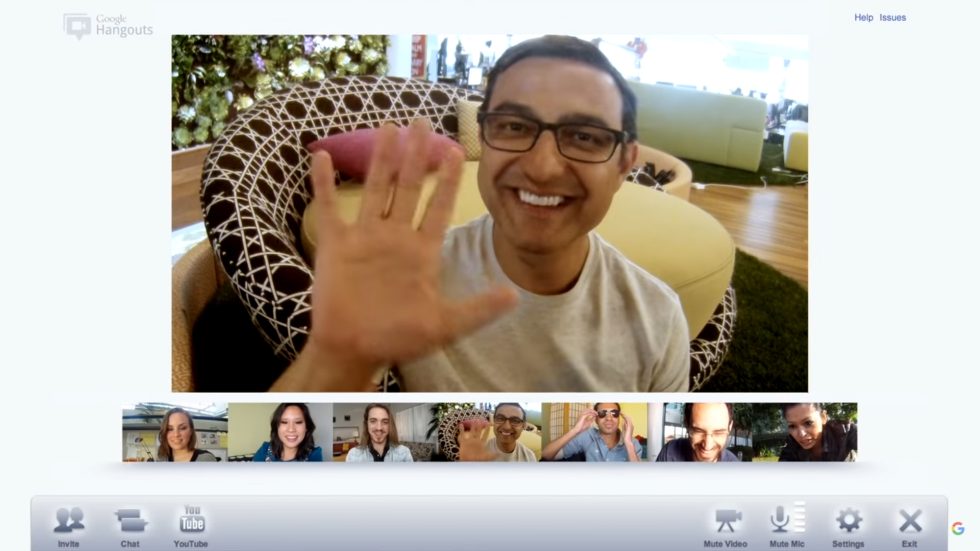
Besides the social network and borging everything into the Google+ collective, the service's 2011 launch included a group video chat platform called "Google+ Hangouts." Note that this is completely unrelated to the "Google Hangouts" chat service that would launch in 2013—it was just video chat.
Hangouts video chat had a novel interface that would show thumbnails of users at the bottom of the screen, and it automatically switched the main view to whoever was talking at the time. There was a text chat on the side and a few face-tracking special effects. You could even watch YouTube videos as a group.
While Google+ was not always looked on favorably, Google+ Hangouts was a big hit. Lifehacker called it, "The best free group video chat we’ve seen." In 2012, Google added a feature called "Hangouts on air," which would broadcast your group conversation on YouTube, basically making it the defacto standard for group conversation podcasts. Broadcasting a group video chat over YouTube was a great collaboration between Google services, so naturally, Google killed the feature in 2019 and never really launched a replacement.
Google+ Hangouts launched with 480p video only, and it needed a browser plugin to work—the same plugin used for Google Talk. In 2013, Hangouts video chat turned on HD 720p video chat when it switched from H.264 to Google's open source video codec, VP8. In 2014, Google switched over to WebRTC, the "RealTime Communication" standard for browsers, allowing Google Hangouts to do video chat without a plugin.
Google+ Huddle/Messenger—I guess we should have some kind of DM function
Lifetime: June 28, 2011—August 14, 2013 (2 years, 1 month)
Clients: Android and iOS
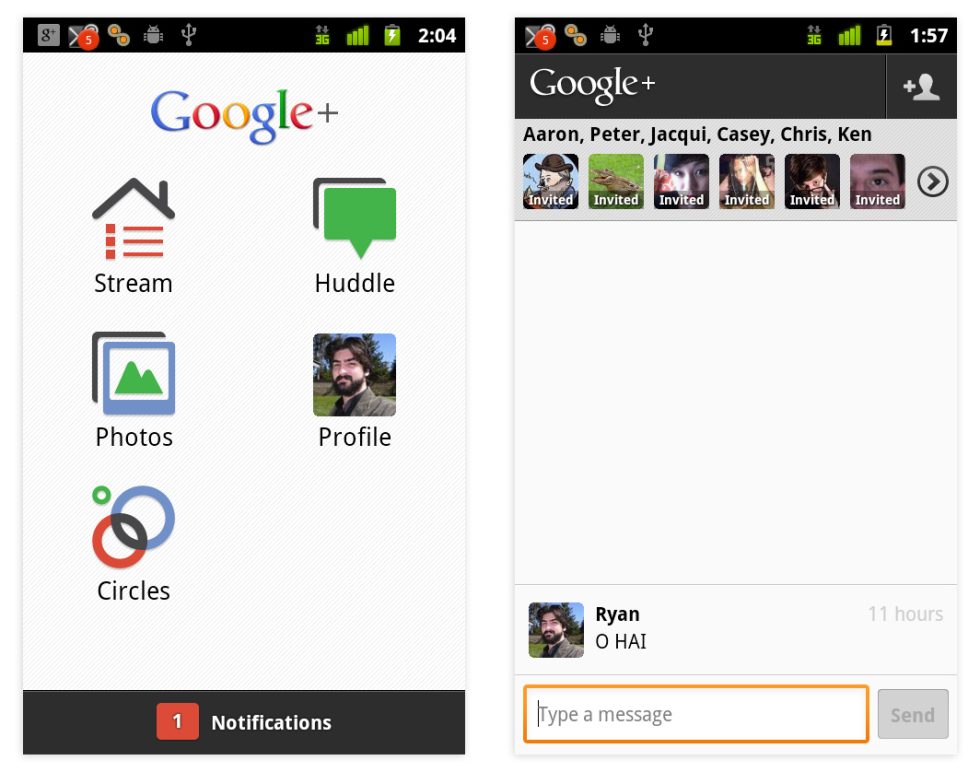
Google+'s very first messaging service was "Google Huddle," a name that almost no one remembers. That's because Google Huddle launched with G+ in June 2011, but this service became "Google+ Messenger" by September 2011. Apparently, there used to be a startup called Huddle that owned the global trademark, and Google quickly agreed to change the name. Whoops.
Google+ Huddle Messenger was an exclusively mobile group messaging service. Google+ always had a "mobile-first" design, but for some reason, for Google+ Messenger, "mobile-first" got turned into "mobile-only." This was a constant source of frustration for users. Messenger was just the world's most basic group texting app, and you could invite anyone in your Google+ circles to join.
The service got a front-page promotion on the Google+ Android and iOS apps, but other than that, it never really went anywhere. You could send text—and only text—to a group... and that was it. It made sense to be able to DM people on Google+, but did it make sense for that app to be the totally siloed Google+ Messenger mobile app? Not really. Messenger always felt like an afterthought, and after two years of zero improvements, the feature was killed on August 14, 2013.
A competitor emerges—iMessage has entered the chat
Lifetime: October 12, 2011-Present
Clients: iOS, macOS, WatchOS
 iMessages from iOS 5.0.
iMessages from iOS 5.0. The Mac version.
The Mac version. Today iMessage looks like this. Blue for iMessage, green for SMS (aka Android users).
Today iMessage looks like this. Blue for iMessage, green for SMS (aka Android users).
And now, a brief history of Apple Messaging services: iMessage. End of article.
Apple launched iMessage along with iOS 5 in October 2011 and brought iMessage to the Mac with the release of OS X 10.8 Mountain Lion the next year. Apple did not release a second, competing messaging app 18 months after the launch of iMessage. In fact, Apple has never launched a competing messaging app in the nine years this service has been around. The full power of the company is behind iMessage with no other distractions.
iMessage quickly became the template for what users wanted from a Google Messaging system. Apple's service was the SMS client on iOS, but it also pushed people over to the enhanced iMessage service whenever possible. Therefore you could use iMessage to communicate with everyone, no matter what. As Apple was fond of saying at the time: it just worked. iMessage messages synced to your Mac, and eventually, SMS forwarding arrived in 2014, so I guess you can say that's when the service fully powered-up.
We'll later see Google acquiesce to the wishes of carriers and put SMS on a pedestal, but Apple was the polar opposite. Cupertino couldn't care less about the feelings of AT&T et al. Carriers were apparently blindsided by the announcement of iMessage and Apple's commandeering of SMS. I think it's funny that this happened the same year AT&T's iPhone exclusivity ended and Verizon finally got to launch an iPhone. I like to imagine Apple said something like, "Hey carriers, multiple partners means you are all now considerably less valuable to Apple! We're going to kill SMS. If you don't like it, there's the door." The truth, though, is that Apple didn't even feel the carriers were important enough to communicate with them.
We're not covering the full history of iMessage, but naturally having the full weight of Apple behind the service makes it a very competitive messaging app. It has group chat, end-to-end encryption (for iMessage messages), voice messages, FaceTime video calls, and a million other features.
The big downside to iMessage is that it only works on Apple products, and there's no website, which is pretty limiting compared to the usual "works with everything" client smorgasbord from (good) Google products. Just like BBM, Apple views this as a type of lock-in, though. Apple is a hardware company, and you're supposed to only buy Apple products. This also means Apple sees iMessage as a solvent business since more lock-in means more hardware sales.
The hardware lock-in limits the install base iMessage can have, though, since not everyone wants or can afford Apple hardware. The result is that while iMessage is great, you won't see it on a "most popular messaging services" list.
One more competitor—WhatsApp is now worth $22 billion

By 2012, WhatsApp had become one of the world's most popular messaging apps and was announcing explosive metrics like 10x more messages per day than it had seen the year before. The app doesn't have much of a presence in the US, but it is extremely popular in India, Europe, Africa, and Latin America. In late 2012, rumors started swirling that the then-independent company was taking acquisition bids. The first bit of smoke was from a TechCrunch report in December 2012, saying that Facebook was sniffing around. WhatsApp shot the rumor down publicly, calling it "not factually accurate." Next up was an April 2013 report from DigitalTrends saying Google was negotiating a WhatsApp buyout for $1 billion. WhatsApp shot down this report, too.
It's hard to believe any of WhatsApp's denials since just a year later, the company really did end up selling—to Facebook—for a deal that ended up being valued at $22 billion. There was apparently a bidding war going on, and, according to a report from Fortune, Google tapped out at $10 billion. Google's $10 billion bid would have been the company's second-largest acquisition ever, after Motorola. Instead, Facebook's valuation of the messaging market was in a completely different league from Google's, and it turned the deal into one of the biggest tech acquisitions ever.
WhatsApp was a company that was only five years old at the time and had only 50 employees, yet it ran rings around Google's messaging efforts (which is a truly embarrassing situation). It's the perfect example of how harmful Google's lack of focus can be. From 2009 to 2014, WhatsApp built a messaging app worth $22 billion that boasted 450 million users. From 2009 to 2014, Google launched five different messaging apps.
Pre-Facebook acquisition, WhatsApp also answered the question of, "How do you make money with a messaging service?" WhatsApp made money through the innovative scheme of charging money—it cost $1 to sign up and $1 a year going forward. WhatsApp originally did this to slow user growth to a manageable amount and cover the cost of sending initial SMS sign-up texts. The founders were apparently shocked to see that $1 didn't hurt people's appetite for the app, and it just remained a paid app.
If Google had spent the money to buy WhatsApp, today it would probably be a messaging powerhouse. Instead, the messaging rich got richer, and Facebook was able to control the WhatsApp user base along with its already popular Facebook Messenger service. I think most observers would say Facebook understands social networks and messaging more than Google could ever dream of, and it's interesting that Facebook treats messaging as a pillar of the company. It's something the company is willing to spend tens of billions of dollars on, while Google is content to let messaging languish as a series of unstable side projects.
We recently got an amazing bit of commentary on this series of events from Apple, which ended up having some of its internal communication aired out in public thanks to the Epic Games case against the company. When the first "Google's buying WhatsApp!" rumors started swirling, Apple's SVP of Internet Software and Services, Eddy Cue, started pitching the idea of a response to what he saw as a formidable Google/WhatsApp combination. Cue asked the other Apple execs, "Do we want to lose one of the most important apps in a mobile environment to Google?"
Hearing a high-ranking Apple exec call messaging "one of the most important apps" is, again, strikingly different compared to how Google normally runs messaging. At any point in the last 15 years, messaging has almost always been a complete afterthought in the company's lineup. Cue wanted to respond to Google/WhatsApp by going really hard and bringing iMessage to Android instead of keeping it the Apple-ecosystem exclusive it is today. Other execs were skeptical of the move, and the plan never happened, but it shows again how Google buying WhatsApp could have been a major turning point for the industry.
Cue (and Facebook) were definitely right about the future of WhatsApp. WhatsApp had 450 million monthly active users at the time of the Facebook purchase, and today the app has grown to over 2 billion users. Google has released another five messaging apps in that amount of time and still doesn't have a stable or successful messaging platform.
Google Docs Editor Chat (2013)—Just like Gmail chat, but not integrated with anything
Lifetime: June 6, 2006 (Sheets)/April 25, 2013 (Docs and Slides)-Present
Clients: Desktop web only
 The very first release of Google Sheets, which then was "Google Spreadsheets Labs" in 2006. It had a day-one chat feature!
The very first release of Google Sheets, which then was "Google Spreadsheets Labs" in 2006. It had a day-one chat feature! Google Docs and Slides only got Chat in 2013.
Google Docs and Slides only got Chat in 2013. This was the 2017, Hangouts-era design.
This was the 2017, Hangouts-era design.
Let's take a minor detour from the major messaging apps to talk about Google Docs. Google Docs/Sheets/Slides is a great online tool for collaborating on a document. And often when you're collectively writing or editing something, you want to have a discussion about it. For that, the Google Docs Editors have a very handy integrated chat service.
Google Docs and Slides got a siloed chat feature in 2013, but if you want to get really technical, Sheets first had chat at launch, all the way back in June 2006, when it was "Google Spreadsheets Labs." The other Google office suite app would be more reliant on an in-line comment system for communication at first (does that count as a messaging service?), though, and it wouldn't get a similar chat feature until seven years later.
This 2013 version of the Google Docs editor chat looked and worked just like Google Talk in Gmail. It actually was Google Talk under the hood, but somehow this wasn't integrated with Google Talk. Google Docs throws everyone looking at a document into a single group chat, and combined with the fact that some documents could be public, maybe that didn't jibe with Google Talk's contact security model.
If Google could have made everything work, Gmail's use of a real chat service still seems like a more convenient solution. While Google Talk works everywhere and will pop up on your phone, Google Docs Chat is awkwardly only available through the desktop web app, which means you'll only get a message if you are sitting in front of a computer with that specific document open. I am always first invited to look at a Google Doc through a real messaging service, like Hangouts, and then at some point we have to awkwardly stop talking on Hangouts and start talking to Google Docs just to get the convenience of having everything in a single window. If I leave early and someone asks a late question, that question doesn't arrive if it's asked through Google Docs. The weird thing about Docs and Gmail is that the interfaces are nearly identical—pop-up chat boxes that you can type in—but Gmail's is so much more reliable and convenient thanks to being plugged into a real chat service.
Like we discussed in the Google Talk section, thanks to sharing some back-end functionality with Google Talk, the 2017 shutdown of Google Talk disrupted Docs chat for a bit while it switched to Hangouts. What's crazy about that timeline is that Google Docs and Slides implemented Chat in 2013, one month before Google Hangouts launched. This capped off months of rumors about Google's new chat service, so surely the Google Docs team knew Talk was on the way out. Yet, it launched the feature based on Talk technology anyway. Skate to where the puck is going, people!
Google Hangouts (2013)—Google's greatest messaging service
Lifetime: May 15, 2013 to Present
Platforms: Android, iOS, the web, web Gmail, Windows, Mac, Linux, Chrome OS, Android Wear, Google Glass
 For a time, Google Hangouts was "Google+ Hangouts."Google
For a time, Google Hangouts was "Google+ Hangouts."Google The day-one Android app.
The day-one Android app. Blob emojis and an ongoing video call.
Blob emojis and an ongoing video call. Would you believe Android used to have tablet apps?Google
Would you believe Android used to have tablet apps?Google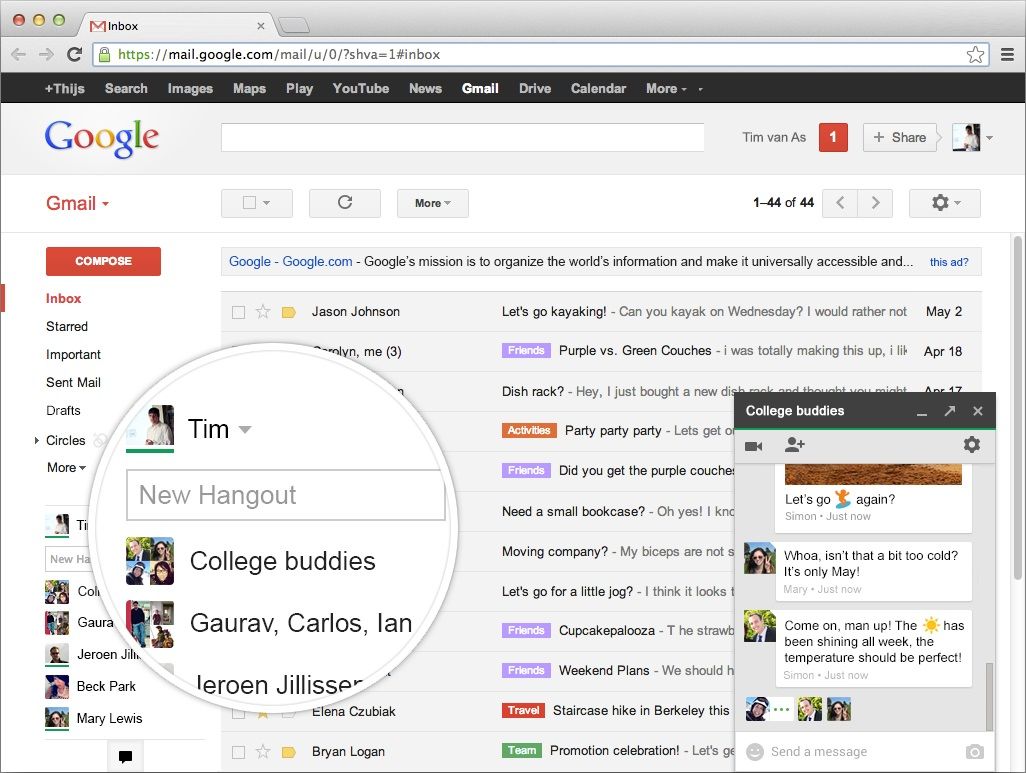 Just like Google Talk, Hangouts also worked in Gmail.
Just like Google Talk, Hangouts also worked in Gmail.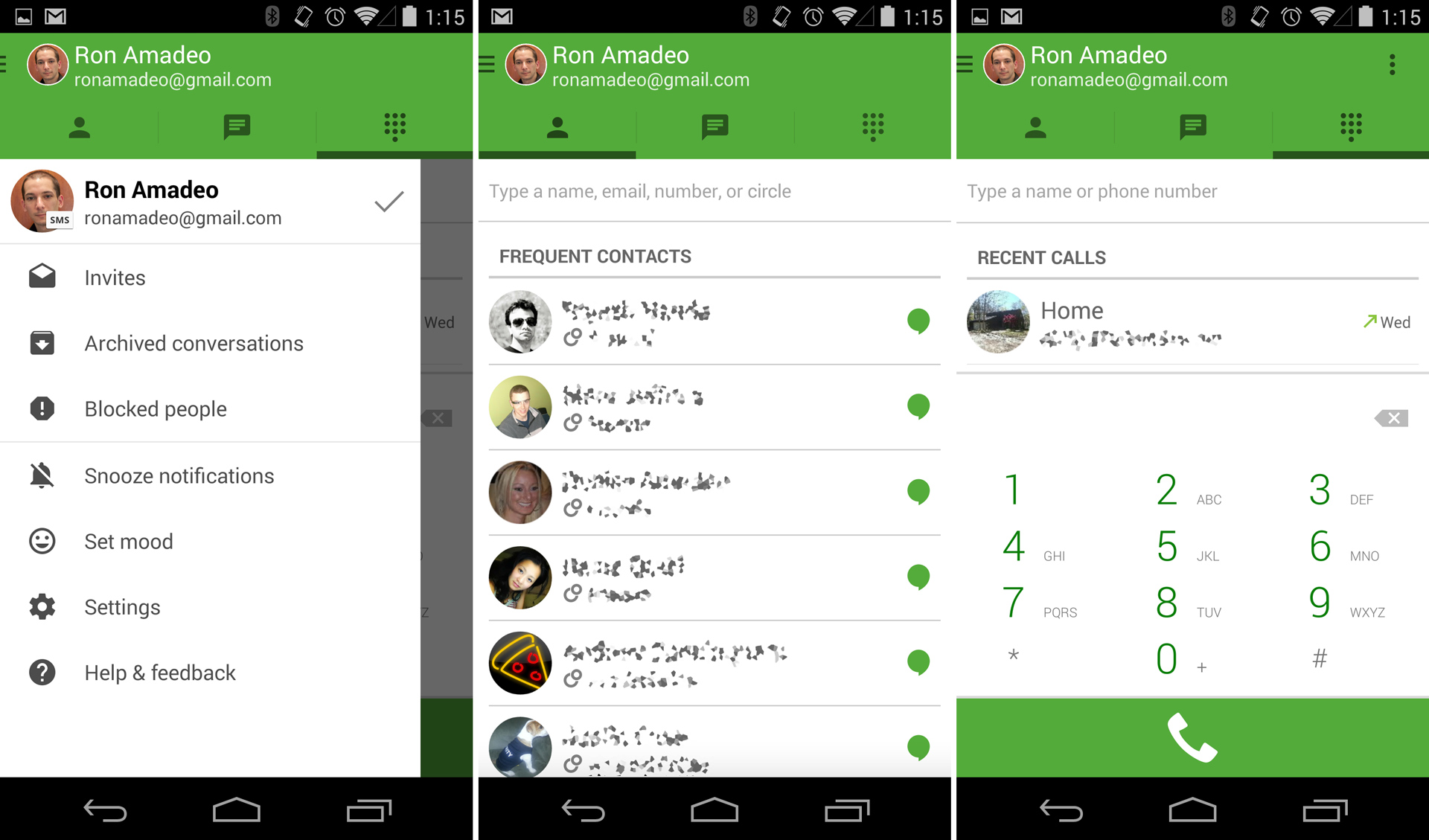 Who could forget the butt-ugly, puke-green version of Hangouts that launched in 2014?
Who could forget the butt-ugly, puke-green version of Hangouts that launched in 2014? By the end of 2014, you could quickly switch between Hangouts, SMS, and Google Voice just by tapping the button to the left of the input field.
By the end of 2014, you could quickly switch between Hangouts, SMS, and Google Voice just by tapping the button to the left of the input field. The current (and, I guess, final) Android design for Android.Google
The current (and, I guess, final) Android design for Android.Google
Circa 2013, Google was running into a problem—way too many messaging apps. If you were a Google user and wanted to message someone, you could IM them on Google Talk, send an SMS from Android's texting app, send them an SMS through Google Voice, or fire up Google+ Messenger. Google's plan to solve the problem of four messaging apps was... to develop a fifth messaging app.
This messaging app would eventually be a great unifier, though. Rumors of Google's super messaging platform started as early as 2012, with one Google product manager admitting to the media Google was doing "an incredibly poor job" meeting the needs of messaging users (you don't say?). By 2013, rumors of an IM project codenamed "Babel" were regularly popping up, promising a unified Google messaging solution.
At Google I/O 2013, Google announced that Hangouts would turn from a video app into a full-blown messaging service. During the presentation, Google pitched an idea that some messaging services still can't offer: a client that can do text, photos, and video chat, across all devices, on any OS. On day one, Hangouts was everywhere. There were clients on Android, iOS, and on any desktop via the Gmail website or a standalone Chrome extension (which was indistinguishable from a native app). That last bit worked on Windows, Mac, Linux, and Chrome OS.
Hangouts' default list view showed conversations instead of people, mixing in one-to-one chats with group chats. Any photos shared to a room would be saved in a Google+ Photos album, and text history is saved forever (if you want) in Gmail and synced across devices. Hangouts' G+ integration meant you could add entire circles to your group chats or add people through a simple checkbox UI. Google Talk pre-dated the invention of Unicode-standard emojis, so Hangouts was Google's first messaging service to ship with a comprehensive set of the little glyphs. There were read receipts and animated typing indicators, and since this was based on Google Hangouts the video chat app, a single button push could drop everyone into a group video call.
Google Hangouts replaced Google Talk, and the existing user base got an in-place upgrade, a move that should be a benchmark for how serious Google is about any given messaging app. In the future, a thousand Google Messaging apps will rise and fall after the launch of Hangouts, but only one, Google Chat, will be deemed worthy enough to inherit this user base. The desktop version of Gmail swapped out the Google Talk sidebar for a Hangouts sidebar, which was functionally very similar. On Android, Hangouts shipped as an upgrade to Google Talk, and to this day it has the same package name as Google Talk: com.google.android.talk.
The in-place upgrade strategy led to a huge overnight explosion of Google Hangouts users. Android would pass 1 billion activations in a few months, and Google Talk was a preinstalled app since the beginning. All of those still-active Android users would become Google Hangouts users once they checked for app updates. A year earlier, Google announced Gmail was the world's biggest email service, with 425 million active users. Now all of these people were on Hangouts.
Hangouts also started the death of XMPP messaging for Google's biggest messaging service. All the federation work that Google started with Google Talk wasn't making the jump to Hangouts. XMPP clients like Adium and Pidgin could still connect to Hangouts, but they would have to do it with Google credentials. Non-Google users wouldn't be able to connect to the Hangouts service through a federated server the way they could with Google Talk. Even with Google credentials, XMPP clients on Hangouts were second-class citizens and didn't get access to many features.
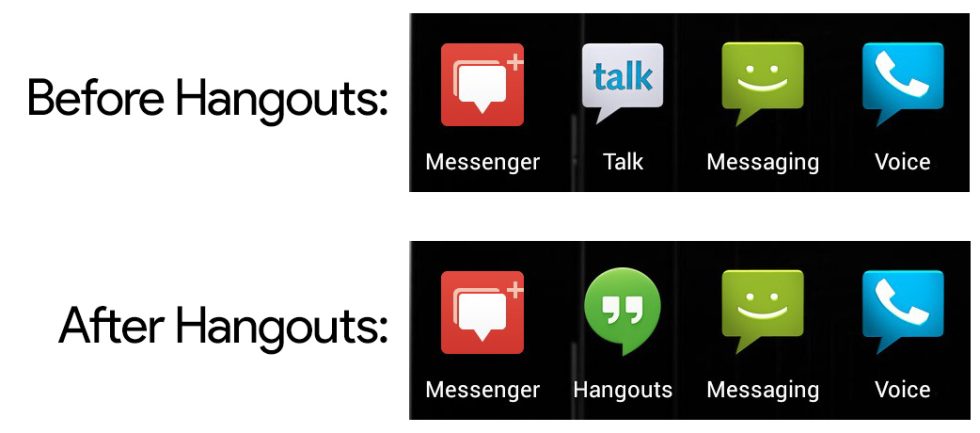
On day one, Hangouts was a bit of a disappointment. Those hoping for a unifying Google messaging service, like the rumors promised, didn't get one. We started with four services—Google Talk, Android SMS, Google+ Messenger, and Google Voice. And in the immediate aftermath of the Hangouts launch, there were still four services—Hangouts, Android SMS, Google+ Messenger, and Google Voice. Nothing was actually unified. There were also a few missing features compared to Google Talk, like the lack of audio calls and presence indicators. This is the minimum viable product launch strategy in action, and the disappointment is standard. A lot of Google services never recover from the initial negative reaction, but Hangouts did.
The key to overcoming MVP disappointment is to rapidly ship updates, and Hangouts did that. Three months after launch, in August 2013, Google+ Messenger was killed, and the company was down to three messaging apps. October 2013 brought the long-anticipated Hangouts SMS integration on Android. Users could register Hangouts as the default SMS app, finally giving Android users an equivalent to Apple's iMessage on iOS. That month also brought the release of Android 4.4 KitKat, where there was no default "SMS" app for Android anymore, there was only Hangouts (so if counting, we're down to two apps). Google finally delivered on the full promise of Hangouts when, by late 2014 around a year and a half after launch, Hangouts finally added Google Voice support. These features all arrived slower than any Hangouts user would like, but finally, there was one Google messaging app to rule them all.
At this point in 2015, Google Hangouts was at the height of its powers. To date, it's still the greatest messaging service Google has ever produced. It worked on every platform. It pulled in SMS, Google Voice, and regular Hangouts messages. They were all stored in a seamless, merged history of messages from each contact, and you could switch message delivery systems via an easy drop-down menu. It had most of the features you could want, like video calls and location sharing. And accordingly, by June 2015, the app hit a billion downloads, just on Android. A dedicated Hangouts website, hangouts.google.com, would launch in August.
The death of Hangouts, unified Google messaging, and hope
Hangouts' reign as Google's unified messaging service held together for about one year, basically the entirety of 2015. By the end of December, Google couldn't help itself and there was already talk of a new Google messaging service that was gearing up to launch, but this time with chatbots (this would eventually be Google Allo). Also in 2015, Hangouts development was already going slower than people would like, and the neglect was starting to be visible.
Google actually caved on an iMessage-style SMS takeover a year earlier, in 2014. The company pushed forward the bold direction of running all SMS messages through Hangouts in the 2013 release of Android 4.4 KitKat, which didn't include any other SMS app. Carriers complained soon after, and Google immediately sided with carriers over users, shipping what the company described as a "carrier-centric" SMS app, Google Messenger, in Android 5.0 Lollipop. Around 2014, the iOS/Android duopoly was not set in stone yet, and with Google still fighting Windows Phone 8, it didn't want to upset carriers and give Microsoft an opening for success. Hangouts' SMS support would still hang out for a few more years, but Google proved it didn't have the stomach to do anything the carriers didn't enthusiastically approve of.
Hangouts collapsed about as quickly as it was built. Despite the superior functionality on Hangouts, Google started pushing users to switch SMS usage from Hangouts to the "carrier-centric" Google Messenger SMS app in early 2016. At Google I/O 2016 in May, Google Allo was announced, a new messaging service that would ship with lots of bells and whistles that could have been helpful to Hangouts. By October 2016, Hangouts was no longer a default Android app, having lost its spot to Allo.
Hangouts started being stripped of features, but it was never enough to kill the app. In May 2017, Hangouts was stripped of its SMS functionality. In December 2018, Google announced a formal plan to kill Hangouts and transition users (many of whom have been around since Gtalk) over to yet another Google Messaging app, Google Chat, which was first built as a competition to Slack for G Suite. The Wear OS Hangouts app died in 2019, and location sharing and audio calls were ripped out of Hangouts in 2020.
Yet actually killing Hangouts has proven incredibly difficult for Google—mostly due to how many clients there are and how widespread it is. Despite the late 2018 shutdown announcement, Google hasn't made a ton of progress in 2019 and 2020 toward replacing Hangouts. The latest timeline said that optional upgrades for consumers to Google Chat will start in 2021, and Google Voice support will die in 2022. There's still no actual shutdown date.
Google Hangouts was the gold standard of Google Messaging apps, and the app has cast a long, dark shadow over all of Google's up-and-coming messaging services. From here on out, any complaints about newer Google Messaging services almost always revolved around the quote, "Hangouts did this better." If Google could have just taken care of Hangouts over the years and thrown the full weight of the company behind this single messaging service, today it might have an iMessage-fighting, WhatsApp-rivaling message app, and I probably wouldn't be writing this article. Google just could never throw the full weight of the company behind a single messaging app, and soon Google would move on to a new shiny bauble, leaving Hangouts to rot.
Google Spaces (2016)—A messaging app for Google I/O 2016 attendees
Lifetime: May 16, 2016—March 3, 2017 (8 months)
Platforms: Android, iOS, the Web
 L-R: The list of spaces, an individual space, and chatting in a space.
L-R: The list of spaces, an individual space, and chatting in a space. The Spaces activity stream and a message notification.
The Spaces activity stream and a message notification.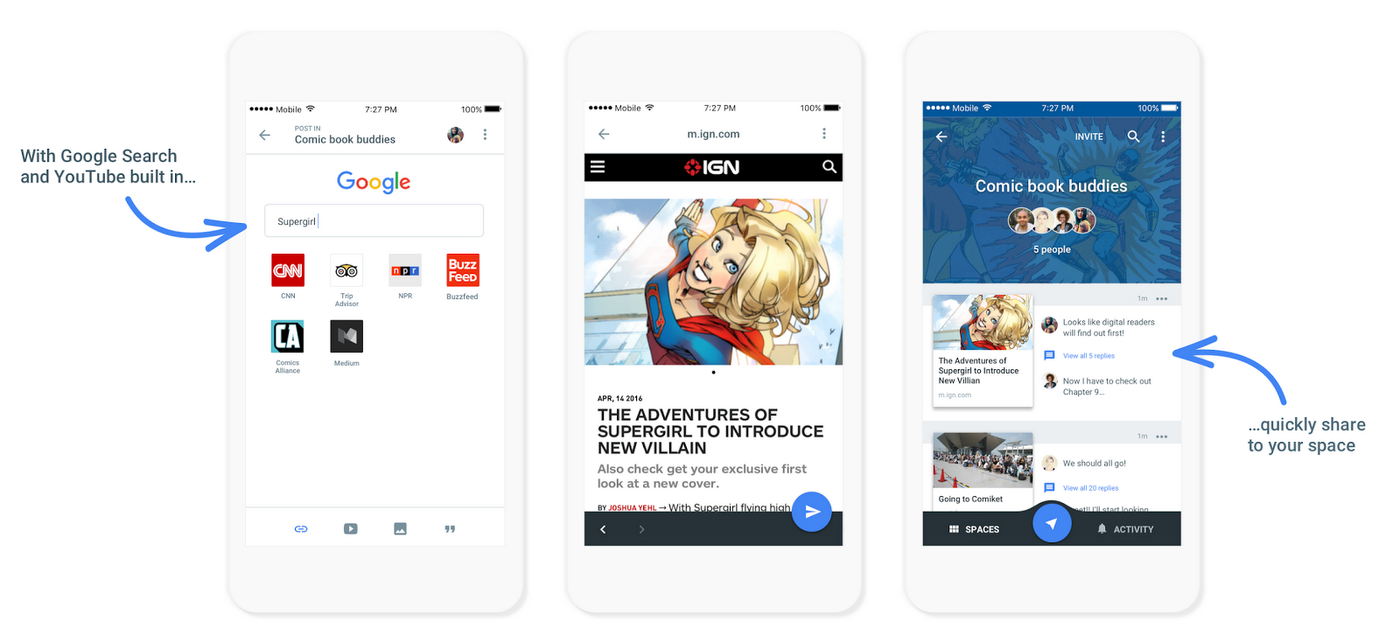 The app had a built-in Google search and web browser, for easy sharing.
The app had a built-in Google search and web browser, for easy sharing. The desktop site was just the phone app, but bigger.
The desktop site was just the phone app, but bigger.
Google was really in the messaging mood at Google I/O 2016, where the company launched not one, but two messaging apps. The first was a completely baffling app called "Google Spaces," a group messaging service for "small group sharing."
Spaces were basically chatrooms that you could share stuff to. You could create a room around a certain topic, invite people to it via a URL, and then people could post messages, photos, and links into the room. That was pretty much it. There were apps for the web, Android, and iOS, and the mobile apps would ship you notifications whenever someone posted a new message. Each space room looked identical to a messaging app, while an "activity stream" would show all the new stuff from all your spaces (that looked like a social network stream).
Spaces' only unique feature was the odd choice to have Google Search "built-in." Instead of just copying and pasting a link to something from an outside app, Spaces would let you fire up a built-in web browser and navigate around the web. The Spaces web view would pin an easy "share to space" button at the bottom of the screen, but was copying and pasting a link really that difficult?
Spaces had no real use case and no real appeal. Some takes compared Spaces to Slack, just with extremely limited functionality. Others express bewilderment that spaces looked and worked pretty much exactly like a Google+ Community, but detached from Google+ and without any cross-functionality. A big problem was that there wasn't any moderation functionality at all, so if anyone got your Spaces URL and decided to be a jerk, there was nothing anyone could do about it.
Looking back, Spaces seemed like it was an app built specifically for Google I/O 2016. For those three days, every Google developer talk had a "Space" where you could download the slides and see other related media. Google even pitched Spaces this way in the introductory blog post:
We’ll also be experimenting with Spaces this week at Google I/O. We’ve created a space for each session so that developers can connect with each other and Googlers around topics at I/O, and we've got a few surprises too. If you’re joining us in person at I/O, make sure you install Spaces on Android or iOS before you arrive!
Once everyone flew back home from Google I/O, the app was basically dead. As far as I can tell, Spaces never got an update or a new feature. Spaces worked for a whole eight months before posting was shut off on March 3, 2017, and Google deleted all the data the next month.
The life and death of Spaces raises an important question: Does anyone at Google do quality control for these things? Is there any gatekeeper at all? Someone that says, "No, this isn't good enough to put the 'Google' name on?" Does anyone demand that launching a product comes with some kind of support commitment? It seems like the answer to all these things is "no," and that's really a tough way to run a brand. Some Google divisions are out there building long-term, well-supported products The Right Way™, like Android and Chrome, and they get lumped in with fire-and-forget products like Space and Allo that destroy trust in the Google brand.
As consumers, it's impossible to tell from the outside if a new product actually has a real commitment at Google, or if it's just being shoved out the door to fluff up someone's résumé. There needs to be some kind of standard for a product launch, and Space suggests there isn't.
Google Allo (2016)—Google's dead-on-arrival WhatsApp clone
Lifetime: September 21, 2016—March 14, 2019 (2 years, 5 months)
Platforms: Android, iOS, Phone-based web interface
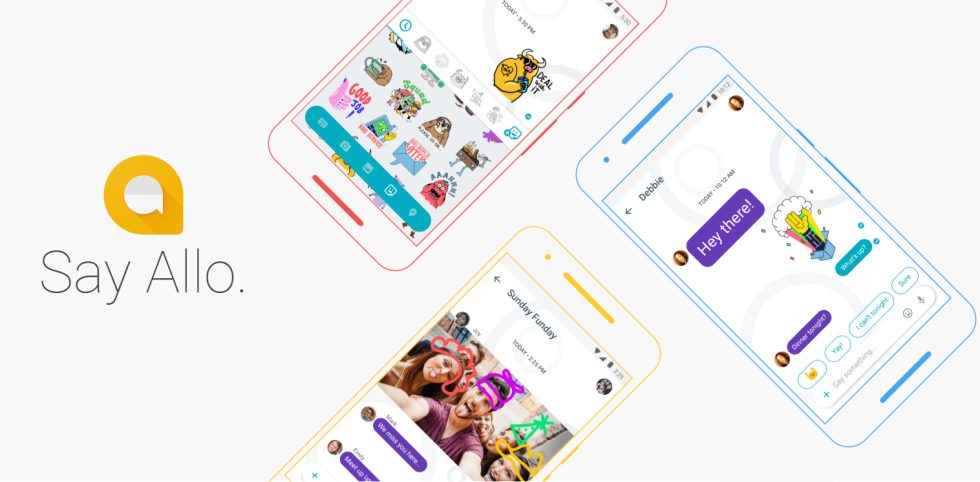
Google lost out on purchasing WhatsApp in 2014. So just over two years later, at Google I/O 2016, Google announced a pair of apps that seemed aimed directly at the one that got away. "Google Allo" was a straight-up clone of WhatsApp with some minimal Google magic, and Google Duo was a dead-simple "companion" video app. Allo would go on to be one of the biggest flops in Google Messaging History. After a high-profile announcement on the Google I/O stage, the app launched a few months later in September to terrible reviews. It plummeted off the download charts in just a few months. The problem with cloning WhatsApp is that WhatsApp had a billion users at this point in 2016, and Allo had zero users. To say nothing of the many show-stopping feature deficiencies of Allo, why would anyone that likes WhatsApp-style apps use Google's WhatsApp clone when actual WhatsApp existed? No one had an answer for that, and Allo was a disaster.
Allo took Google's strategy of the Minimum Viable Product and turned in less functionality than ever. At launch, Allo only worked on phones. There wasn't a web app or Chrome extension that would allow desktops and laptops to receive messages, and the support for iOS and Android tablets ranged from terrible to impossible-to-use. The limited device support wasn't just from a lack of clients. Allo only supported signing in to one device at a time, anyway—if you signed in on device #2, the Allo on device #1 would shut off and stop receiving messages.
All of Allo's strange client problems were due to it being a WhatsApp clone and to it being targeted at India. Allo didn't use your Google account at all, and instead relied on your carrier's phone number for identification. Users would have to make a new Allo account that was powered by the carrier's SMS system, and it felt totally crazy to have to tell Google—a company that is supposed to know everything about you—basic info like your name and profile picture. Being locked to a SIM card was why Allo only worked on one device. That's just the way SIM cards work. Browsers also don't have a SIM card, so you couldn't log in on a browser.
This account system made sense for WhatsApp, which had no existing account infrastructure or userbase, and a target audience of people that were relatively new to the Internet and don't have a ton of devices. For Google though, people interested in a new Google product usually already have a Google account. The Google ecosystem is supposed to be a core part of the sales pitch. Allo just threw all of that out the window.
 Google Allo was mostly a basic messaging app.Google
Google Allo was mostly a basic messaging app.Google You logged in with a phone number, and even if you had a Google account, Allo didn't know your name.Ron Amadeo
You logged in with a phone number, and even if you had a Google account, Allo didn't know your name.Ron Amadeo Allo only supported one device at a time.Ron Amadeo
Allo only supported one device at a time.Ron Amadeo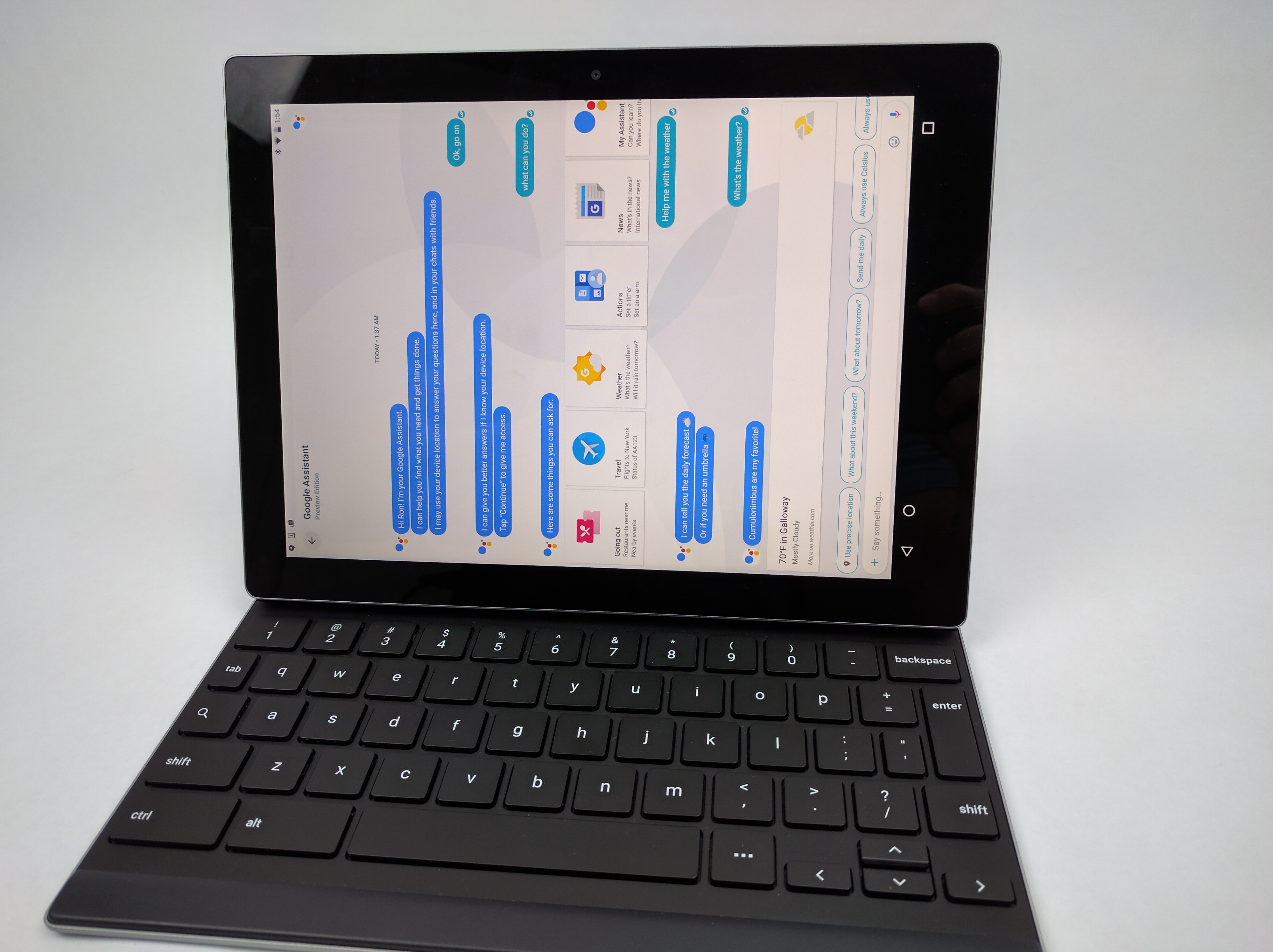 Allo on a Pixel C. It didn't support landscape mode, so it wasn't useable with the keyboard.Ron Amadeo
Allo on a Pixel C. It didn't support landscape mode, so it wasn't useable with the keyboard.Ron Amadeo One year after launch, when Allo was dead and buried, it got a desktop mode that logged in via a QR code you need to scan with your phone.Ron Amadeo
One year after launch, when Allo was dead and buried, it got a desktop mode that logged in via a QR code you need to scan with your phone.Ron Amadeo
The hype Allo generated as a Google product launch was enough to generate five million downloads in its first five days. After that, Allo completely stalled and would take three months to hit 10 million downloads. Keep in mind these are just downloads—people trying the app—and don't represent people who stuck around and became active users, which, for every app, will be far lower than the total downloads. By January, four months after launch, the app fell off the Play Store's top 500 app list and was completely dead.
Allo shows the ultimate failure of Google's Minimum Viable Product strategy. MVP works when you have almost no competition, or if you are taking a radically different approach to what's on the market, but it completely falls on its face when you are just straight-up cloning an established competitor. There's no reason to use a half-baked WhatsApp clone when regular WhatsApp exists. The whole point of a minimum viable product is to launch, get feedback, and quickly iterate on that feedback, but Allo never did that. The app didn't deliver any substantial new features quickly.
Google only got around to fixing one of Allo's day-one, show-stopping problems—the lack of a desktop app—one year after launch, at which point Allo was already dead, buried, and the corpse had rotted away. Even then, the desktop mode wasn't very good. Authentication was still based on your SIM card, so the desktop app needed you to log in with your phone and then forward that authentication to a browser via a QR code. From there, your phone would forward Allo messages to the web app. The phone was still the key, though. If your phone was missing, or the battery was dead, you couldn't use Allo on the web.
What Google didn't seem to understand at the time is that, like we covered in the earlier WhatsApp section, WhatsApp-style apps are not appealing to the whole world. Google tried to push its poor WhatsApp clone in the US, but even regular WhatsApp is not popular in the US. Apps that rely on SMS authentication don't work well in a multi-device world, and that's OK. Facebook understands this, so it has the Internet-based Facebook Messenger, which works great on multiple devices, has a website that doesn't require your phone, and is generally available everywhere. Facebook also has the SMS-based WhatsApp, which is limited in device compatibility but is super easy to join. These two apps in Facebook's arsenal have divvied up the world; neither app on its own would be popular everywhere.
When even the world's most successful messaging company can't make one app to rule the entire world, I don't understand how one of the worst messaging companies thinks they can crack it.
Allo's legacy: The Google Assistant
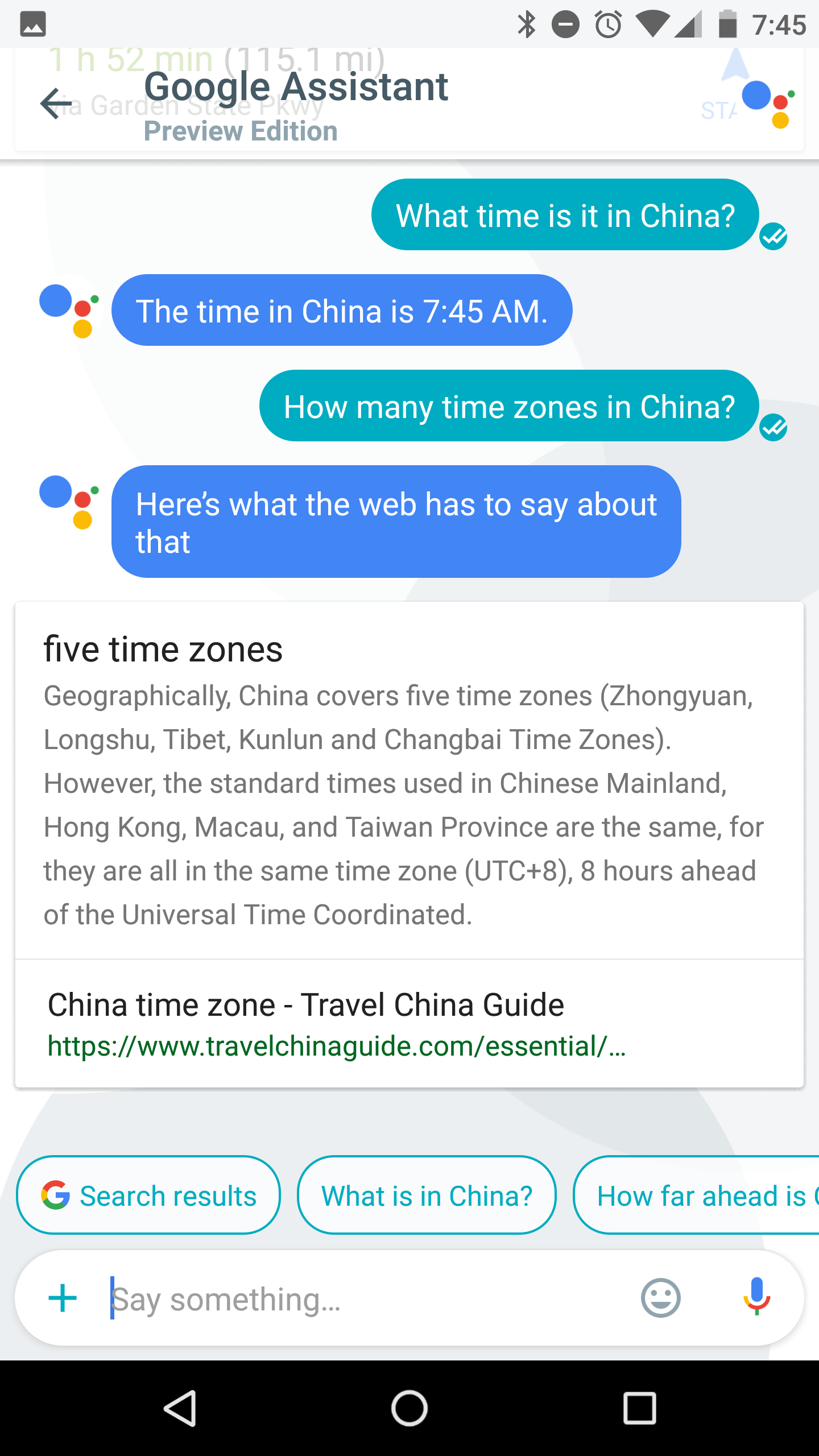 Assistant in action: The first message was successful, so you get a direct answer. The second question was too hard, so you get a Web link.
Assistant in action: The first message was successful, so you get a direct answer. The second question was too hard, so you get a Web link.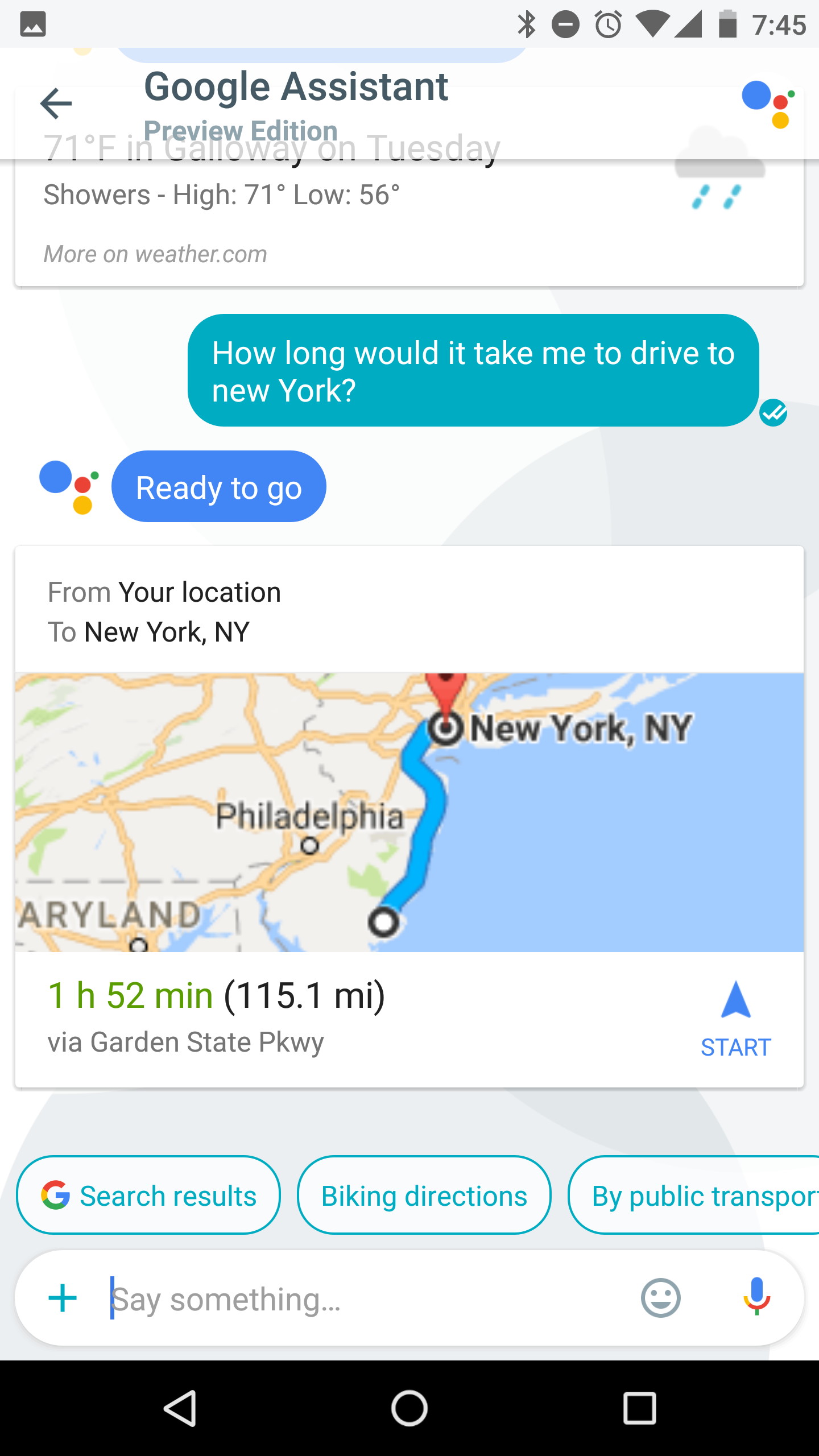 Ask a map question, get a map!
Ask a map question, get a map! Ask Assistant what it can do and you'll get a scrollable carousel.
Ask Assistant what it can do and you'll get a scrollable carousel. Here's every option in that carousel.
Here's every option in that carousel.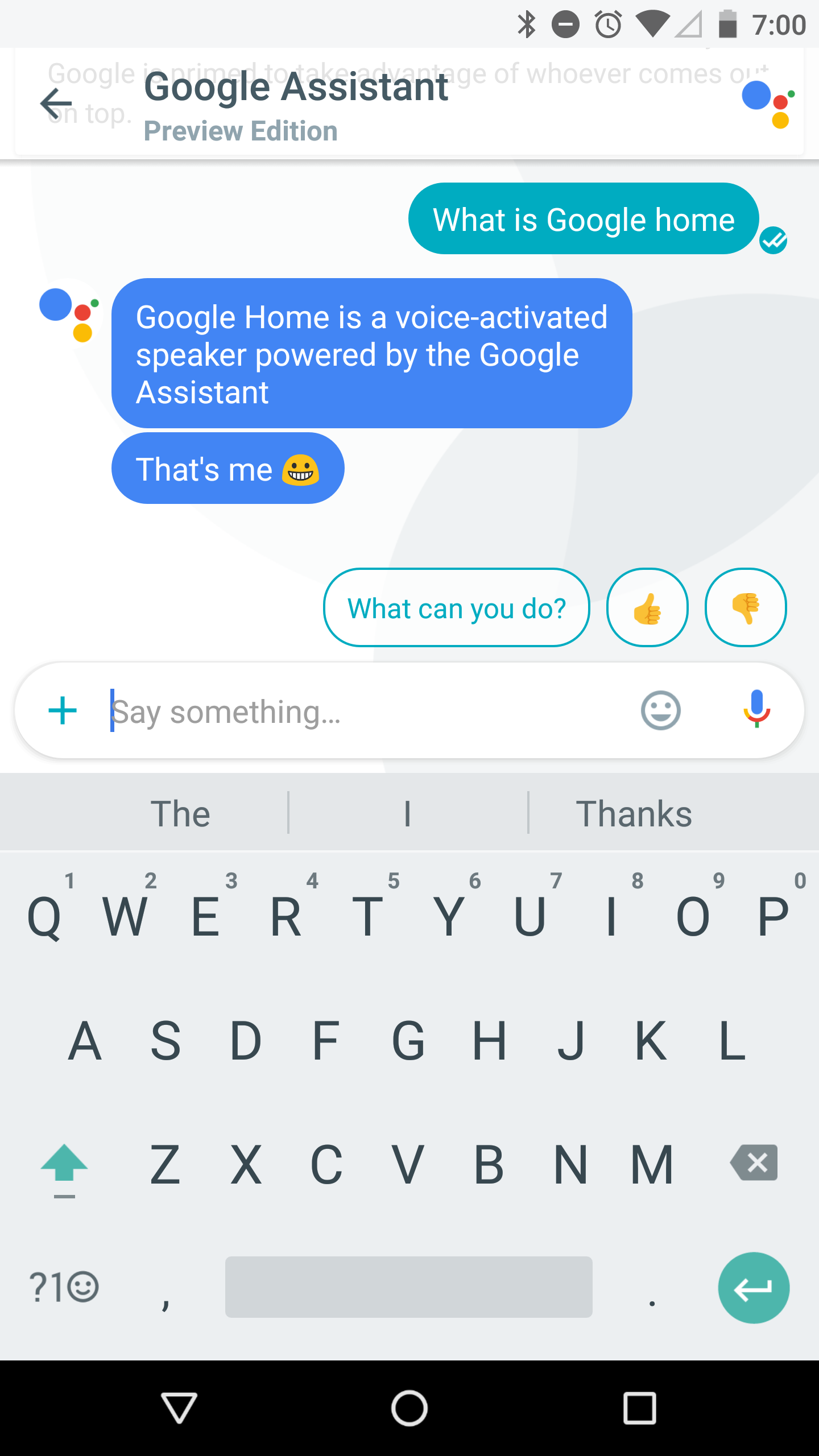 Assistant will be part of Google Home, too.
Assistant will be part of Google Home, too.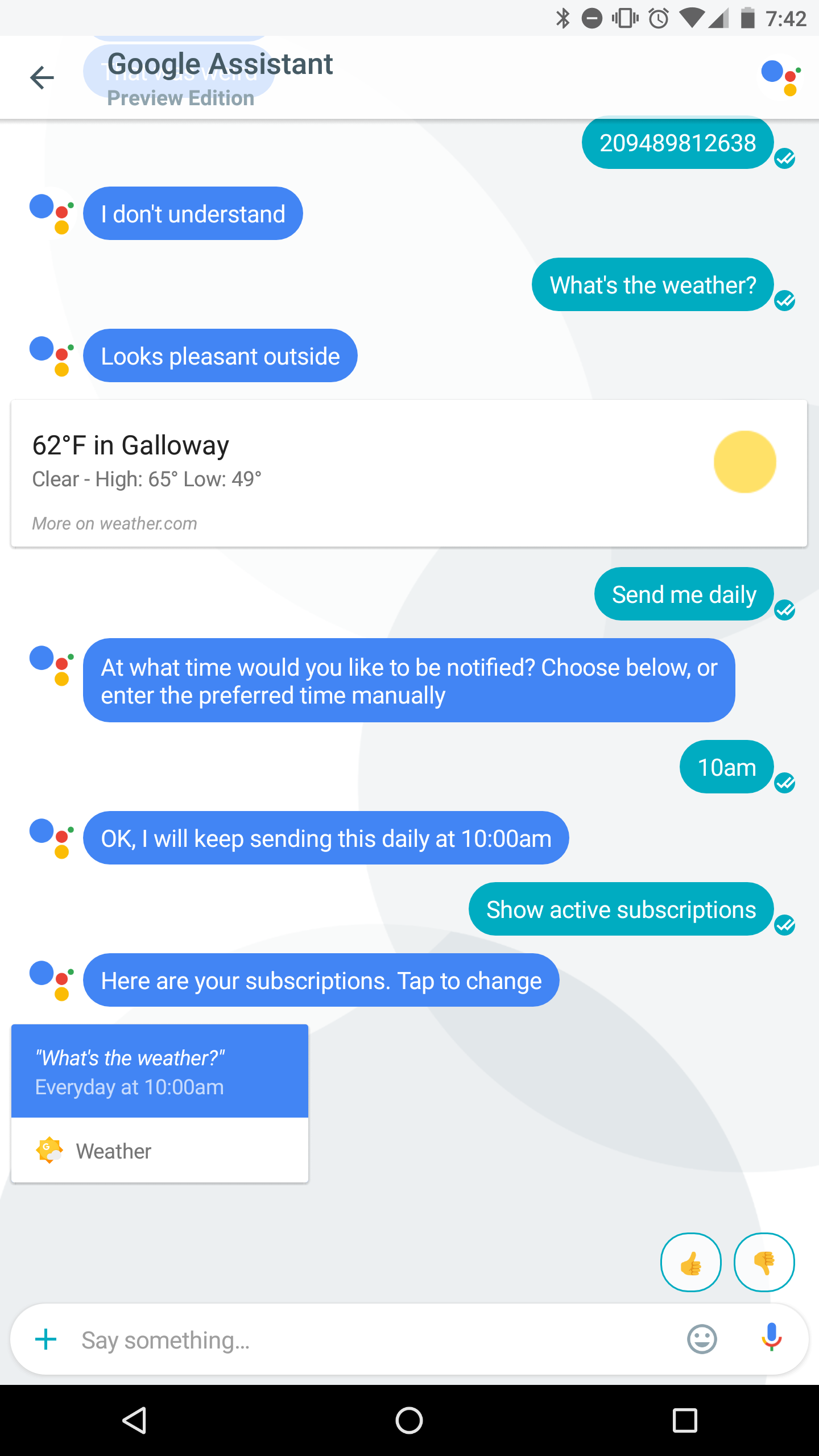 Subscribe to updates for things like weather.
Subscribe to updates for things like weather.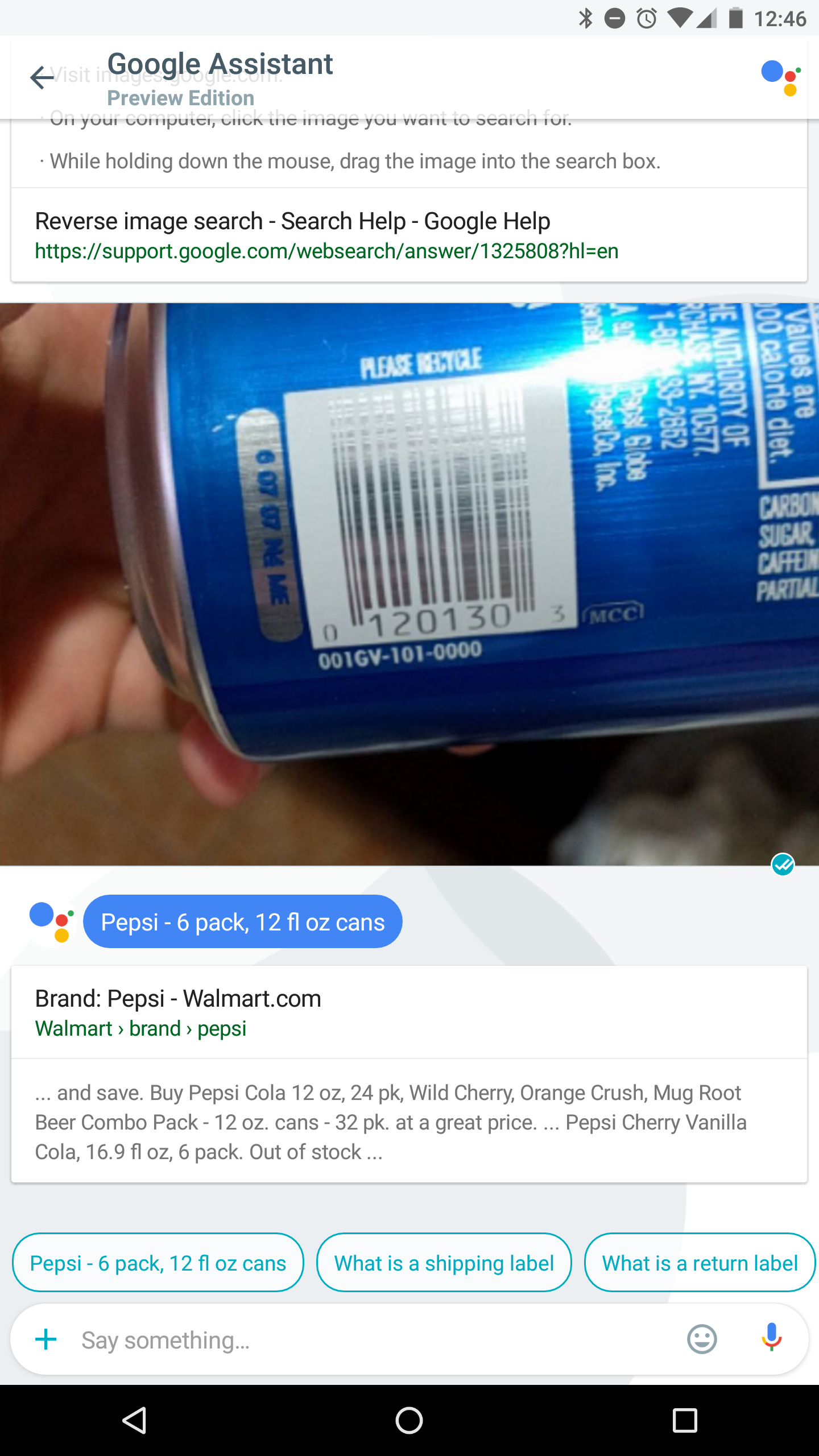 Send the Assistant pictures and get an answer.
Send the Assistant pictures and get an answer.
Allo was DOA thanks to the SMS limitations and competition from WhatsApp, but it did have some interesting ideas. There were stickers and adjustable text sizes, and Google Inbox's machine-generated Smart Replies made the jump to a messaging app. An "incognito mode" would turn on end-to-end encryption, but it wasn't on by default.
Allo's longest-lasting legacy is actually the Google Assistant, which debuted on the service. Allo's text-only (it never spoke) chatbot version of the Google Assistant in September 2016 pre-dated the launch of the feature on the Google Pixel (October 2016) and the Google Home (November 2016). The Assistant in Allo was just like the Assistant in Google's voice products today: You could ask it general knowledge questions, the weather, sports scores, or a million other things. Unlike the current voice interfaces, in the Allo version, the Assistant never talked out loud, it just sent you text messages and showed up as a contact in your chat list.
The theoretically fun part about the Google Assistant in Allo was that you could drag it into a group chat, ask it something like "what time is this movie playing?" and negotiate a time with your group chat. This was all in theory because nobody ever actually used Allo. I really would not mind if the Google Assistant chatbot re-emerged in the next Google IM client.
As an individual chat contact, there wasn't really a great reason to have a running history with the Google Assistant the way you would with a person, but the individual responses were good and useful. Later Google Assistant interfaces would cut off this running history and start with a fresh answer sheet every time, but the interfaces still look a lot like a messaging app.
Most people could tell Allo was instantly doomed from the terrible download numbers, but Google officially kicked off the beginning of the end for Allo in April 2018, about a year and a half after launch, when it announced it was "pausing" Allo development. Allo was shut down a year later, in March 2019
Google Allo was just a slow-motion car crash that never sounded like it had a viable product pitch compared to Hangouts. We criticized Allo before it came out as "not making much sense," we were thoroughly disappointed when it launched, and we made fun of it when it died. It never stood a chance
Google Duo (2016)—A video companion app for... WhatsApp?
Lifetime: August 16, 2016—Present
Platforms: Android, iOS, Phone-based web interface
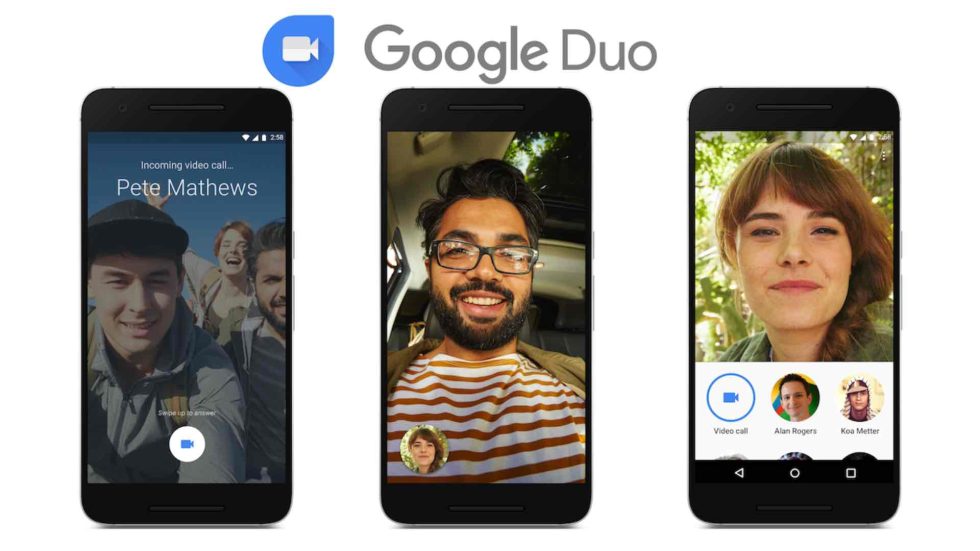
Google Duo technically launched one month before Allo, but it's much easier to understand as a footnote to the Google Allo story. There's almost nothing to say about Duo because it was as basic of a video app as you can get: a simple contact list, a full-screen video feed interface, and not much else. Since, like Allo, it was targeted at India, Google put real effort into making Duo run on as little bandwidth as possible, and Google's video and networking experts built something with a real market advantage.
This might be giving Google too much benefit of the doubt, but maybe the reason Allo was so bad was because Google didn't actually need Allo to survive. Google pitched Duo and Allo as "companion apps," which was a ridiculous idea at the time. Messaging apps have built-in video functionality. Why would you split video and chat into two different apps? The most likely explanation was WhatsApp.
WhatsApp video chat wouldn't launch until November 2016, so as a separate app, Duo could not only be a video companion app to Allo, it could also be a video companion app to WhatsApp. Lots of WhatsApp users ended up using Duo with WhatsApp. Not having Allo would mean Google would be sending the strange message of "go use Whatsapp," a rival Facebook service, and Duo couldn't be paired with Hangouts since that already had video chat. Maybe Allo was a marketing crutch in retrospect?
While Allo is dead, Duo lives on. Today, as a default Android app, it has over a billion Play Store downloads. For years, the app required an SMS-powered account, like Google Allo, but sometime at the beginning of 2020, Google started letting people use Duo with only a Google account. All throughout 2020, Duo did its best to keep up with the world's voracious video demand during the pandemic, increasing from 8 to 12 to 32 video chat members. Duo still couldn't keep up with Zoom though, which allowed people to video chat without any account at all.
Duo's survival makes it one of the strangest Google apps out there. It's part of the Google ecosystem, but it really doesn't feel like it. And Google Meet is clearly the future of Google's corporate and consumer video chat roadmap. An August 2020 report from 9to5Google (which also broke the Google Hangouts/Google Chat merger news) says that someday, Google Duo will "merge" with Google Meet and be shut down. Buckle up, Duo users.
Google (Hangouts) Meet (2017)—Not Zoom
Lifetime: March 9, 2017—Present
Platforms: Android, iOS, Web, custom hardware, Google Glass
 Google Meet! These video chat screenshots are only ever pictures of heads. You can make one or two browser controls, though.Google
Google Meet! These video chat screenshots are only ever pictures of heads. You can make one or two browser controls, though.Google Google Meet for a phone.Google
Google Meet for a phone.Google The old logo.Google
The old logo.Google The new logo.Google
The new logo.Google
In March 2017, six months after the launch of Google Allo and Google Duo, Google announced another messaging and video app pair. This time, the releases were aimed at enterprise organizations. "Hangouts Chat" and "Hangouts Meet" were branding nightmares because they marked the third and fourth time Google has recycled the "Hangouts" brand into a completely unrelated product. Don't confuse Hangouts Chat and Hangouts Meet with either Google+ Hangouts (the video group chat service that launched with Google+ in 2011) or Google Hangouts (Google's unified messaging service from 2013). Hangouts Chat and Hangouts Meet are totally new products, unrelated to anything else. It only took three years after Hangouts Chat and Meet were announced for Google to realize having four separate products called "Hangouts" was too many. Eventually, the company did rename Hangouts Chat to "Google Chat" and Hangouts Meet to "Google Meet."
Hangouts Chat wouldn't launch until about a year after that March 2017 announcement, but Google Hangouts Meet was launched that month. As usual, there is not a ton to say about a Google video chat app. You can join a room. The UI looks like a bunch of camera feeds. There are a few different layouts, like a Brady Bunch-style grid of squares or a thumbnail view.
Hangouts—and I mean old Hangouts, the 2011 consumer video chat version that was absorbed by the 2013 messaging app—only supported 10 video chatters at once. Hangouts Meet supported 30 people at launch, and today, the paid version of Google Meet caps out a questionably-productive 250 people.
Under the hood, both (old) Hangouts and Google Meet do video chat over WebRTC, so there's not a huge difference in the actual video calls. The starting UIs were a lot different, though. Google Hangouts worked like a phone call and would ring any online devices. Google Meet is more of a destination; you link to a conference room that you share over some other form of communication, and everyone has to click.
The biggest legacy of Google Meet will probably be that it's not Zoom, a video conferencing app that absolutely exploded during the COVID-19 pandemic and quickly became a household name. As the pandemic raged across the globe, people were locked down at home and needed a way to communicate for work, school, and fun. Suddenly, everyone in the modern world entered the video chat market, and the world needed to pick a service.
Nine years after the launch of Google+ Hangouts group video chat in 2011, would you believe that Google still wasn't ready for the COVID video chat era? Google was busy re-re-re-re-launching its video chat solution, so it was caught totally flat-footed when COVID hit. Google Meet just barely got off the ground. Meet was locked behind the GSuite paywall until the very end of April, which was about two months into the work-from-home, remote schooling trend in many areas. Meet was also in the middle of a rebrand from "Google Hangouts Meet" to "Google Meet," which was also happening in April 2020, when Zoom was already hockey-sticking up the daily usage charts. That's nine years into the group video chat market, and when the golden ticket hit, Google had no product ready and no brand recognition. Instead, Google was just starting to launch, or really re-launch, a product.
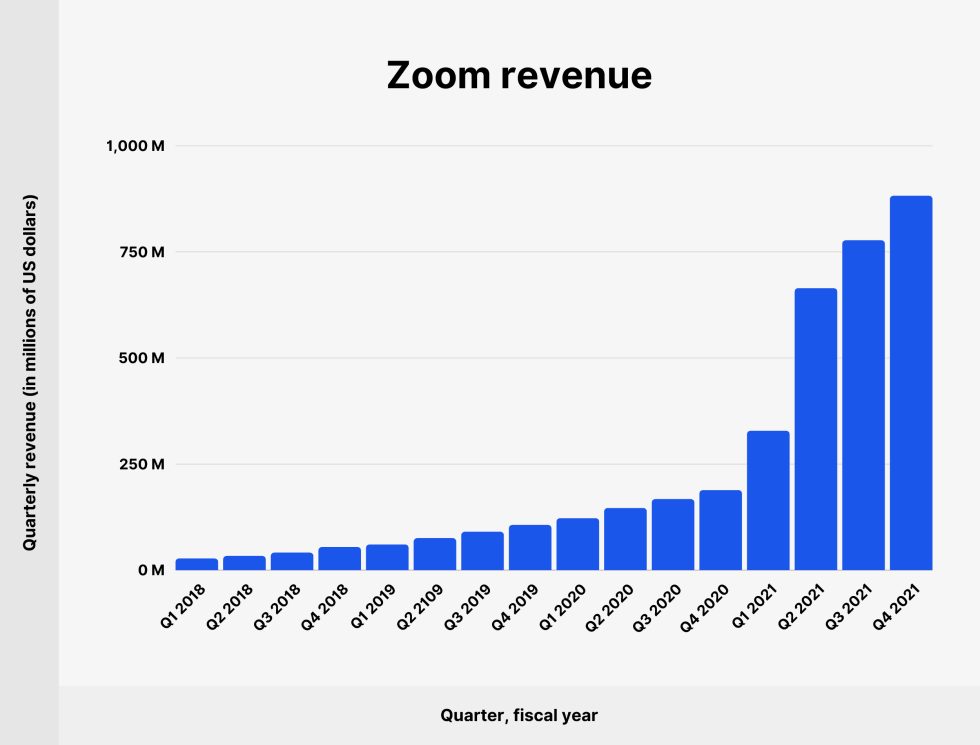
Being paywalled meant Google Meet wasn't viable for the hordes of non-technical users that suddenly needed to roll-their-own work-from-home setup. Any kind of payment, account, or software requirements would need to be repeated for all ~30 people in a meeting, and if you actually wanted to hold a meeting instead of spending all day getting people set up, that meant the meeting software setup needed to be as simple as possible. Zoom was ready. At the start of the pandemic, Zoom had a free tier that worked for most people. Also unlike Google, everyone in a Zoom meeting didn't need a Zoom account—only the meeting owner needed an account. Everyone else just needed to have the app installed and click a link.
Zoom's ease-of-setup turned the company into a rocketship that we might never see again in the tech space. By September 2020, the company was posting insane headlines like (not a typo) a 4000% increase in profits during the pandemic and a 2900% increase in users. Zoom became a household name, and today the service is so popular that "Zoom" is now a verb meaning "to video call someone." I've definitely heard of people Zooming someone on Skype or Google Meet.
By April 2020, The New York Times was already writing about how Zoom had blown past its established rivals, and the report featured this absolutely brutal anecdote from a Google meeting:
Late last month, Philipp Schindler, Google's chief business officer, held a videoconference with thousands of the search giant's employees using Google Meet, three people who attended the call said. During the session, one employee asked why Zoom was reaping the biggest benefits even though Google had long offered Meet.
Mr. Schindler tried placating the engineer's concerns, the people said. Then his young son stumbled into view of the camera and asked if his father was talking to his co-workers on Zoom. Mr. Schindler tried correcting him, but the boy went on to say how much he and his friends loved using Zoom.
Google's last user numbers for Meet were announced in April 2020, and the company said its service had 100 million daily meeting participants. It's definitely not a failure, but that pales in comparison to Zoom's 300 million daily meeting participants. This weird "daily meeting participants" metric that Zoom and Google settled on can also count a single user multiple times if they participate in multiple meetings, so it's inflating both of the services numbers. Microsoft Teams, Microsoft's Slack and Zoom competitor, has 145 million daily active users (individual people), so it's safe to say Google is in third place, at least.
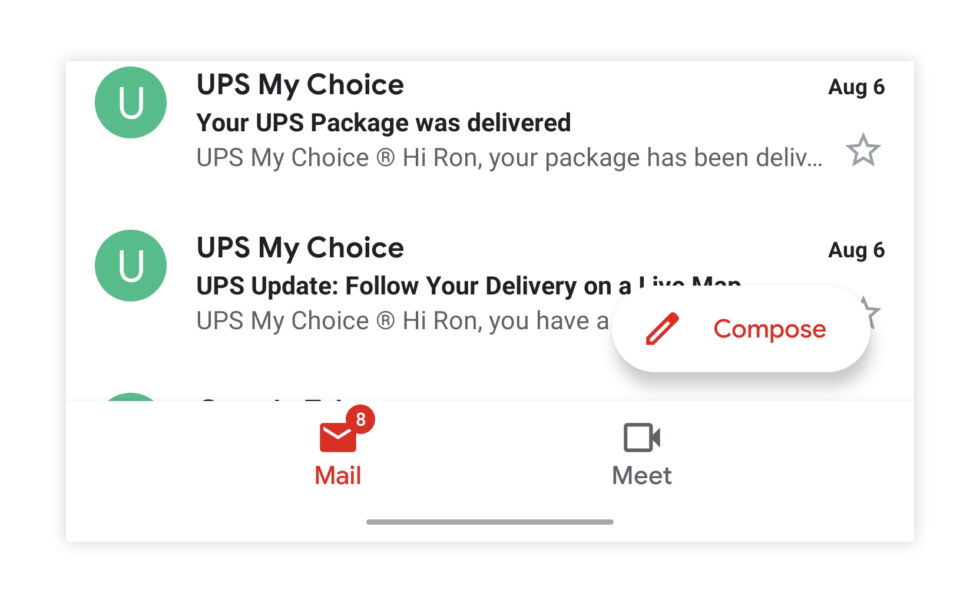 The Gmail app now features a Google Meet tab to try and juice usage.Ron Amadeo
The Gmail app now features a Google Meet tab to try and juice usage.Ron Amadeo Google Meet in desktop Gmail.Google
Google Meet in desktop Gmail.Google Google Meet in Google Docs.Google
Google Meet in Google Docs.Google
To try and catch up, Google is following the old Google+ playbook of "shove it into everything" and hope users will accept the service. The Gmail app now has a "Google Meet" (and "Google Chat") tab at the bottom for some inexplicable reason—it's basically an ad banner that you can thankfully turn off. The desktop Gmail site also has a Meet button in the sidebar and in the Google Chat widget.
At IO 2021, Google announced plans to stick Google Meet into Google Docs via a pop-up sidebar, like the way text chat works. Google Meet is a default app on Android and Chrome OS devices now and it (along with Zoom) got support on the Google Nest smart displays. In October 2020, Google even launched a Google Meet client for Google Glass Enterprise Edition. (Yes, despite the 2013-ish release and flop of the consumer edition, Google Glass still exists as a business device in 2021.)
Of course, Google Meet is also fully integrated into Google Chat, the companion chat service, but it was even back-ported into Google Hangouts, the 2013 chat service Google Chat is supposed to eventually, someday, maybe start replacing. Both have prominent "Start a meeting" buttons in the UI these days. Patching Google Meet, an enterprise video meeting solution, into Hangouts, a consumer chat service, is awfully strange. Generating a meeting link for friends and family to join, instead of the old Google Hangouts method of answering a ringing video call, is a lot more awkward in practice.
 Logitech's $5100 boardroom package for Google Meet.Google
Logitech's $5100 boardroom package for Google Meet.Google Logitech's example setup. Your world-domination meetings with Dr.Evil have never looked better.Google
Logitech's example setup. Your world-domination meetings with Dr.Evil have never looked better.Google A Google Meet Chromebase.Google
A Google Meet Chromebase.Google
Google even has companies make "Google Meet Hardware" now. There is a whole selection of enterprise-grade (that means "obscenely expensive") display, microphone, and camera packages for wiring up a boardroom with video conference capabilities. On the low-end, we've got the Asus Google Meet Starter Kit, which is $1750 and includes a 4K, wide-angle camera to capture the whole room, a combination speaker and microphone box that goes in the middle of the conference table, and (what is seemingly the core of all of these systems) the "Google Meet Compute System." That's essentially an Intel Core i7-powered Chromebox that gets you connected to Google Meet. On the high-end, there's the "Logitech Tap - Google Meet Large Room Bundle," which is $5100 and includes a 10.1-inch touchscreen, a camera, two speakers, a compute box, and two microphone pods for large table coverage. The camera is a swanky 4K pan/tilt/zoom unit that automatically targets and zooms in on the person it detects is talking.
There are also a few all-in-one displays, like the $1450 Acer Chromebase for Google Meet. And Meet is supported on the $5,000 Google Jamboard, a digital whiteboard for Google Docs.
I will give it to Google that (for now at least) Google Meet is well-maintained and constantly gets meaningful updates. There's screen sharing, broadcasted meetings that support 100,000 GSuite viewers, the ability to record a meeting to Google Drive, and real-time captions. The app works well and is easy to use, it was just late. The status quo had been established, so it will be hard to get people to switch from Zoom.
YouTube Messages (2017)—Yes, this was really a thing
Lifetime: August 7, 2017—September 18, 2019 (2 years, 1 month)
Clients: Android. iOS, the Web
 YouTube Messaging. It's not a meme, it's a real thing that existed for about two years.Google
YouTube Messaging. It's not a meme, it's a real thing that existed for about two years.Google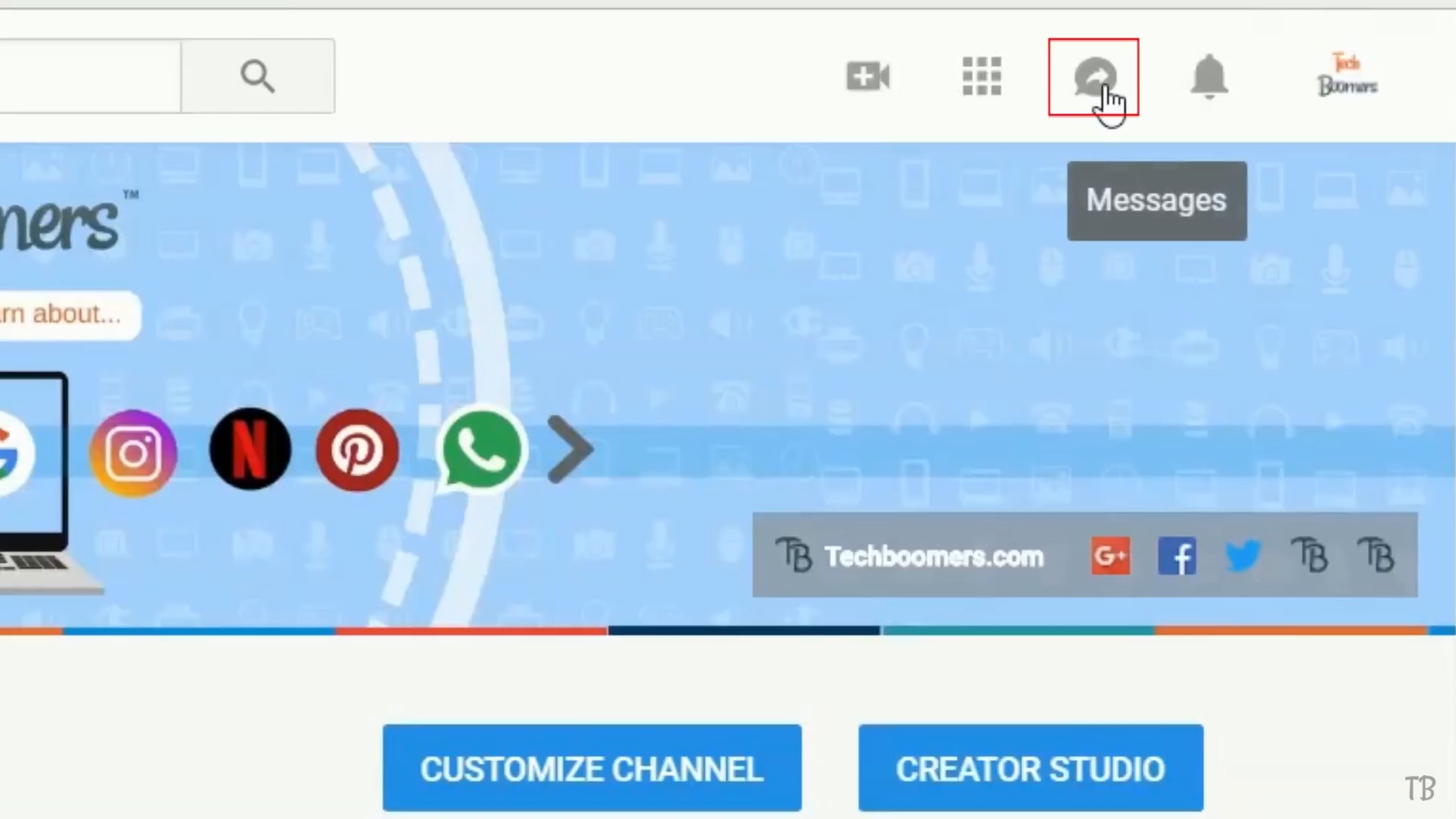 On the desktop site, there was a "Messages" button next to the usual bell and app buttons.
On the desktop site, there was a "Messages" button next to the usual bell and app buttons.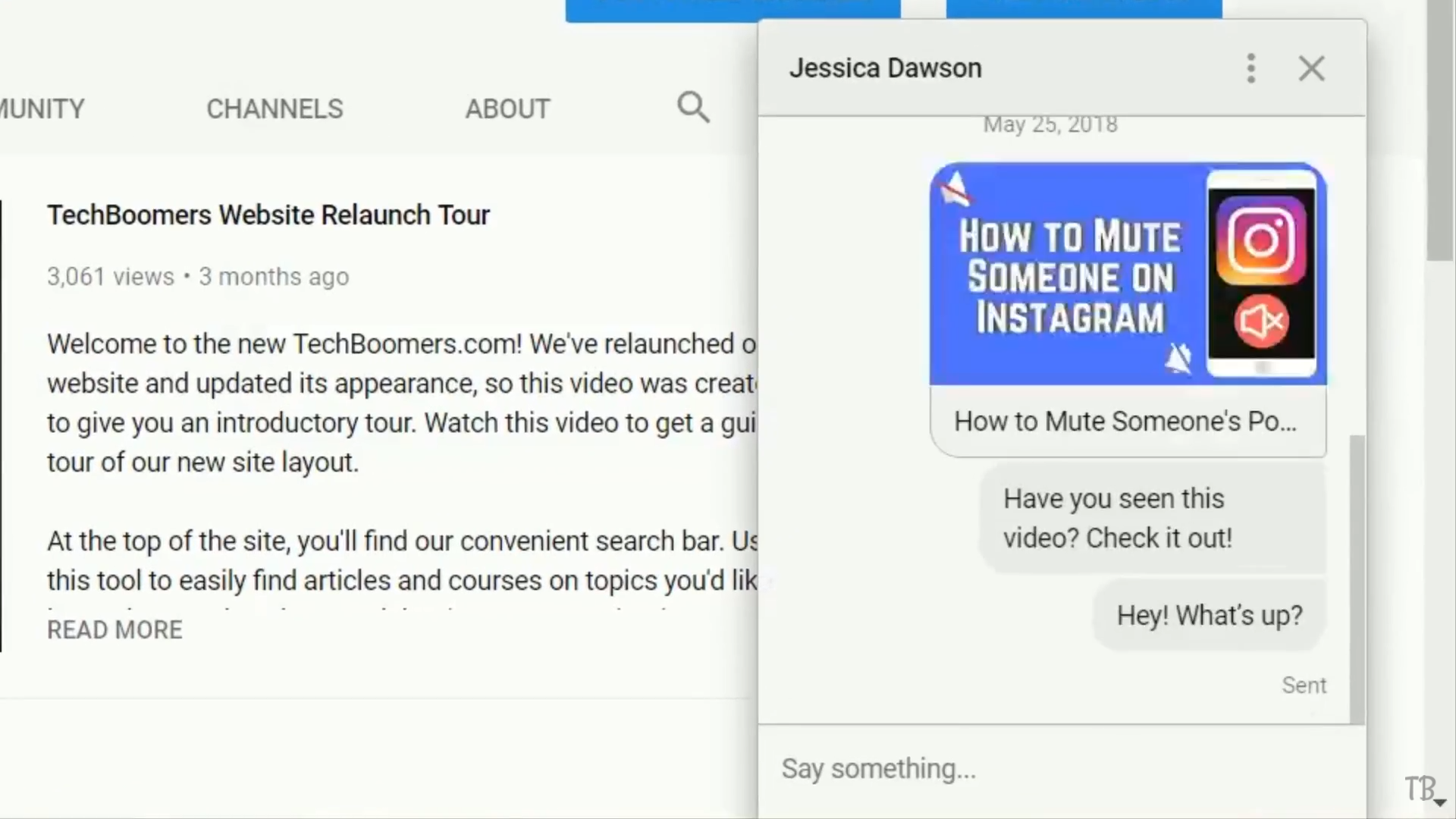 On desktop, the interface was a pop-up messaging window, just like Gmail and Google Docs.
On desktop, the interface was a pop-up messaging window, just like Gmail and Google Docs.
Google's inability to throw its weight behind a single messaging solution has a ripple effect across the company's whole ecosystem. Looking back at this point in 2017, we start to see a series of decisions from popular Google apps that all seem to follow the same rationale. They realize messaging is important and look like they would like to plug into a single competitive Google messaging app. But, lacking a stable messaging platform from the rest of Google or a top-down directive to be compatible with whatever the latest client is, these service teams end up building their own bespoke messaging service. These usually aren't standalone apps but are instead messaging features that are glommed onto random Google apps. They are very awkward since they are never compatible with anything else, and it's up to the users to manage a new, siloed list of contacts and message history. This is basically "The Google Docs Strategy."
The first Google app to strike out on its own in the quest for a viable messaging solution was YouTube, which, in 2017, launched a feature called—what else—YouTube Messages! I see a lot of people who try to "invent" this product as a joke, but it was a real thing that really existed for about two years, starting in 2017. The thought process here was pretty clear: YouTube probably gets a lot of referrals from "Hey did you see this?" messages between friends, so why not let people do that directly from the site?
On the mobile app, YouTube's messaging feature lived under a new "Shared" tab, which was given a premium slot in the bottom bar, next to "Home," "Trending," "Subscriptions," and "Library." The Shared tab was exactly a messaging app, showing a list of conversations you and your friends were having around videos, all inside the YouTube app. On desktop, a "Messages" button lived next to the bell and app buttons and would bring up a pop-up chat window, just like Google Docs and Gmail.
The YouTube Messages input box came with a little "+ video" button, so you could easily drop videos into your conversation. It looks like you could react to each message with a heart button (not the typical "Like" button?), too. Contacts for YouTube Messaging could be added through your phone's contact app or by just sending someone an "invitation link" through email or some other chat app.
When YouTube announced the messaging feature would be shut down after just two years of operation, it did not give a reason. One theory floated by TechCrunch is that YouTube messenger was inundated with children, who were using the messaging service to skirt parental controls that had been put in place blocking other messaging apps. YouTube is frequently used as a babysitter, so it's unblocked for kids, and the surprise addition of a messaging app gets to slip through the filter. Backing up this theory are the 1,400+ angry comments on the original shutdown announcement, full of all-caps messages, emojis, and various messages about how YouTube Messaging is "the only way for some people to talk to their friends." In 2019, YouTube was in the midst of a big controversy over pedophilia, and YouTube started doing things like shutting down comments on videos featuring minors. Someone at YouTube might have noticed the Messaging feature demographics and decided to give that the axe, too.
Google (Hangouts) Chat (2018)—Part 1: Cloning Slack is actually a good idea
Lifetime: February 28, 2018—Present
Platforms: Android, iOS, Web
Hangouts Chat was announced alongside Hangouts Meet in 2017, but it didn't leave a very limited early access program until February 28, 2018, when it became available exclusively to organizations paying for G Suite (G Suite is now called Google Workspace). Hangouts Chat has had one of the most turbulent rides of Google's products in its short four years on this Earth. In that time, it has undergone both a big rebranding and what seems like a major pivot in its target audience. Coupled with initial restrictive access requirements, it has been one of Google's hardest apps to nail down.
Hangouts Chat was announced as an "enterprise-focused communication tool," AKA a competitor to Slack. There aren't a lot of hands-on impressions from the early days of the app, since it was 1) invite-only, 2) locked behind the G Suite paywall, and 3) would need a corporation to subject its entire staff to an "early access" app. Nobody wanted to try this. Your best bet for an early look is this 9to5Google hands-on article from December 2018, a full nine months after the general G Suite launch. It's so plain and barren.
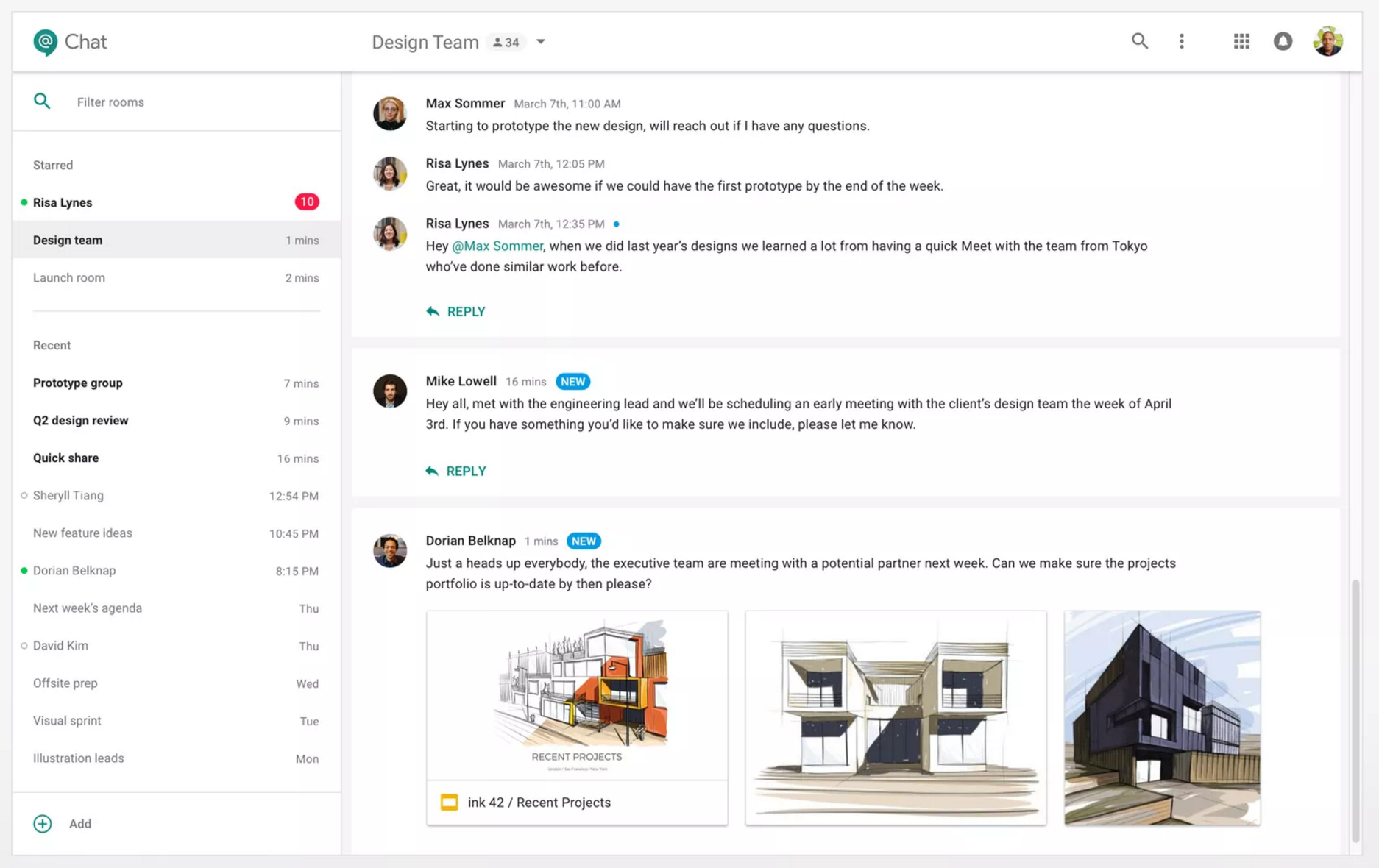 Hangouts Chat on the web.Google
Hangouts Chat on the web.Google Hangouts Chat on a phone.Google
Hangouts Chat on a phone.Google
The day-one features were support for rooms, DMs, treated messages, bots, and @mentions of usernames. The way Hangouts Chat treats threads is pretty different. Slack is presented as a normal chat room, and then you can reply to any individual message to start a thread. Hangouts Chat makes every message threaded, resulting in a kind of forum-style layout where every message must either be a reply or a new, top-level comment. There's not even a stationary text input box. There are "reply" input boxes at the bottom of every thread and a "new thread" button at the bottom of all that.
Just like Slack, Hangouts Chat supports several chatbots, letting you stream outside info into your chat room for things like Asana, Trello, Google Drive, and more. Hangouts Chat works on iOS, Android, and the web, and while there used to be Electron apps for Windows and Mac (just like Slack), today, desktop is handled by a Progressive Web App (PWA). Both Electron and PWAs present web apps as desktop apps, but Electron packs its own Chromium-based browser, while PWAs use the Chromium browser already on your computer.
I don't think the execution is there yet, even four years after it was first announced, but the basic idea of a Google version of Slack still sounds fantastic. It's not often that making an exact copy of a competitor results in a successful product, but here, I think a pixel-for-pixel copy of Slack would do well. Many organizations (Ars Technica included!) pay for both G Suite and Slack, and if a fully featured "Google Slack" was included in the G Suite price, I think a lot of organizations would switch just to cut down from two bills to one. It has been four years now, though, and Google (Hangouts) Chat still feels like an early access app—not a viable Slack replacement.
If you're wondering what's missing from Google Chat compared to Slack, Slack has an entire right-side panel you can set up with critical information, like a running list of your @mentions, a list of files in the chat, or pinned messages. Channels in Slack have topics, which are great for important notifications or getting everyone on a channel on the same page. There are keyword notifications that will ping you any time someone in chat mentions a certain topic, which is great for summoning the Android Defence Force (OK, that's really just me) in the Ars Technica Slack. If you want to see everything, bird's-eye views like "All unreads" or "All DMs" are for you, as these options will show everything in one big, scrollable list. There's not just a dark mode, there's a fully customizable theme system—just type in whatever hex codes you want. You can create and upload your own emoji, even animated ones (at Ars, we have 410 custom emojis and counting). Slack also supports multiple organization workspaces, so here it's possible to not just be in the Ars Technica Slack, with all the usual people, rooms, and emojis, but also the Conde Nast Slack, with a whole different set of people, rooms, and other settings. There are probably a million other things I'm forgetting about. Slack is a very mature app.
Google Chat is not even close to Slack, but Slack is nearly twice the age of Google Chat. Can Google Chat catch up? Right now it does not seem like Google is giving the app the focus or resources it needs to compete. In the same way that Facebook snapped up WhatsApp for $22 billion in 2014, in December 2020, Slack was acquired by Salesforce for an incredible $27.7 billion. Once again this deal shows that Google's competitors value a single messaging app to be worth tens of billions of dollars, while Google seems to value messaging at an order of magnitude less than that. Has Google ever invested even a fraction of Slack's price tag into a single app? Google Chat certainly doesn't seem like anywhere close to a $27 billion app.
We'll deal with Google Chat's big consumer pivot later on, but for now, it's on to the next project.
Google Maps Messages (2018)—Business messaging, now with the instability of Google
Lifetime: November 14, 2018—Present
Clients: Android, iOS
 Google Maps Messaging! This is the 2018 version, which means it's all part of the Google Maps app.Google
Google Maps Messaging! This is the 2018 version, which means it's all part of the Google Maps app.Google Messages used to have a top-tier spot in the navigation panel.Google
Messages used to have a top-tier spot in the navigation panel.Google In the current UI, Messages lives in the "Updates" tab.Ron Amadeo
In the current UI, Messages lives in the "Updates" tab.Ron Amadeo You used to be able to reply to Google Maps Messages with Google Allo.
You used to be able to reply to Google Maps Messages with Google Allo.
Customer service happens through Google Maps all the time. You look up a business on the site or app and have a question about what services they offer. Traditionally, you call them up. What if you could do that through instant messaging, though?
When, exactly, you want to start qualifying this as a "Google" messaging service is up for debate, but it definitely is today. Google officially launched a "Message" button in Maps in July 2017. At first, just as the "call" button would launch your phone app, the "Message" button would launch your SMS app. From there, you could text Google (not the business), which would forward the message on to the business.
In this first version, businesses could sign up for Google's messaging support one of two ways. First, just give Google an SMS number, and the company could forward all your messages to that number, where you could easily reply. The second option, hilariously, was to receive messages through Google Allo! At this point, the Allo app was about one year into its two-year lifetime, and it apparently powered this feature on Google's back end. Oh no.
For consumers, the entire way this "Message" button worked was changed in November 2018, when Google Maps got a full-blown messaging UI. Instead of firing up an SMS app, Google Maps got its own in-house version of the ubiquitous bubble-powered message UI. It also got a message inbox, where you could see all of the messages you've ever sent (but, to businesses), just like every other messaging app on Earth. At launch, the message inbox got a premium spot in the slide-out navigation panel, where "Messages" lived right between "Your contributions" (reviews and photos) and "Location Sharing." Today the slide-out navigation panel is dead, and in the new bottom tab UI, the Messages inbox is in the "Updates" tab.
With the death of Allo, the back-end of this had to change for businesses, and in 2019 Google's solution was to bring the entire messaging system in-house. Allo was, of course, removed as an option to receive customer messages, but so was SMS. Now, businesses have to use the "Google My Business" app for iOS or Android to reply to customers, making Maps Messaging a truly independent Google Messaging Service. For businesses that (understandably) don't want to communicate to the entire world through a phone, there's also the Google Business Messages API, a REST API that allows larger companies to plug the system into some kind of customer management app.
All of this messaging stuff is only on the Google Maps app, by the way. You can't message businesses from the Google Maps website. This made total sense in 2017 when the feature opened up your phone's SMS app—but most desktops don't have an SMS app. Now that the entire end-to-end messaging system is a web-based Google service, though, there is no reason you can't do it from maps.google.com. When will we get yet another Google website with a pop-up chat window?
This entire section is pretty much Google copying Facebook's business messaging feature, which it has on Facebook Business pages. You know what Facebook business messages use, though? Facebook Messenger! Things are so simple when you have a stable messaging platform.
Google & RCS (2019)—So we found this dusty old messaging standard in a closet...
Lifetime: July 2019—Present
Platforms: Android, Phone-based web interface
 Google Messages on a phone.Google
Google Messages on a phone.Google Google Messages on a browser.
Google Messages on a browser.
When Google announced it was "pausing" Allo development in 2018, it also announced it had found a hot new fling: Rich Communication Service, or RCS Messaging. RCS was cooked up by the GSM Association in 2008 as an upgrade to SMS. It adds a few really basic features to carrier messaging, like user presence, typing status, read receipts, and location sharing. The way RCS is supposed to work is that Verizon, AT&T, T-Mobile, and all the other carriers upgrade from SMS to RCS, and then all the texting apps on the network get to talk to each other. If you can't tell from the standard's 13-year-old origins, the rollout of RCS is best mapped out on a geologic time scale, with carriers occasionally paying lip service to upgrading SMS but doing very little in terms of actual action.
Google calls its RCS rollout "Chat," which is extremely confusing given that there is already a "Google Chat" product that we covered earlier. The Google Chat and Google RCS Chat are not in any way related or compatible. Google's client of choice for its RCS solution is Google Messages, aka Android's stock SMS app. The lineage of the Google Messages app dates back to the Android 5.0 Lollipop days in 2014. A year before, Google went "full iMessage" and killed the Android SMS app in favor of Google Hangouts SMS compatibility. Carriers didn't like that, and Google quickly caved by building a "Messenger" SMS app for Android 5.0. Being around for seven years means the Google Messenger app is mature and fully featured—for an SMS app. The app features Google's smart reply buttons, a very modern UI, and even a web interface for desktops, which forwards messages from your phone to the website through a QR-Code pairing process. There's also a "video call" button that connects people through Duo if you both have the app installed.
Google's fascination with RCS started in 2015 when it acquired Jibe Mobile, a back-end RCS company that was focused on selling RCS server solutions to carriers. With Jibe, Google could offer a full end-to-end RCS solution to carriers: the back-end server solutions from Jibe, and the front-end client work with Android. The carriers, already weary of how much power Google had over them with Android, opted not to turn over their entire messaging stack to Google, and pretty much nothing happened for four years. With the 2018 shutdown of Allo, Google announced it was moving some of the team over to Google Messages, with a renewed focus on RCS.
In October 2019, Verizon, AT&T, T-Mobile, and Sprint all responded by snubbing Google and launching their own RCS alliance, the "Cross Carrier Messaging Initiative (CCMI)." The carriers talked a big talk saying they would build a "standards-based, interoperable messaging service" and promised adopting 2008-era messaging features that would deliver "the next generation of messaging." The 2020 launch deadline flew by with nothing to show for it, and the whole initiative shut down in 2021 having accomplished absolutely nothing over two years.
The CCMI announcement pushed Google to counter with its own announcement: that it was giving up on carriers and would roll out its own RCS system using the Google Messages app. Not teaming up with the carriers would mean that its RCS solution would exist alongside SMS, and Google would push users to turn on "Chat features" with a pop-up in Google Messages. This was basically turning RCS, a carrier-made messaging standard, into an over-the-top messaging service. Google first rolled out this system in the UK and France in July 2019, and as of November 2020, it's available globally.
After the failure of CCMI, the three US carriers (RIP Sprint) have actually given in to Google's RCS ambitions. T-Mobile, AT&T, and Verizon are all shipping Google Messages by default on Android. But critically, Apple is anti-RCS.
RCS is bad, and anyone who likes it should feel bad
Like Allo, RCS Messaging is another plan that doesn't make a ton of sense on paper. RCS is a carrier-controlled messaging standard, and therefore not something Google has a ton of control over. Adding a feature to RCS means getting the entire carrier bureaucracy involved with debating and ratifying the new change. There is no way you can move fast enough to compete with an over-the-top messaging service controlled by a single entity. RCS might be better than SMS, but it will never be good.
RCS has a ton of downsides compared to a real messaging service, but that's all supposed to be a worthy trade for one benefit: RCS is supposed to replace SMS, so it's supposed to be universally available on all devices. Will that ever happen, though?
Apple does not want good messaging compatibility with Android. The company said as much in internal communication that was made public thanks to the Epic Games case. Apple's internal debate showed it viewed iMessage's high-quality iPhone-to-iPhone communication as "serious lock-in" and a feature that kept users on iOS. Following this same logic, Apple doesn't want RCS because that would make messaging with Android easier. In Apple's view, easier communication with Android users would only help those users leave iOS.
Even if you could snap your fingers and magically roll out RCS to every device, you wouldn't actually create a competitive messaging solution. Being a standard created in 2008 means RCS has standards from 2008, and it's lacking things you would want from a modern messaging service, like end-to-end encryption. The Google Messenger strategy strangely insists on using RCS as the base protocol, but the service also keeps trying to build features on top of it that kick in when both users are on Google Messages.
Today, if both users are using Google Messenger, you can have all sorts of interesting features, like end-to-end encryption for 1-1 chats, reaction emojis, and audio messages, which aren't in the RCS spec. That makes it seem like Google is almost building its own messaging service, but with really unclear compatibility and an ancient RCS protocol, which it has no control over, as the core. What is the point of this? It's hard to see carriers shipping Google Messages as a default Android app as progress. Google can easily make any app it wants an Android default. Google Talk and Google Hangouts enjoyed default-install status for years. They shipped on every single Android phone, not just the ones from US carriers. These services were also optionally available on iOS, while RCS is not.
RCS also has all the same problems as SMS and Google Allo when it comes to how you should architect a messaging service. RCS will use your carrier-owned phone number as your identity online, instead of an Internet-based account system. Changing Internet identity from a free email account to a paid number owned by a carrier is a terrible and, I would argue, immoral idea. Tying online identity to the ability to continuously pay a phone bill is straight-up discriminatory toward people of lower income. There should not be a risk of losing your online identity if you stop paying your bill for a month or change phone carriers. There's no upside to phone number identity at all, yet Google keeps doing it.
Carrier-owned identity means your messaging world will be dependent on your smartphone and tied to a single device, instead of being a service that just lives on the Internet and is accessible everywhere. It makes support for multiple devices and form factors difficult. Google does have a Google Messages "website," but it's not a web service—instead it is just a forwarding interface for your phone, which has to be charged up, turned on, and paired to the site. Like with Allo, a QR code scanned by your phone will set up a hacky message-forwarding solution that isn't as convenient or capable as a native web service. Google is also working on a "device pairing" feature to ship your SMS/RCS messages to a tablet over what I assume is local networking with your phone. It all just seems like a janky, backward solution compared to simply using a web service. As a phone app, Google Messages isn't bad, but it has zero independent clients for non-phone form factors.
Google's RCS plans seem like a disaster. Even if it worked and universally replaced SMS, you'd end up with a bottom-tier messaging service. It's not even going to work, though.
Google Photos Messages (2019)—You get a messaging feature! And YOU! And you!
Lifetime: December 3, 2019—Present
Platforms: Android, iOS, the Web
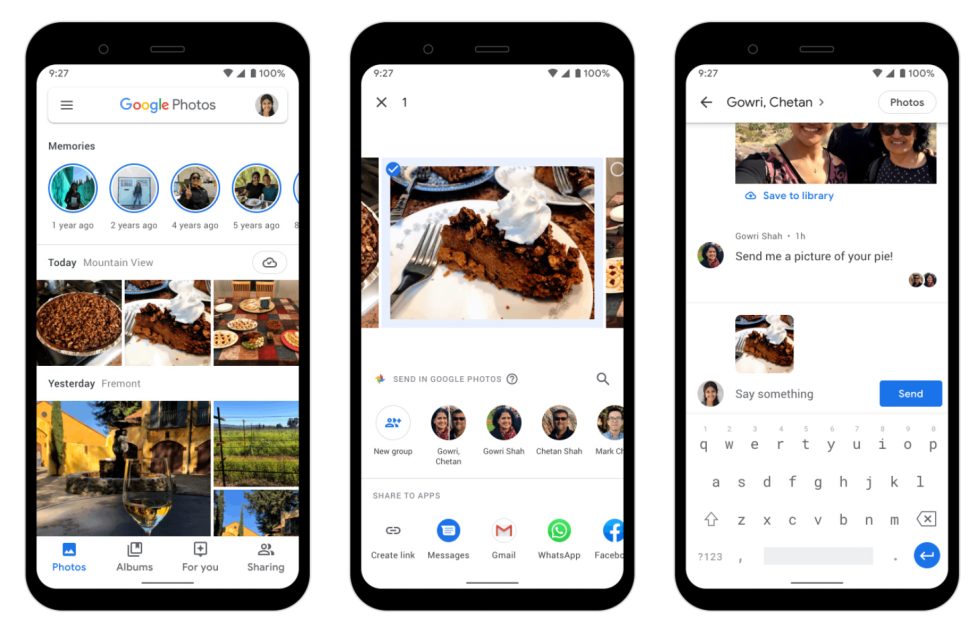
Who's starting to see a pattern? With no viable Google messaging platform, I feel like Google just opened the "top apps" listings and started slapping a messaging feature onto every popular Google service. How soon until we get "Google Search Messaging?" Hahaha. (Actual answer: May 6, 2021.)
Think about how Facebook works. You upload a cool photo and want to tell your friends so you can post it on your social media feed or message your friends through Facebook Messenger. Easy! This was the original vision for Google Photos, which launched alongside Google+. After the amputation of Google+, it's now up to Google Photos to try to graft on some of these social features itself. So, in December 2019, Google Photos got a messaging service.
Google Photos Messaging is pretty standard. You can start a group chat thread via the photo "share" button, where you can send a link or directly message someone else on Google Photos. The "Sharing" tab at the bottom of the screen is your message inbox, and you can view and reply to any existing chat threads. Photos will send you notifications when new messages come in. This is all supported on the website, too. Would you believe it supports sending pictures?
Google Stadia Messages (2020)—Two great tastes that taste great together
Lifetime: November 16, 2020—Present
Platforms: Android, iOS, the Web
 Left: The Stadia home screen. Everything is on sale! Please buy something. Please? Right: The good stuff—the messaging section.Ron Amadeo
Left: The Stadia home screen. Everything is on sale! Please buy something. Please? Right: The good stuff—the messaging section.Ron Amadeo Yep, it's a messaging app.Ron Amadeo
Yep, it's a messaging app.Ron Amadeo It also works on desktop.Ron Amadeo
It also works on desktop.Ron Amadeo
Easily the most doomed section of this entire article, even Google Stadia has a messaging service. Google Stadia is (or "was," depending on when you're reading this article) a game-streaming service from Google. Instead of going out and buying a game console, you can stream a video game over the Internet, one frame at a time, from Google's computerized warehouses to your various devices. After all that time running YouTube, the technology behind Stadia is solid and works fine, provided you have great Internet latency.
Google's poor execution of Stadia seems like it's leading to an inevitable execution of Stadia, though. The payment model is totally crazy. Rather than just being "Netflix for games," Stadia asks users to buy games at full price, and then you can only play them at 1080p unless you pay another $10-a-month subscription fee to unlock 4K mode. Given Google's history (see: this entire article you're reading), a lot of people are hesitant to pay full price for a Google gaming service where the games might disappear any month now.
Despite being a warehouse-scale computer capable of being far more powerful than your average PC, the cloud computers you're renting from Google aren't even particularly good. Games like Destiny 2 can only run on the PC equivalent of "medium" settings, and some of those 4K games you're paying $10-a-month extra for aren't actually in 4K—they are upscaled to 4K because Stadia is too slow to run them in native 4K. Google is currently facing a lawsuit over false "4K" advertising. Google refuses to lean into the good parts of game-streaming technology, which is that a warehouse-scale computer could be way faster than any local computer you could possibly build, if Google would just allocate the resources for it. This is the traditional sales pitch behind cloud computing, after all. Cloud games also have an instant start-up time with no install, which would make them great for game demos.Couple those issues with Google's shaky history of keeping services running, and Stadia seems doomed. The dominoes are already falling, in fact. User signups were reportedly "hundreds of thousands" short of what Google was expecting, and the company closed its in-house development studio before it had time to develop a single game. Stadia's VP and head of product quit, then the head of engineering quit. It seems like it's only a matter of time before it's game over for Stadia.
Wait, what were we talking about? Oh yeah, Stadia has a totally siloed messaging service. The feature rolled out in November 2020, about one year after Stadia's incredibly bare-bones and underwhelming launch. It seems pretty normal. You can find people by their email address or Stadia gamer tag, provided that their profile is set up to be publicly searchable. It really seems like Stadia should plug into something for contacts, but it can't even scan your phone contact list, Gmail, or a messaging app to find Stadia players you already know. Instead, you've just got to type everything in manually. The truth is, you probably don't know any Stadia players, but it would be nice to scan your contacts so you could message 'em.
Google Pay Messages (2021)—We actually learned nothing from Google Allo
Lifetime: March 4, 2021—Present
Platforms: Android, iOS
 New Google Pay has a messaging feature!Ron Amadeo
New Google Pay has a messaging feature!Ron Amadeo Here is what the actual app looks like, if you're wondering.Ron Amadeo
Here is what the actual app looks like, if you're wondering.Ron Amadeo Oh no, not this again. Google Pay requires you to sign up with your carrier SMS number.Ron Amadeo
Oh no, not this again. Google Pay requires you to sign up with your carrier SMS number.Ron Amadeo The website is dying because websites don't have SIM cards.Ron Amadeo
The website is dying because websites don't have SIM cards.Ron Amadeo
In 2021, Google completely re-launched Google Pay. It threw out the old codebase that had previously existed first as Google Wallet, then Android Pay, then Google Pay, and the company instead rolled out a completely different "Google Pay" product it had developed in India. This product was originally called "Google Tez." Users making the transition lost their contact list and a lot of functionality, so we basically saw the shutdown of one service called "Google Pay" and the launch of a completely separate, new service, also called "Google Pay."
Just like Google Allo, which was also targeted at India initially, the new Google Pay uses your cell carrier's phone number for your identity, which causes a whole bunch of problems. It takes what used to be a modern, Internet-based account system and throws it out in favor of tying your identity to your phone number, which you don't control and is tied to your ability to pay a monthly bill. Old Google Pay could be accessed from anywhere you had an Internet connection, but carrier identity systems mean that now, you can only use your smartphone to access the service. As a result, the Google Pay website had to have all the functionality stripped out of it. Carrier-based identity systems might make sense in places where people only have a smartphone, but in the US, it's very limiting. There's also no clear upside that I can see. Why not just use a Google account like normal? People who want to use a Google product have a Google account. People who don't have Google accounts at this point are generally boycotting the entire company.Google Pay has long had the ability to send money to a friend or contact, and New Google Pay added—you guessed it—messaging! Existing users of old Google Pay had a list of contacts, but with the move to the new Google Pay, all your new contacts have to re-signup for the service again (because New Google Pay is a totally different service from old Google Pay, sigh). Provided you have such friends who made new accounts, you can add them to your Google Pay contacts, and then you'll see three options: "Pay," "Request," and "Message."
Payments are built into a lot of other messaging services, like WhatsApp, Facebook Messenger, and iMessage. Like Google Photos, the plan here is to try to replicate that by glomming a basic messaging service onto Google's existing product. In reality, this decision just further fragments users across a million different Google messaging apps and features.
Google Assistant Messages (2021)—Text and voice chat, for families?
Lifetime: May 6, 2021—Present
Platforms: Android, iOS, smart displays
 Receiving a Google Assistant Broadcast on a phone. On the left is a notification. On the right is an individual message.Google
Receiving a Google Assistant Broadcast on a phone. On the left is a notification. On the right is an individual message.Google Like on any other messaging service, you can have a whole conversation (left). You can reply by voice or keyboard (right).Google
Like on any other messaging service, you can have a whole conversation (left). You can reply by voice or keyboard (right).Google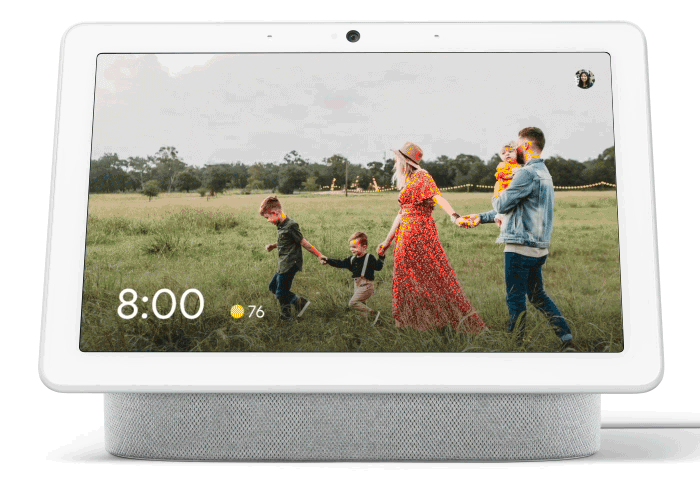 Smart displays will show the message and play audio. Speakers will just play audio.Google
Smart displays will show the message and play audio. Speakers will just play audio.Google
It's amazing we don't get more variety in messaging services given the sheer number of them that Google has launched. But finally, here's something different: a voice-first messaging system. The Google Assistant has long had a feature called "Broadcast," which would blast out a message to every device on the same Wi-Fi network, making it sort of like an intercom system for your Google Nest speakers and smart displays.
In May 2021, Google expanded the Assistant's Broadcast to work on phones, even when they're not on your home network. You don't always want to scream into your phone in public, and you don't want to blast a broadcast message out of the speakers, so the new interface includes transcriptions of all the incoming voice messages plus a text input field. The interface for this is absolutely a messaging app with a play button below each text message for playback of any audio. At home on a Google smart speaker, a voice can read out any messages you send.
On Android, the Google Assistant is built into the Google Search app, so if anyone is making a "Google Search Messaging" joke, that already exists! On iOS, messages arrive through a dedicated Google Assistant app. The one big limitation of this messaging service is that it's for family members only, meaning people you have in your Google Family Group. It's like a messaging app for a single "Family" group chat.
Google Phone Messaging (2021)—Isn't this going a little too far?
Lifetime: June 2021—Present
Platforms: Android
 The phone app has a "Chat" button for some businesses and its own chat interface.
The phone app has a "Chat" button for some businesses and its own chat interface. This shows the "chat" button doesn't kick you out to the Messages app but instead launches an interface from Google Play Services.
This shows the "chat" button doesn't kick you out to the Messages app but instead launches an interface from Google Play Services.
Every phone has two pretty basic apps: the phone app for phone calls and a messaging app for text messages. For a long time, Google has had an option in the phone app dialer to "Send a message," which would forward the typed-in number to your default messaging app. This is fine and normally wouldn't count for our purposes.
Recently, though, Android Police spotted some versions of the phone app that, for some businesses, will show a "Chat" button next to the "Call" button after you've typed in a number. Instead of launching a separate messaging app, this would launch a totally new messaging interface, which the "recent apps" screen identifies as part of Google Play Services. Presumably, this is based on the same kind of business messaging as Google Maps but with a whole new Google Phone client, for some reason. I know better than to ask for messaging unity at this point. Unity is for wimps!
Google Chat, Part 2 (2021)—No wait, this is actually a consumer app now!
Lifetime: June 14, 2021—Present
Platforms: Android, iOS, web, Gmail
We made it—meet the last messaging app on our list. The future of Google Messaging, for now, is Google Chat. We're cheating a bit by giving Google Chat a second section, but that's really what it feels like—a complete reboot and pivot of an existing project.
When Google Hangouts Chat was first announced, it was basically pitched as Google's Slack competitor. Google's 2017 blog post called the service "a communication tool focused on the way teams work" that was "purpose-built" to "help employees succeed." Suddenly, at the end of 2018, Google started talking about Hangouts Chat as if it was a consumer chat app.
When I say "suddenly," I mean it. Google Chat for consumers got what has to be one of the worst product announcements of all time: it was unveiled in an angry Twitter thread from Hangouts project lead Scott Johnston. Johnston took issue with a 9to5Google report that claimed that Google was shutting down Google Hangouts (the 2013 app), calling it "shoddy reporting" because it "is only half the story." Johnston then dumped the other half out on Twitter: Hangouts, which Johnston was now calling "Hangouts Classic," would be transitioned to Google Chat, the enterprise communication app. What in the world?Google Chat started life as "Google Hangouts Chat." So looking back, it might seem like porting over Hangouts users was the plan all along, but that definitely was not communicated by Google. Google Hangouts Chat was an enterprise app that you needed to pay for, and Hangouts was a free consumer chat app. Since this would be the third time a mostly unrelated service was called "Hangouts," everyone mostly just rolled their eyes and laughed at Google's terrible branding. It was unthinkable that the two would merge. It didn't make any sense.
Three days later, Google got its act together and put out a formal blog post. The post confirmed 9to5's report that Google Hangouts was shutting down, and it laid out a questionable transition plan, saying, "[Google] Chat and Meet are primarily focused on team collaboration for G Suite customers and at some point will be made available for existing Hangouts users, too." So Google Chat is still an enterprise Slack competitor, but you're going to push your consumer user base over to it anyway? What sense does that make?
Google Hangouts represents Google's biggest consumer messaging userbase because it has been around forever. While Google messaging apps have grown and been cut down like so many blades of grass over the years, the one throughline is Google Talk users, who were more or less smoothly transitioned from Talk to Google Hangouts. They've been clinging onto Google's wobbly messaging platform for 16 years. It sounds like somebody at Google realized they should do something with these users, and all of a sudden, enterprise Google Chat was drafted as the next app they would be pushed over to.
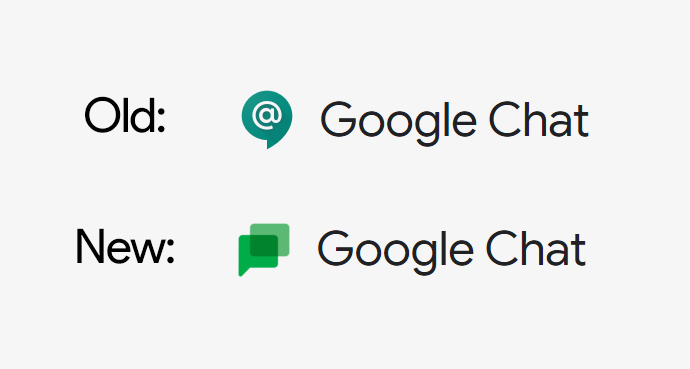 There's a new logo now.
There's a new logo now. The Google Chat Android app. This is the "Chat" tab. There's also a "Rooms" (group chat) tab.Ron Amadeo
The Google Chat Android app. This is the "Chat" tab. There's also a "Rooms" (group chat) tab.Ron Amadeo This is the Gmail Android app, which also has bottom tabs for Google Chat and Google Chat rooms, assuming you don't turn it off.Ron Amadeo
This is the Gmail Android app, which also has bottom tabs for Google Chat and Google Chat rooms, assuming you don't turn it off.Ron Amadeo The iOS version looks almost identical.Google
The iOS version looks almost identical.Google Too many clients? If you have Gmail and Google Chat apps installed, you'll get duplicate notifications, and this message will pop up. Why does it recommend you keep Gmail and not the main Google chat app, though?Ron Amadeo
Too many clients? If you have Gmail and Google Chat apps installed, you'll get duplicate notifications, and this message will pop up. Why does it recommend you keep Gmail and not the main Google chat app, though?Ron Amadeo Click on settings and then your email account, uncheck these two boxes, and all the Gmail tabs will be gone.Ron Amadeo
Click on settings and then your email account, uncheck these two boxes, and all the Gmail tabs will be gone.Ron Amadeo Setting status on a desktop.Ron Amadeo
Setting status on a desktop.Ron Amadeo You can search for chats! There are a whole bunch of search modifiers, too, like rooms, date ranges, attachments, authors, mentions, and links.Ron Amadeo
You can search for chats! There are a whole bunch of search modifiers, too, like rooms, date ranges, attachments, authors, mentions, and links.Ron Amadeo Room chats get a tab bar at the top, showing chats, files, and tasks.Ron Amadeo
Room chats get a tab bar at the top, showing chats, files, and tasks.Ron Amadeo
Starting in late 2020, Google Chat started opening up to free consumer accounts, instead of via the exclusive paywalled Google Workspace. At the time of writing, we're firmly in the transition period between Google Chat and Google Hangouts. Unlike some of Google's more calamitous user transitions lately—like moving from old Google Pay to new Google Pay, or from Google Play Music to YouTube Music—it looks like the transition from Google Hangouts to Google Chat will not be a disaster.
Currently, you can use both Hangouts and Google Chat, and your messages and contacts will show up in both apps. Google Chat mostly works and is fully functional, with support for image uploads, group chat, and most other things you could want. Hangouts users are getting gently pushed to Google Chat with a few pop-up messages that have started showing up in the UI. The interface is mostly a drop-in replacement for Google Hangouts, with a lot of the same features just in a more modern client. Google Chat adds @mentions—which are great for group chats—along with emoji reactions to messages and AI-generated smart replies.The main oddity is Google Chat's insistence on treating group chat rooms like some separate form of communication instead of listing them alongside your other chats. The interface is awkwardly split up into "Chat" and "Rooms" on the web, and these are in different panels. In the phone app, however, they are on totally different screens thanks to the tab interface. It makes chat rooms a pain to use. Another major problem with chat rooms is that they don't show a preview for the last message in the message list, so they're very hard to keep up with.
Google Chat's "Rooms" and "Chat" break down is just like Slack's Channels and DMs, but the difference is that Slack is an organization-wide app, so this breakdown makes a bit more sense. There are channels and people I don't interact with, but they need to exist for other people. My list of contacts and rooms in Google Chat is personal and a lot smaller than Slack, so just putting everything in a flat list would be a lot easier. Slack also lets you star channels and contacts, giving you a flat list of people and group chats you frequently use all on the same screen. That basic functionality is all I want.
 Gmail now has this crazy split-screen interface. If you open a group chat and click on the "open in chat" button, you'll get chat and a Google doc side by side in Gmail.
Gmail now has this crazy split-screen interface. If you open a group chat and click on the "open in chat" button, you'll get chat and a Google doc side by side in Gmail. Given that Google calls the split-screen view "open in chat," it means Google Chat takes over most of the gmail.com interface and Google Docs runs inside Google Chat.
Given that Google calls the split-screen view "open in chat," it means Google Chat takes over most of the gmail.com interface and Google Docs runs inside Google Chat. So what are you supposed to use this for? Google's demo image shows a family eagerly debating a family reunion schedule spreadsheet over group chat. Right...Google
So what are you supposed to use this for? Google's demo image shows a family eagerly debating a family reunion schedule spreadsheet over group chat. Right...Google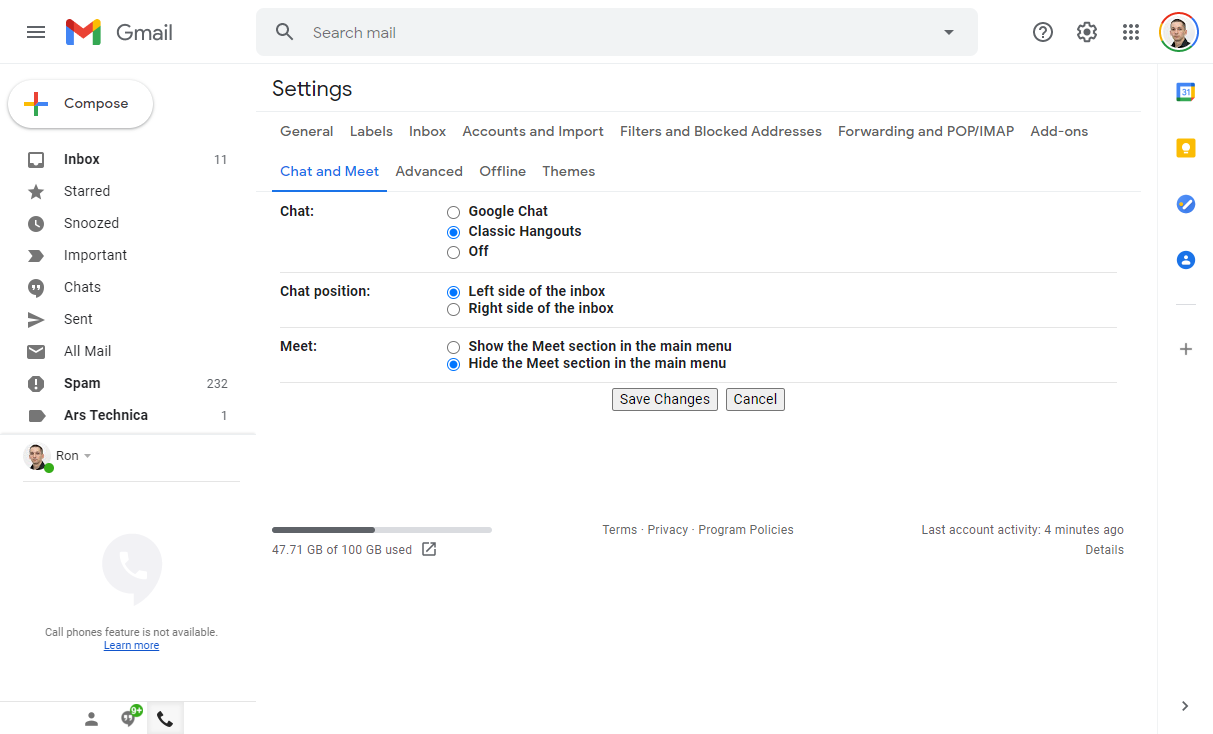 If you hate Google Chat in Gmail, you can turn it off from Settings -> "Chat and Meet."
If you hate Google Chat in Gmail, you can turn it off from Settings -> "Chat and Meet." Even outside of the split-screen interface, Google Chat is everywhere in Gmail.Ron Amadeo
Even outside of the split-screen interface, Google Chat is everywhere in Gmail.Ron Amadeo Here's the web app at chat.google.com.Ron Amadeo
Here's the web app at chat.google.com.Ron Amadeo
Google Chat is from the Google Workspace team, which also controls Gmail, so Chat is getting deep Gmail integration in an attempt to put the service in the face of as many users as possible. Google Talk and Hangouts have previously been built into gmail.com, just never like this. Google Chat basically gets free run of the place, with two sidebar sections, a pop-up, a status selector in the top-right corner, and a crazy split-screen interface that puts Google Chat on the left side of the screen and Google Docs on the other.
Google Chat also took the unprecedented move of being integrated into the Gmail smartphone app, which I guess is like the modern equivalent of being built into Gmail.com. With Google Chat, the Gmail app has a new tab bar at the bottom that can jump into interfaces for Meet or Chat, and Chat is fully functional with notifications, contacts, and everything else you'd want from a messaging app. You don't need to have the Google Chat app installed at all, provided you have the Gmail app.
If you have Gmail and Google Chat installed, you'll be notified twice of any incoming messages, and Gmail actually has a pop-up pointing this out. The pop-up recommends that you turn off notifications for the standalone Google Chat app and exclusively use Gmail for your Google Chatting, which really goes against the normal smartphone interface of individual app icons.
The big thing Google Chat has going for it is that, as a primarily enterprise app within Google Workspace, it has an actual monetization plan. Fifteen years ago, Google Talk stripped the banner ads out of the standard instant messenger interface, and this is the first time since that Google has come up with a monetization replacement plan. Companies pay for Google Workspace, and presumably, some of that Workspace money is being attributed to Google Chat. Will this be enough to keep the project going and finally provide some stability to Google Messaging?
Is anyone in charge at Google?
Even with all this shoddy history, Google doesn't seem to have learned anything. Today, the confusing, intimidating pile of Google Messaging services is bigger than it has ever been, with Google Chat, Google Messages/RCS, Google Voice/Project Fi, and separate messaging services in Photos, Messages, Pay, Assistant, Stadia, Maps, and Phone. If you're really an expert, you can probably narrow this list down somewhat, but Google is still simultaneously pushing the enterprise-first-but-also-consumer-messaging app, Google Chat, while also duplicating efforts and muddying its sales pitch to users with RCS on Google Messages. Which services does Google really care about? Which one is the future of the company? It's hard to say.
The overwhelming impression from Google's continual messaging chaos is that nobody at the company is really in charge. Some products at Google get mandatory support and hiring (like the advertising division), but others, like messaging, rely on the enthusiasm and availability of individual employees to be continually supported and stay running. Google has previously defended this hands-off management style as "letting a thousand flowers bloom," but the company's messaging situation is more like a yard full of weeds—neglected, embarrassing, and damaging to the company's reputation.
Apple calls messaging the "most important apps in a mobile environment." Facebook and Salesforce invest tens of billions of dollars into messaging, making acquisitions of WhatsApp and Slack some of the biggest deals in the tech industry, ever. Google, on the other hand, can't be bothered to hold down a stable messaging project. It's really incredible how out of step Google's thinking is with its competitors.
If Google treated messaging like most of its competitors do, there would be a top-down mandate that messaging be a pillar of the company alongside Search, Gmail, Chrome, Android, Google Docs, Maps, and YouTube. The messaging strategy wouldn't change every two years, and Google might actually have a chance to grow a messaging user base. The person that is supposed to be implementing some kind of strategy is Google CEO Sundar Pichai, but his timid management style means nobody is directing Google employees to put in the hard work of building and maintaining a messaging platform. Instead, individual groups at the company are free to fire off half-baked products into the public, and these releases get outsized attention, media coverage, and initial traction thanks to the "Google" name. From there, they damage trust in the Google brand when services are shut down.
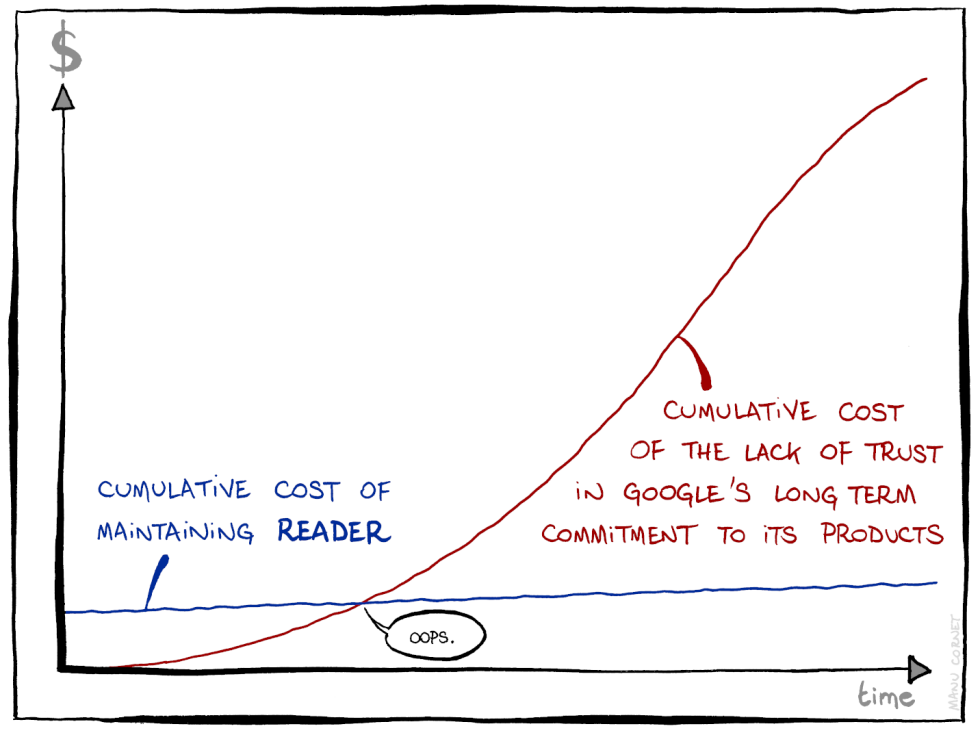
I've written before about how Google's constant product shutdowns damage the brand, and messaging apps are one of the biggest contributors to the growing Google graveyard. Switching to a messaging app requires a big commitment, with the need to get friends and family to switch. Like any social app, messaging apps are dependent on the network effect, and shutting them down every two years is a great way to sabotage any possible user adoption.
Being kicked off a service has a lasting effect on a user. Google treats shutdowns like they are no big deal, but it's more like burning a bridge with everyone on it who used the service. I think it's part of the reason public perception of Google has changed over the years. There used to be a lot more Google fans out there—people were optimistic about Google and eager to try any new Google products. If Google managed its products well, today these people might be vocal product advocates, similar to the support companies like Apple or Tesla enjoy. Instead, being a Google enthusiast over the years has meant getting hit frequently by Google shutdowns. Today, I don't think there are many Google advocates left, and it's hard to be optimistic about any new product launch.The Google Talk saga is a case in point. It feels like it's for a company that doesn't exist today. When Google Talk launched, there was an assumption that Google would dominate messaging, because back then, Google was seen as a disrupter and a company that put effort behind the new markets it entered. Today, no one assumes Google will be successful in a new market. And it's because of what we outlined here, a list of so many low-effort projects.
https://ift.tt/3zgbq8c
Technology
Bagikan Berita Ini














0 Response to "A decade and a half of instability: The history of Google messaging apps - Ars Technica"
Post a Comment